Word Forms and Simple Present Tense
Course Certificate
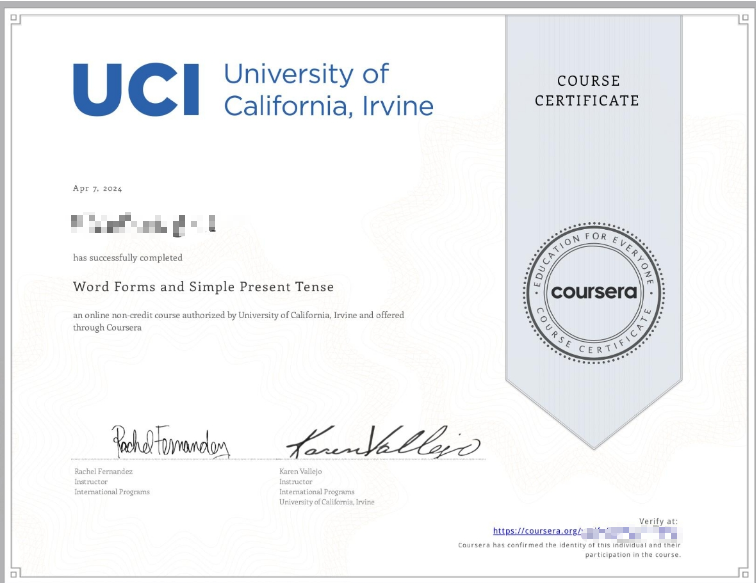
本文是学习Coursera上 Word Forms and Simple Present Tense 这门课程的学习笔记。
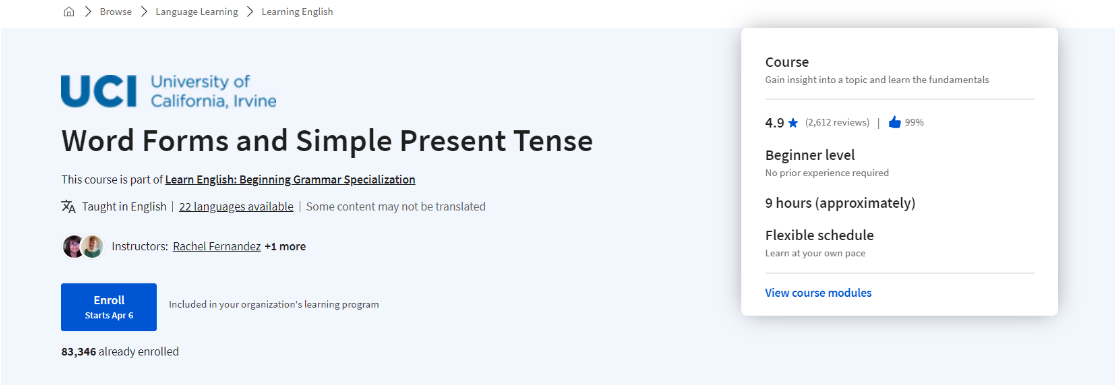
文章目录
- Word Forms and Simple Present Tense
- Week 01: Introduction & BE Verb
- Learning Objectives
- Word Forms
- Word Forms (Practice Exercise)
- BE Verb
- BE Verb (Practice Exercise)
- Nouns & Articles
- Nouns & Articles (Practice Exercise)
- Quiz: Word Forms & BE Verb
- Week 02: Simple Present
- Learning Objectives
- Go, Do & Have
- Go, Do & Have (Practice Exercise)
- Simple Present Verbs
- Simple Present Verbs (Practice Exercise)
- Possessives
- Possessives (Practice Exercise)
- Quiz: Simple Present
- Week 03: Simple Present Negative
- Learning Objectives
- Negative BE
- Negative BE (Practice Exercise)
- There Is & There Are
- There Is & There Are (Practice Exercise)
- Simple Present Negative
- Simple Present Negative (Practice Exercise)
- Quiz: Simple Present Negative
- Week 04: Yes/No Questions
- Learning Objectives
- Yes/No Questions BE
- Yes/No Questions BE (Practice Exercise)
- Is There? & Are There?
- Is There? & Are There? (Practice Exercise)
- Yes/No Questions Simple Present
- Yes/No Questions Simple Present (Practice Exercise)
- Quiz: Yes/No Questions
- 后记
adjective:美 [ˈædʒɪktɪv] 形容词
plural:美 [ˈplʊrəl] 复数
contraction:缩写形式
apostrophe:美 [əˈpɑstrəfi] 撇号‘
vowel: 美 [ˈvaʊəl] 元音字母
consonant:美 [ˈkɑːnsənənt] 辅音字母
article: 美 [ˈɑːrtɪkl] 冠词
simple present:一般现在时
possessive adjective:所有格形容词 such as my your their
Week 01: Introduction & BE Verb
In this first week, we will look at word forms. You learn about different kinds of words like nouns, verbs, and adjectives. Then you will learn about different kinds of nouns. You will learn about plural and singular nouns, how to make spelling changes, and when to use the articles “a” and “an.” You will also learn about verbs in the simple present. We will start with the BE verb. BE is very common. We use it all of the time.
Learning Objectives
- Identify nouns, proper nouns, pronouns, verbs & adjectives. 识别名词、专有名词、代词、动词和形容词。
- Recognize the forms and uses of BE.
Word Forms
Welcome to beginning grammar,
Introduction to Grammar. In this lesson, you will learn about some different word forms. There are different
kinds of words. We are going to look at
nouns, verbs, and adjectives. Then we will look
at different kinds of nouns: common nouns, proper nouns, and pronouns.
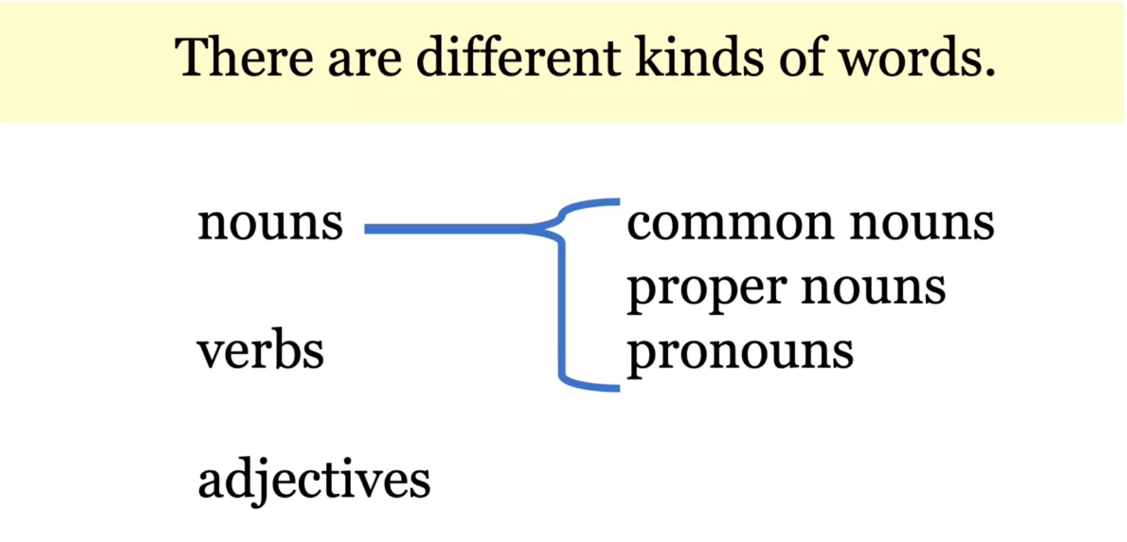
To begin, a noun is a word that is a person,
place, or thing. For example, a noun is a
person like the words mother, student, teacher, and baby. A noun is also a place. The words city, restaurant, classroom, and park
are all nouns. A noun is a thing. So the words pen, chair, keyboard, and banana
are also all nouns.
Another kind of word is a verb. A verb is an action word. Cook, laugh, drink, and
dance are all verbs. They tell what happens. A 3rd kind of word
is an adjective. An adjective is a word
that describes a noun. Tall, hot, and pink
are all adjectives. They tell you something
about the nouns. The giraffe is tall, the coffee is hot, and the flower is pink. Now you know three
kinds of words. A noun is a person, place, or thing, like baby,
park and banana. A verb is an action
word like dance; the father and daughter dance. An adjective describes
a noun like pink. This flower is pink.
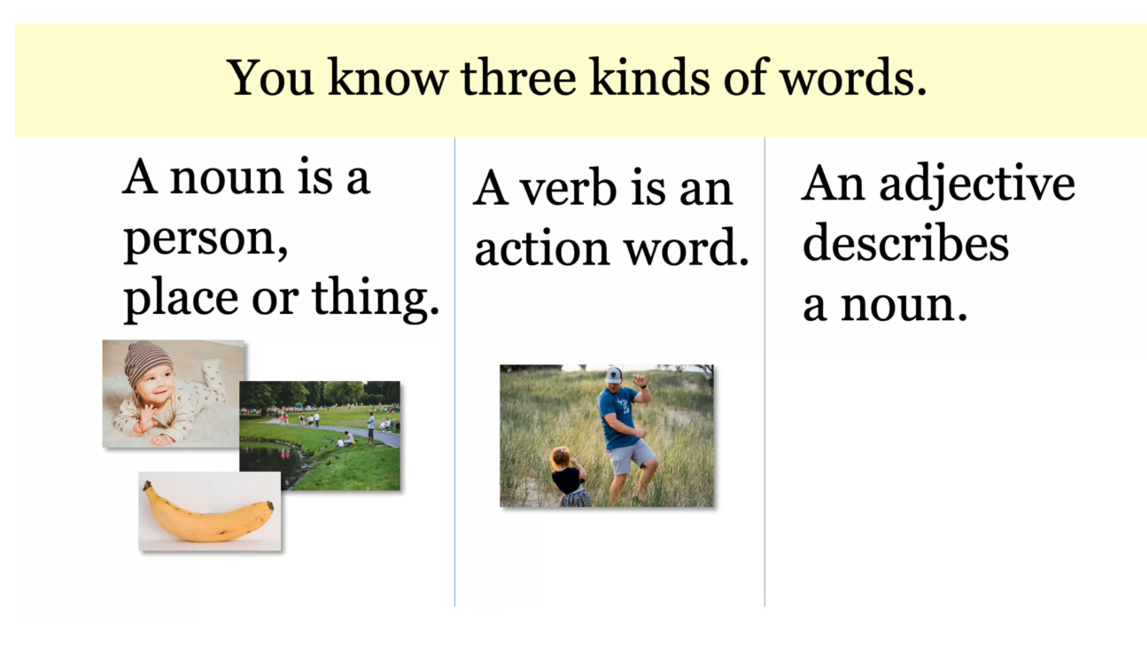
Now let’s look more
closely at nouns. There are different
kinds of nouns. Two of these are common
nouns and proper nouns. Common nouns and
proper nouns are both words for a
person, place or thing, but a common noun is
for any person, place, or thing, and a proper
noun is a name. Here’s an example. Here’s a student. The word student
is a common noun. If we give this student a name, Mary, Mary is the
name of the student. Mary is a noun, but it is a proper noun
because it is a name. Notice the capital letter. We always use capital
letters for proper nouns. But do you see student? We don’t use a
capital letter for the word student because it
is a common noun, not a name.
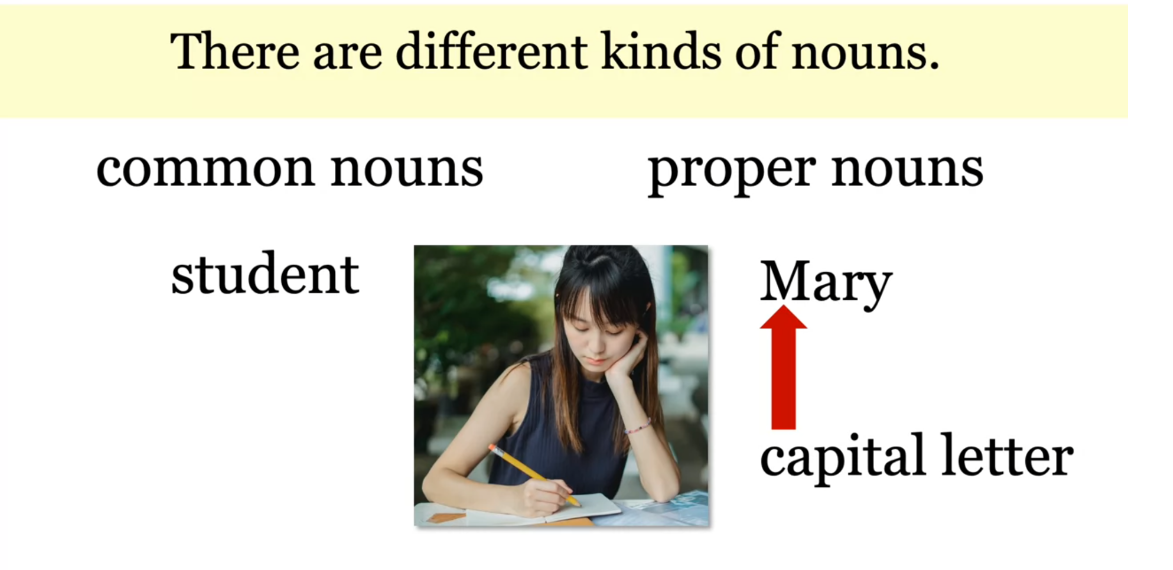
Let’s take a moment here to
look at the English alphabet. This is the alphabet. We have two kinds of letters. These are the capital letters. Sometimes we call
them uppercase, but in these lessons, we will call them
capital letters. These are the lowercase letters. In English, we start every sentence with
a capital letter. You can see that here and here. We also use capital letters for proper nouns like
in this example, student is a common noun
and Mary is a proper noun. It is the name of the student.
Let’s look at some more
examples of proper nouns. City is a common noun but New York is a proper noun because it is the
name of a city. Notice the capital letters. The word car is a noun, but Mercedes Benz is a proper noun because it is
the name of a kind of car. That’s why the m and b in Mercedes Benz are
capital letters. The word street is a noun, but when the street has a
name like Sunset Boulevard, it becomes a proper noun.
Let’s practice. You are going to see a word. Think, is it a common
noun or a proper noun? Cat. Cat is a common noun. This could be any cat. We don’t know the
name of the cat. Buddy. Buddy is a proper noun. It’s the name of this dog. Hilton. Hilton is a proper noun. Hilton is the name
of the building or the hotel chain so it has that capital letter. Hotel. Hotel is a common noun. We don’t know the
name of the hotel, so we don’t use the
capital letter. Apple. The word apple
is a common noun. Apple. This is a
different kind of Apple. This apple is a brand name, so it is a proper noun. Look at the proper nouns here. Notice the capital letters. We use a capital letter
to show proper nouns, that is, the names of nouns. This is what you know.
A noun is a word. A noun is a person,
place, or thing. There are different
kinds of nouns. You know, common
nouns, proper nouns. Now the last thing that
we will look at in this lesson is pronouns.

Common nouns and proper nouns are two types of nouns used in language to name people, places, things, or ideas.
-
Common Nouns: These are general names used for a class of person, place, thing, or idea. They are not capitalized unless they appear at the beginning of a sentence. Examples include “dog,” “city,” “book,” and “idea.”
-
Proper Nouns: These are specific names used for individual people, places, things, or ideas. They are always capitalized. Examples include “Rover” (the name of a specific dog), “New York City” (the name of a specific city), “Harry Potter” (the name of a specific book character), and “Democracy” (the name of a specific idea or concept).
In summary, common nouns refer to general categories, while proper nouns refer to specific entities within those categories.
Pronouns are another
kind of noun. This is the pronoun chart. In English, we organize
the pronouns like this. First-person, second-person,
and third person, and singular, that’s one. Plural, that’s more than one.
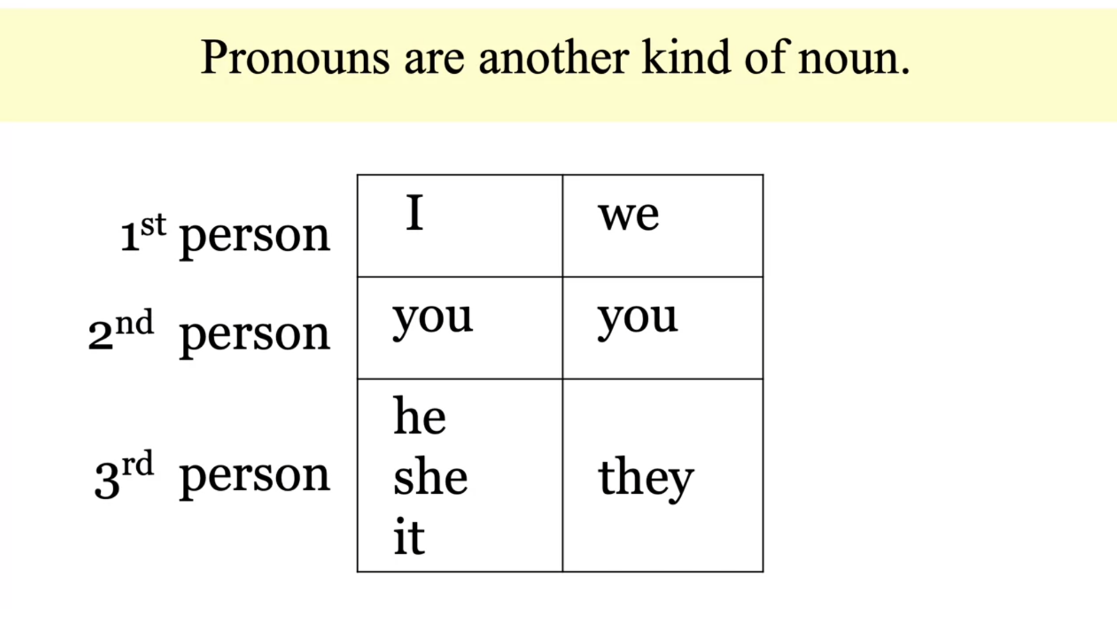
There are some things
to know about pronouns. First, noticed this, I. The pronoun I in English is
always a capital letter. There is only one
you in English. Notice that singular you and
plural you are the same. Let’s look at an example. Here’s a teacher. He
says, “You are right.” Maybe he is talking
to this girl. Maybe he’s talking to this boy. Maybe he is talking to
all of the students. Maybe he’s talking to an older man or maybe
he’s talking to his dog. Every time he says
“You are right” because there is only
one “You” in English. Also, the pronoun, they, can be people or things. Notice that he, she, and it are the singular
form of the third-person. But the plural
form is just they. That means that they
can be two friends, or they can be five books. They can be girls
or boys or things. Now let’s look at how
we use the pronouns. Pronouns replace nouns.
Let’s read this. This is Jennifer. She is five-years old. She has a brother. He
is seven years old. Jennifer is in
kindergarten this year. Let’s look for the pronouns. Here we see she two times. The pronoun she replaces
the proper noun Jennifer. Then down here we
see he, who’s he? He is the brother, so here we replace the common noun brother
with the pronoun he. We will learn more about
pronouns in future lessons.
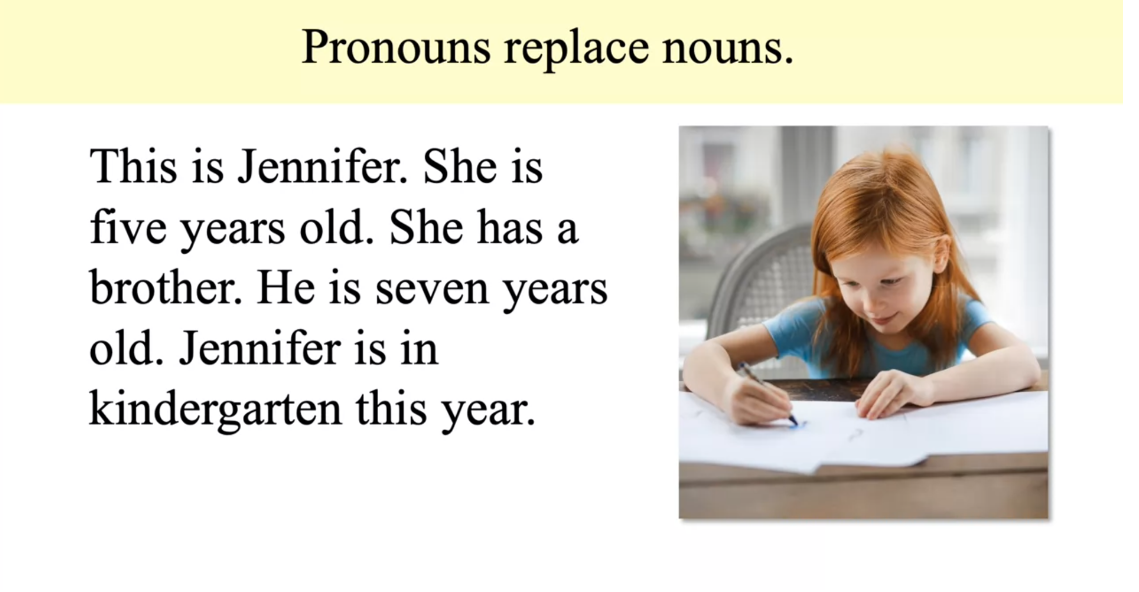
All of these words work
together. Let’s read this. Hi, my name is Lisa. I’m from a small
town in California. I am a student at University
of California in Irvine. It is a big school. First, do you see the common
nouns and the proper nouns? Let’s underline
the common nouns. Name, town, student, and school. Now let’s circle
the proper nouns. Lisa, California, University
of California, Irvine. Proper nouns are easy to see because they have
the capital letters. Now, let’s look
for the pronouns. Do you see pronouns? We have the pronouns
I two times and it. Remember I is always
a capital letter. Down here ‘it’, only has a capital letter because it is the first word
of the sentence.
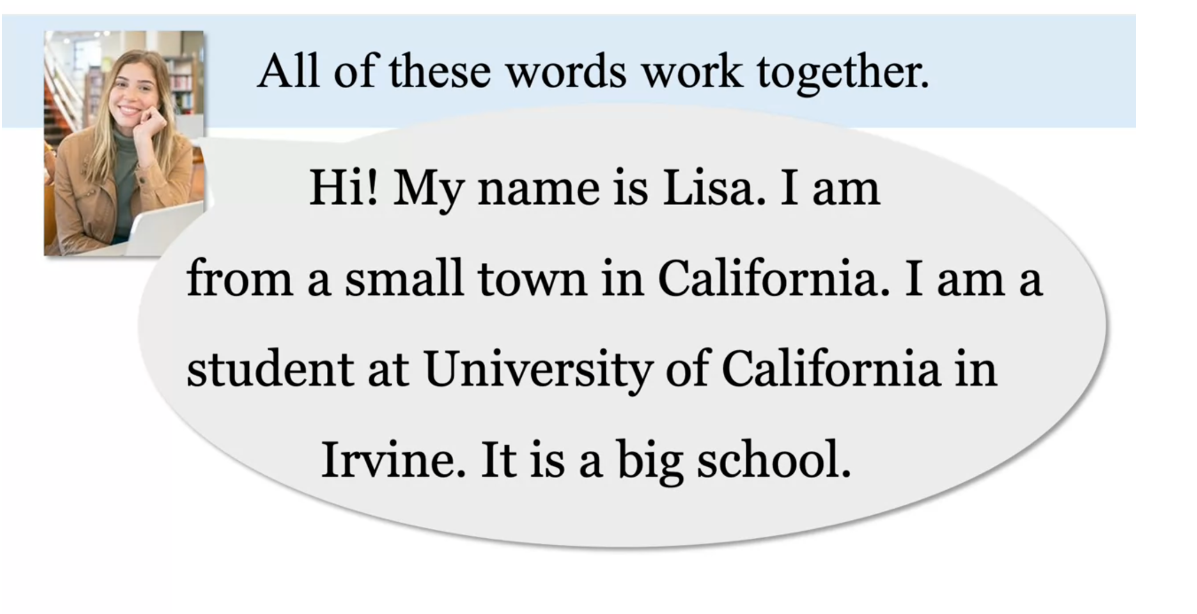
Now you know there are
different kinds of words. Nouns are words for a
person, place, or thing. Verbs are action words, and adjectives are words that describe or tell about a noun. You learned that there are
different kinds of nouns. Common nouns like
student and hotel, proper nouns like
Mary and Hilton, and pronouns like she and it.
Word Forms (Practice Exercise)
Practice exercise
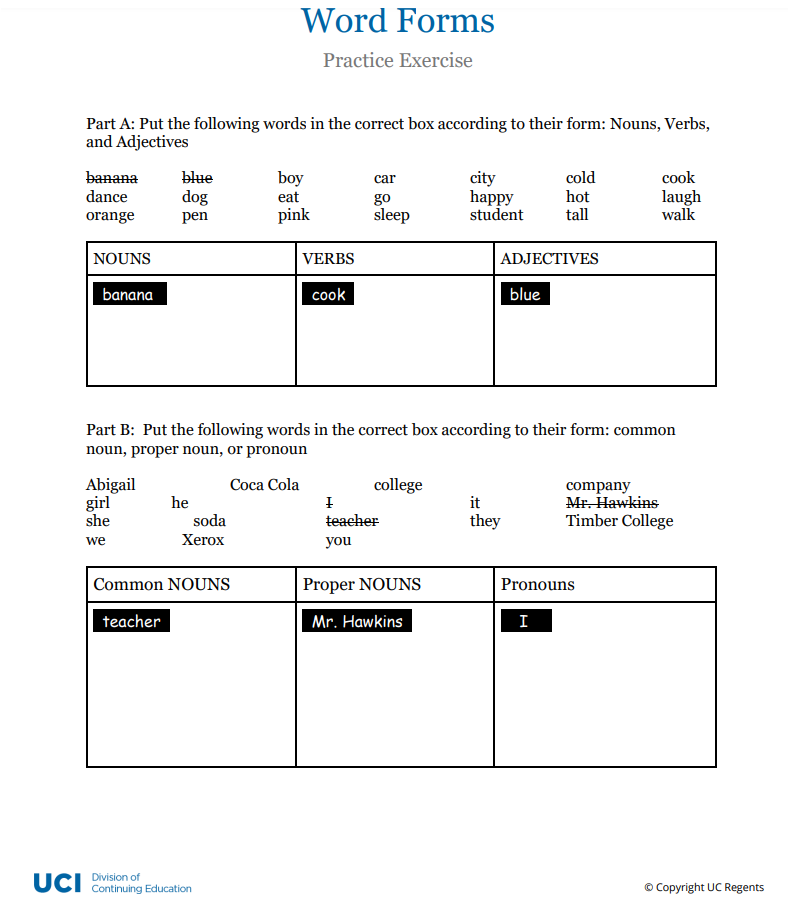
Answers

BE Verb
In this lesson,
you will learn about the BE Verb. What is the BE verb? Well, BE is a verb to start with. Remember a verb is an action word
like cook, laugh, drink and dance. BE is a verb but it is not an action word. I am sure you hear the BE
verb all of the time. In fact,
these sentences are full of the BE verb. Let’s look is, is a form of the BE verb. I am is also the BE verb and
are is also a form of BE.
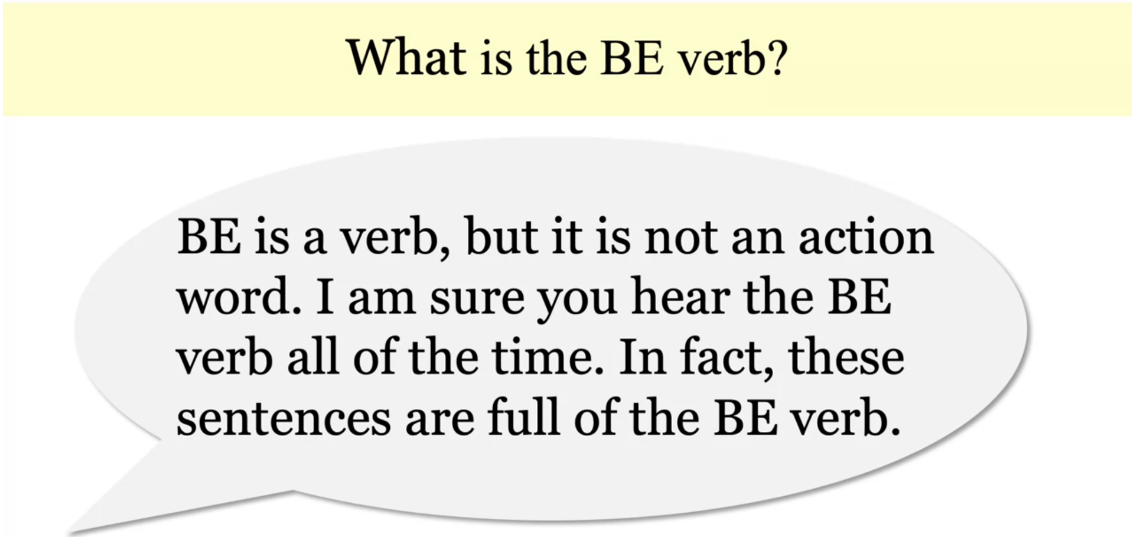
Let’s look at the verb chart for
BE in the simple present. Here is a chart with the pronouns and
here are the forms of the BE verb. I am, you are, he is, she is, it is, we are, you are and they are. You can see there are 3
forms of the BE verb. Other verbs only have 2 forms,
but BE is always different. You can see that BE is strange because
none of these forms look like BE. There’s no letter BE in any of them. Also notice that the plural
forms are all the same word.
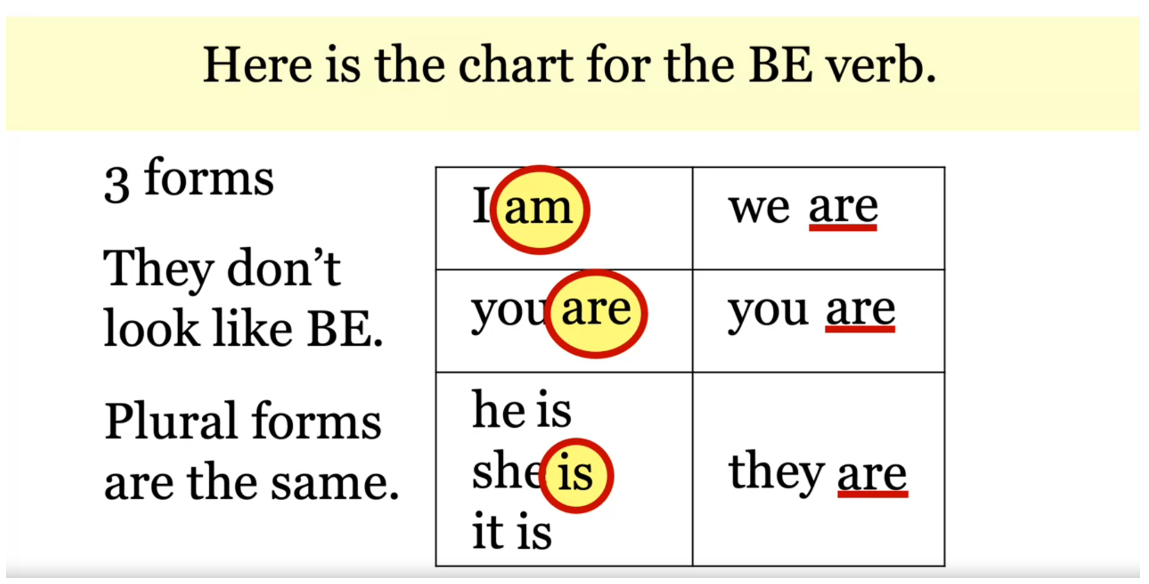
When do we use the BE verb? Let’s look at this sentence,
Mark drinks water, Mark is the subject of the sentence. The subject does the action
drinks is the action, drinks is the verb in the sentence,
Mark is the subject because he drinks. Okay, now let’s look at this sentence. The water is cold. What is the subject? Water, right? So water is the subject and what does
water do what action does water do? Nothing? Water doesn’t do anything
in this sentence. Water just is, this is when we
use the BE verb in English, we need a verb but there is no action. So we use the BE verb to connect
the subject to the rest of the sentence. The water is cold, is is the verb, and we use the BE verb to connect
to the adjective cold. We need a verb.
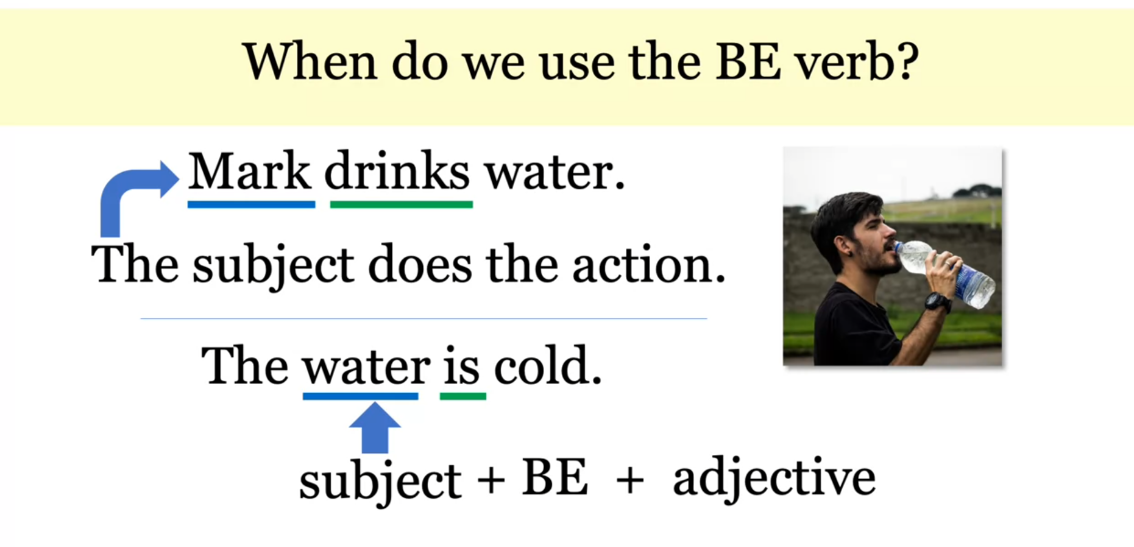
Let’s look at some examples. Kate is a scientist. Kate is in a laboratory. Kate is smart. In the first sentence,
Kate is the subject, is is the BE verb that
connects the subject to a noun scientist that tells more about Kate. In the 2nd sentence,
Kate is the subject is is the form of the BE verb that
connects Kate to the rest of the sentence here,
it’s a noun, a place. In the 3rd sentence. Again, Kate is the subject
is is the BE verb, that connects Kate to the rest
of the information here. An adjective that describes
her Kate is smart.

BE connects the subject to
information about the subject. Here is Mark again. Mark is a runner. Mark is the subject is is the BE verb and a runner is more information about Mark. BE is the verb that
connects the information to the subject when there
really isn’t any action. Here the more information
is a noun runner but we can change the sentence. Mark is thirsty. Now the information is an adjective. Mark is at a park. Now that information is at
a place Mark is from California. Also a place from a place
BE connects the subject to information about the subject when there isn’t really an action happening.
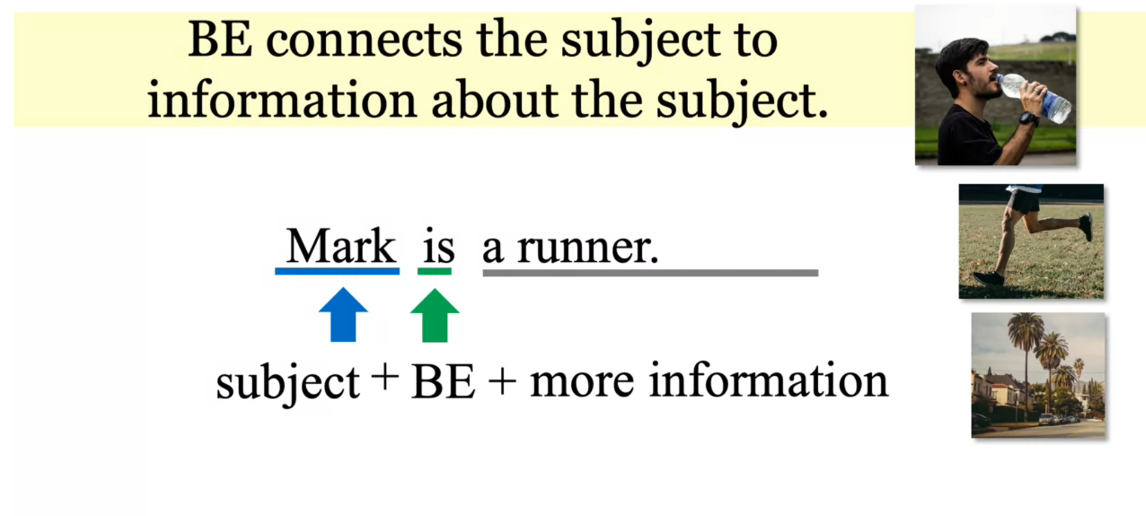
If you say to me, my friend Diana,
an engineer, I understand more or less what you’re saying but
the grammar is incorrect. We need the BE verb to connect
the subject to the non engineer. My friend Diana is an engineer. We need the BE verb for
the sentence to be correct. If you say this strawberry is very sweet. I understand but the grammar is incorrect. There is no verb in the sentence and
every sentence needs a verb. So we use the BE verb. The strawberries are sweet and here are is the BE verb that connects
the strawberries to the adjective sweet. In some languages you can say Frank in
the kitchen and everybody understands. But in English this doesn’t work. We say frank is in the kitchen
because we need that BE verb. Here’s one more example. Can you see what is wrong? It is missing a BE verb. What form of BE should go
here am I am from California. This is correct grammar.
There are 3 forms of BE in the present but
we have more than three pronouns. In this chart. Am always goes with I and only I but look at our our goes with you,
we and they and is could be, he is, she is or it is. This is why we always need a subject
in every sentence in English.

Let’s look at an example. In English,
we need a subject in every sentence. In some languages you can
say are interesting but in English we don’t know what you mean. You are interesting, we are interesting. They are interesting,
since there are only 3 forms of BE. We need to include a subject
in every sentence. Are interesting is incorrect. Languages are interesting. Okay, let’s look at one more
thing about the verb to BE. We can use a contraction. Look at these two sentences,
she is a student and she’s a student. They sound almost the same. We see the BE verb is
in the first sentence. In the second sentence, there is just
an S this is called a contraction.

A contraction is 2 words in 1. This mark here, this mark is an apostrophe
and we use it in contractions, combine the pronoun and
BE to make a contraction. Let’s do it. Look at I am. So when I am we dropped the A. We move the m a little closer and
we add an apostrophe. I’m you are. Again we drop the a here, we push it
a little closer and we add an apostrophe. Your, he is, she is, it is,
followed the same pattern. So drop the I move the s closer to make
one word and put in the apostrophe. She’s, it’s follow
the same pattern as he’s. We are changes to where you are, changes to your and
they are changes to their. Fill in the blanks. Let’s practice. Maybe you want to pause the recording and
try to fill in the blanks yourself. Okay, are you ready for the answers? Amy and Lynn, are friends. Amy is from California. Lynn is from Colorado. Amy and Lynn are college students. In this photo they are happy because they are on a camping trip together.

In this lesson,
you learned a lot about the BE verb. You learned BE is a verb. We use BE to connect the subject
to more information like a noun, adjective or place. There are 3 forms of BE
in the simple present am, is, are and we make contractions with BE. I’m, he’s and there. The end.
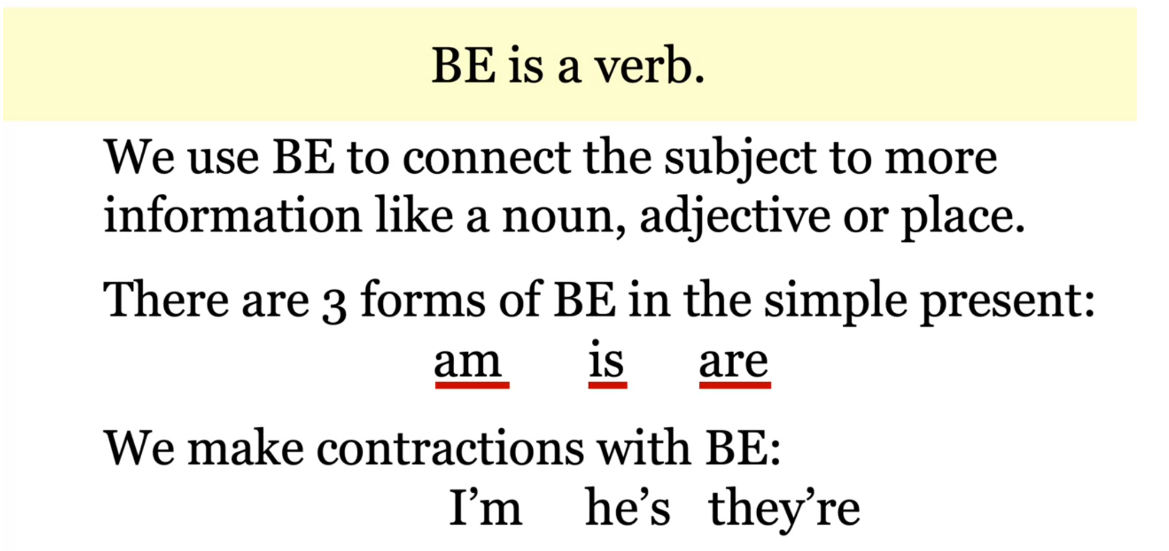
BE Verb (Practice Exercise)
Practice Exercise

Answer
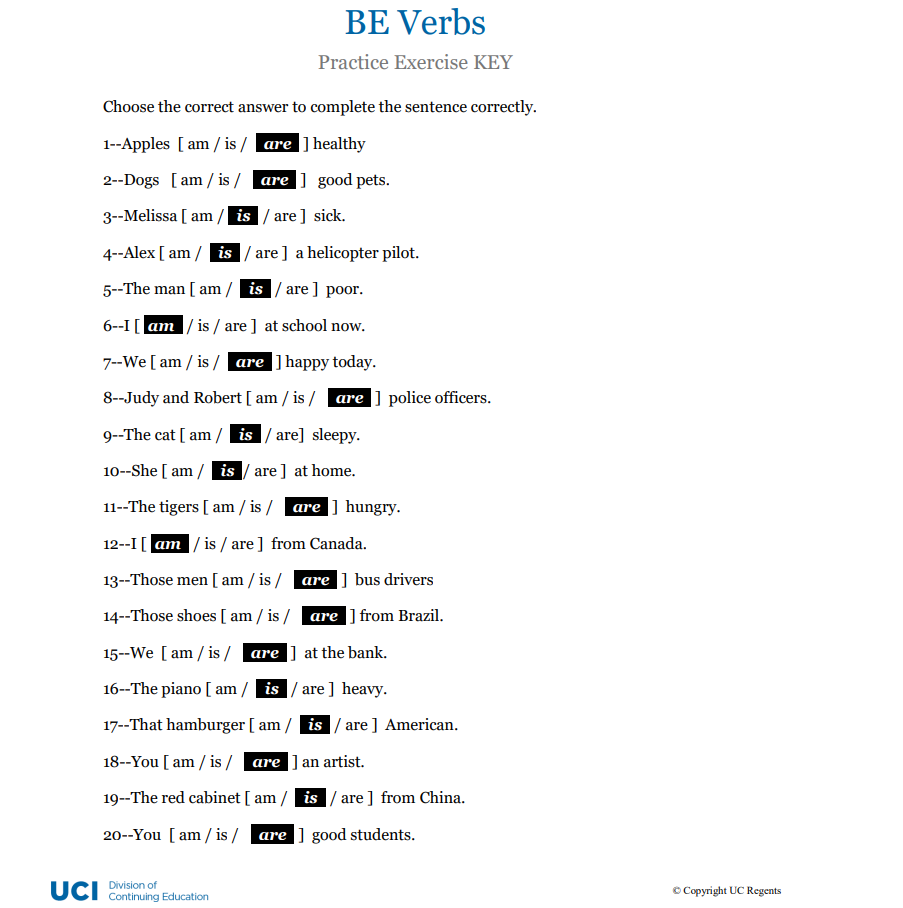
Nouns & Articles
Nouns. This lesson is about plural and singular
nouns, and articles. Nouns can be singular or plural. Singular means one,
plural means two or more. Singular is book and
plural is two books, or five books, or many books. Before we go on with nouns, let’s look again
at the alphabet.

This is the alphabet. You already know about capital
and lowercase letters. Let’s look at another
kind of letter. The alphabet has
vowels and consonants. A, e, i, o, u. These are called vowels. Every word in English
has at least one vowel. All of these other letters
are called consonants. We need to know this for some spelling rules we will
talk about in a moment.
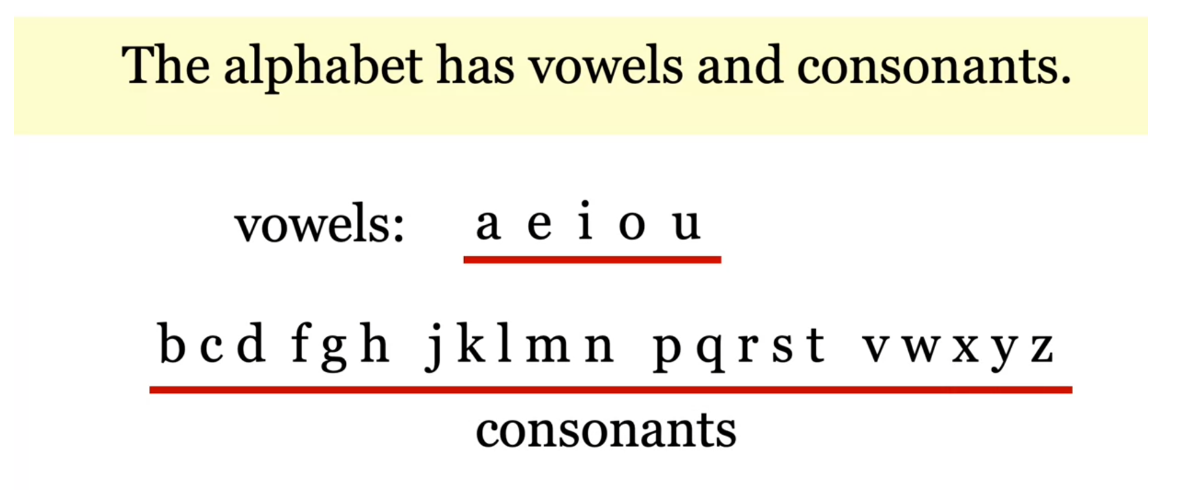
Back to nouns. Add an s to the noun to make
the plural form. We have one chair
and two chairs. Notice the s. Add an s
to make the plural form. Two chairs, 20 chairs,
or 300 chairs. There are spelling
changes when you add s. Let’s look at what happens when you add
s to different words. First, for most nouns, we just add an s.
Boy changes to boys, truck changes to trucks. But sometimes we add es. Box changes to boxes, and we add es to
dish to get dishes. Sometimes we drop
the y and add ies. For example baby, we dropped the y and add ies to get babies, and cherry we drop the y
and an ies to get cherries.
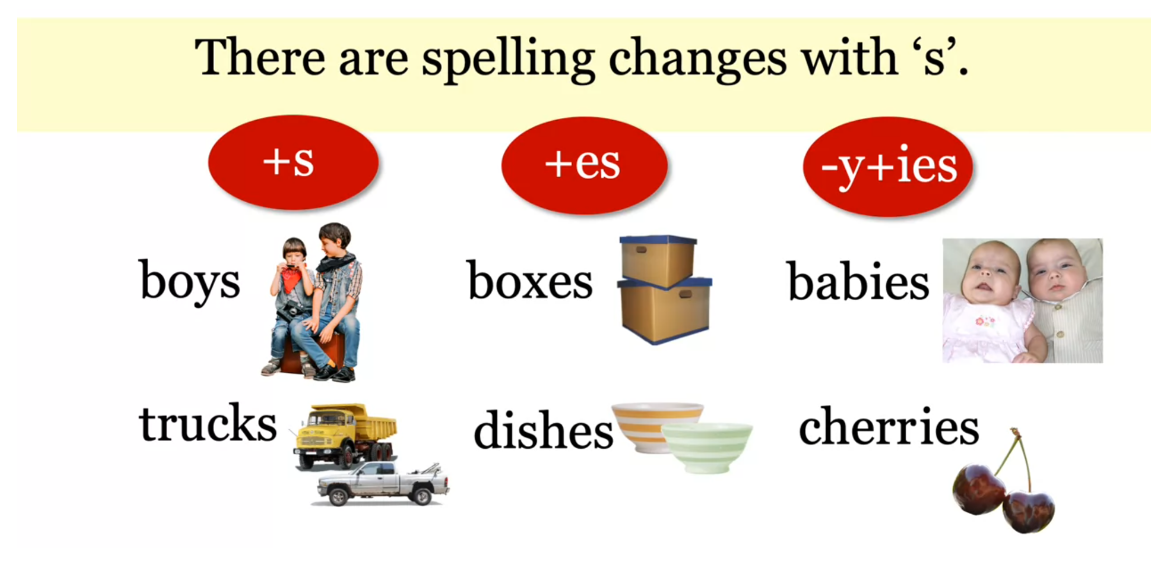
Let’s take a closer look. For most nouns, add s. The
plural of boy is boys, and we have one truck
and two trucks. Here is one bird, we add an s, we have two birds. Orange is the same, add an s, and we
have two oranges. Add es for s, ch, sh, x, and z endings. That means if the noun
ends with a sound like s, sh, ch, x, z, we need to add es. Box ends with x, so we add es and we get boxes. Dish ends with a sh sound. To make the plural, we
add es and we get dishes. Dress ends with an
s. We can’t just add an s because the word
would sound the same, so we add es and we
have two dresses. One inch becomes
12 inches because of that ch ending
sound, we add es.
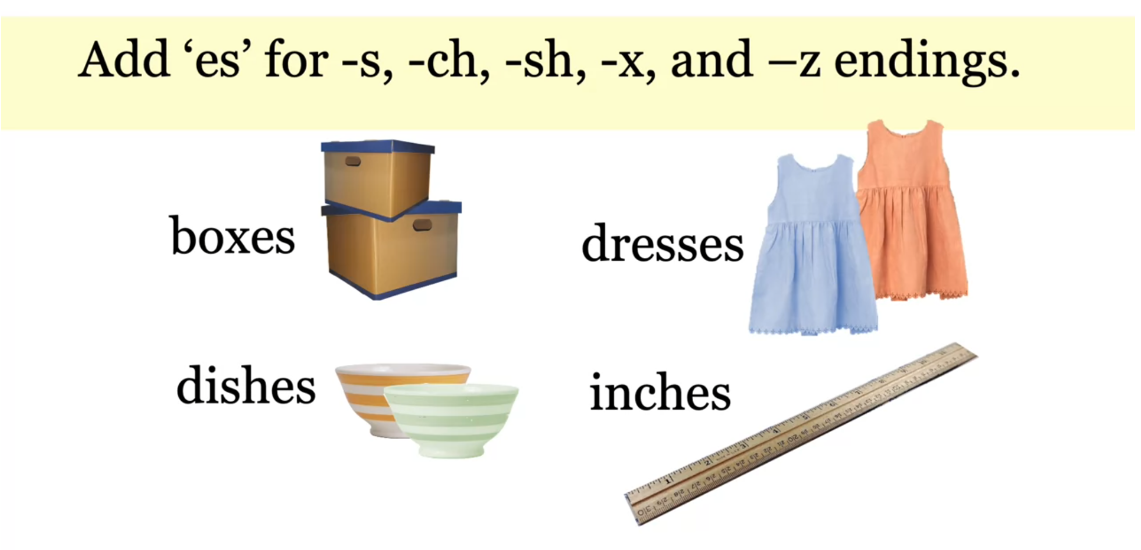
For nouns that end with
a consonant and y, drop the y and add ies. Baby ends with by, so we drop the y and add
ies to get two babies. The noun cherry ends with ry, so we dropped the y and add ies to get the plural cherries. Look at the word city, city ends with ty. That is also a
consonant and a y, so again, we dropped
the y and add ies. Finally, here is one French fry. If we want more than one, we need to drop
that y and add ies, and now we have
many French fries.
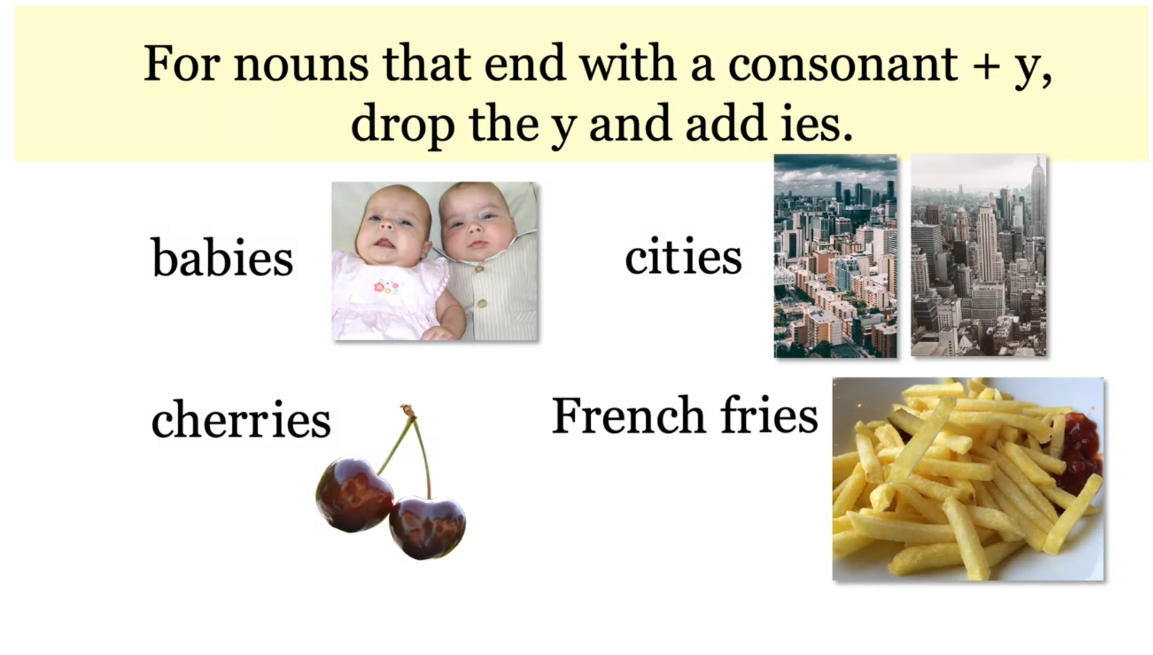
Notice the difference, all
of these nouns end with y, but for these, we just add s, and for these, we drop
the y and add ies. Why? Well, notice the endings. Over here, these end
with a vowel and a y. That’s why we just add s
to get monkeys and toys. But over here, these end
with a consonant and a y, and that’s why we
dropped the y and add ies to get cities and fries.
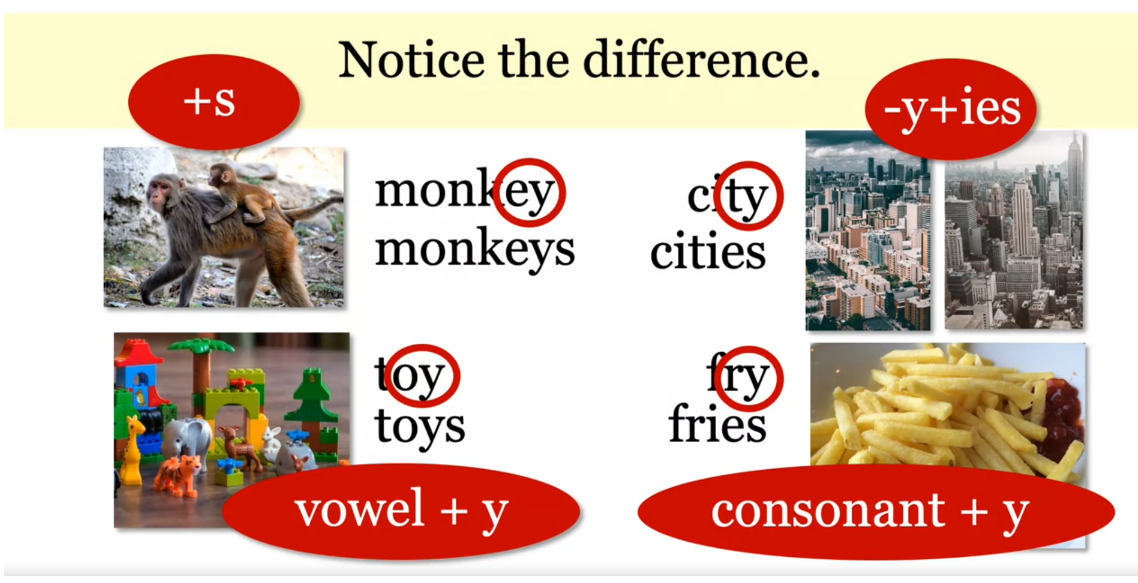
Some nouns have
irregular plural forms. There is not a spelling rule, we just have to know these. Here’s some examples. One man, two or more
men, woman, women, child, children, person, people. Notice that none of
these plural forms have s endings,
they are irregular.
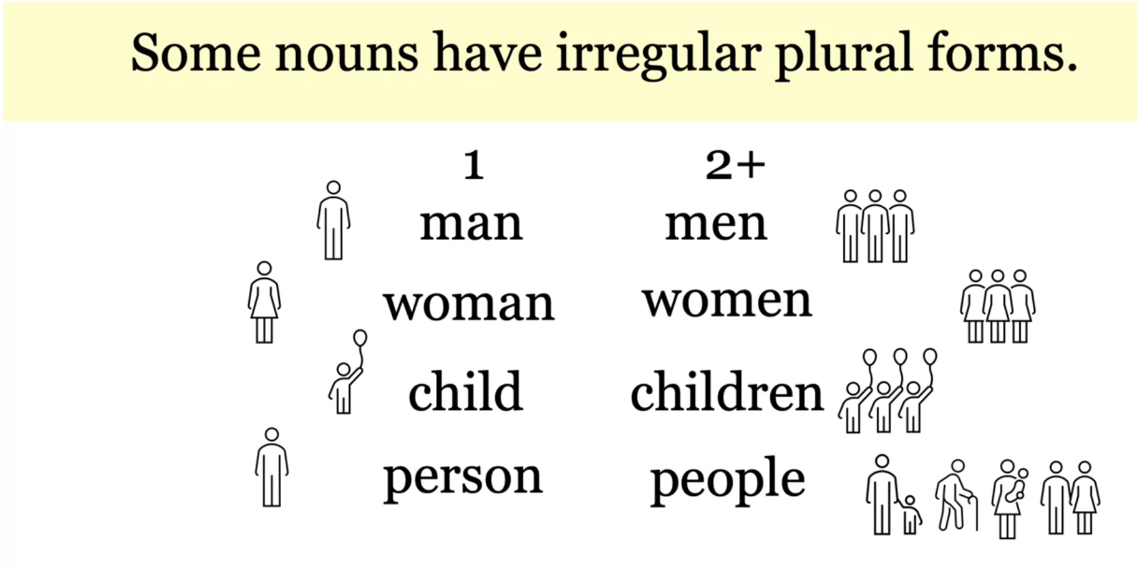
There are some other
irregular plural nouns. Here are a few examples. One tooth, two teeth, one leaf, three leaves, one
mouse two mice, these are irregular, so we
just have to learn them.
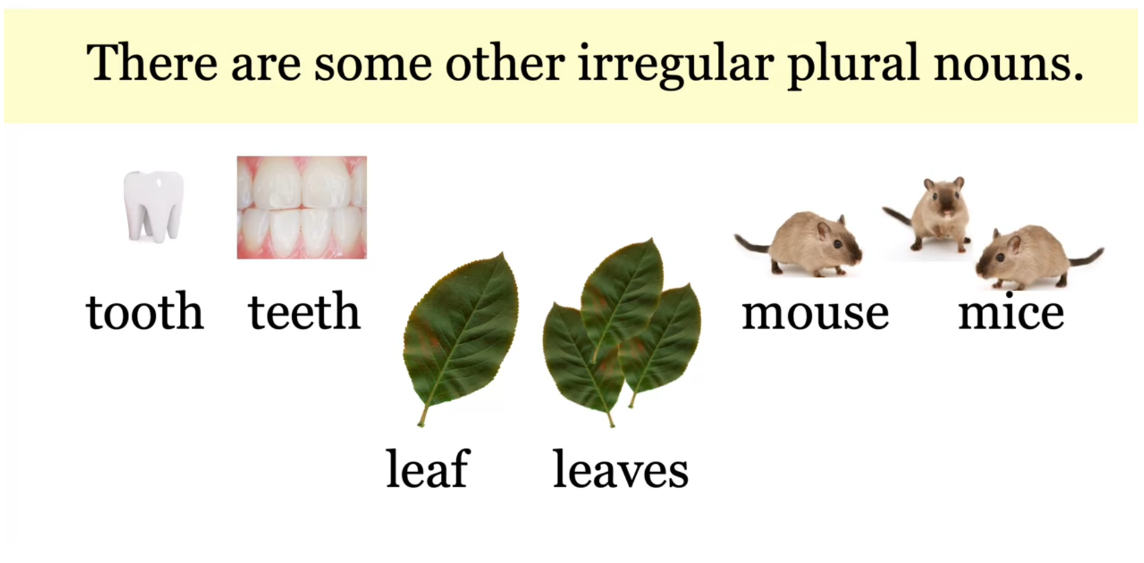
Singular nouns also
have some rules. The words a and an
are called articles. We use articles before
singular nouns.

Let’s look. Sarah is a student. She has a red coat. She has a backpack
and three books. Notice the a in front
of the singular nouns, but here we have three, so we don’t need an article.
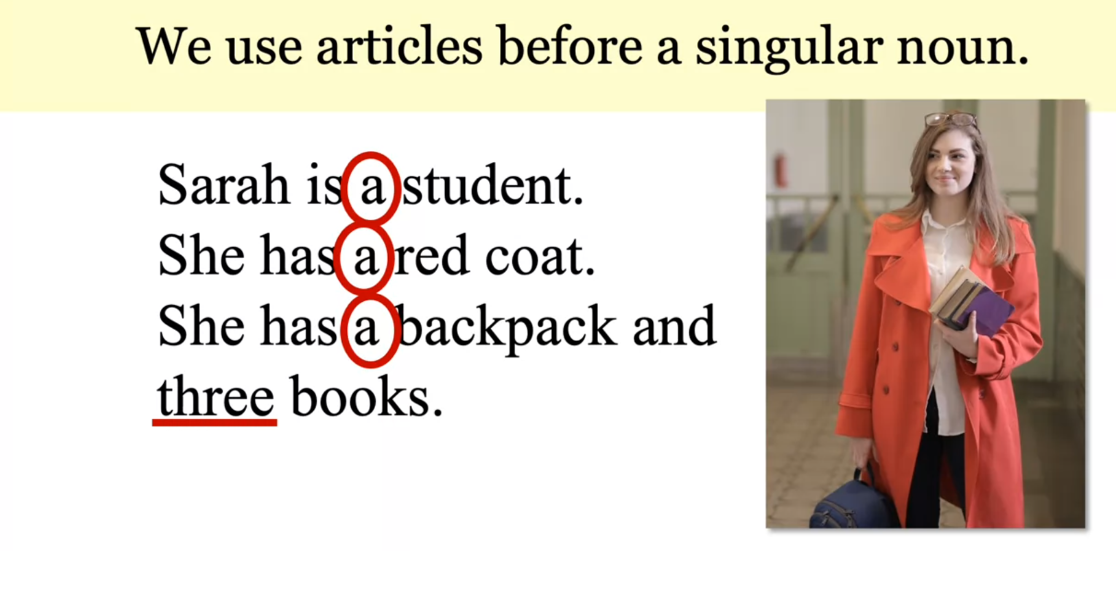
A sounds like uh and I’m sure
you hear it all the time, but it is a very small sound. Listen. I am a teacher. She is a good student. There’s a gym in the building. Do you have a minute? I’ll
have a small cup of coffee. Have a nice day. A is everywhere.
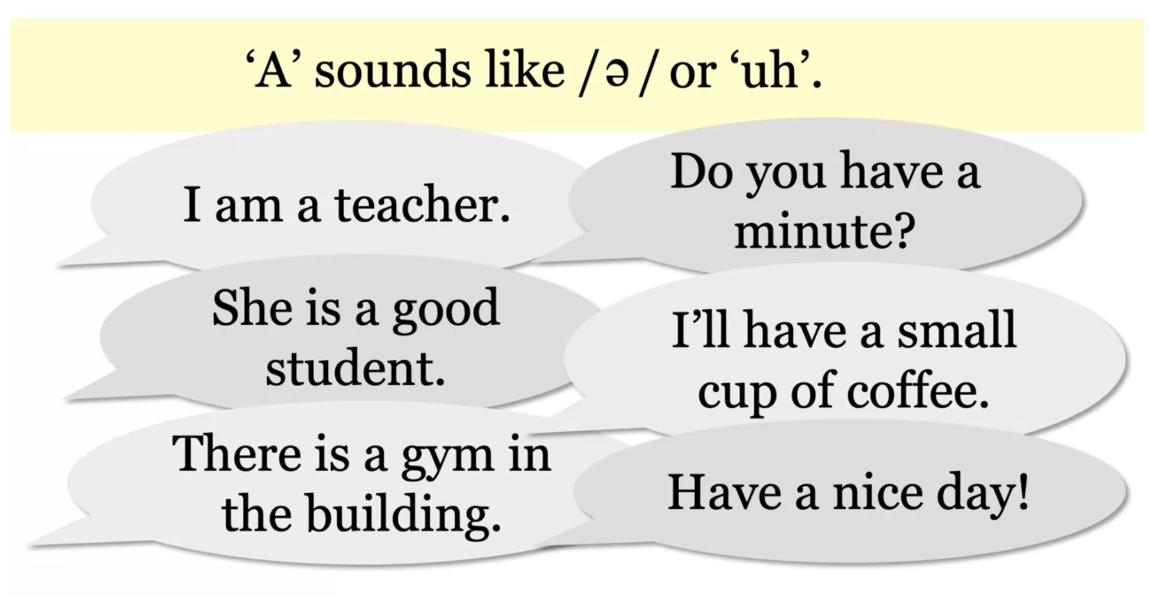
Let’s look at a and an. Use an before a vowel sound. A and an are the same thing, but we use an when the noun
starts with the vowel sound. Remember, the vowels are a, e, i, o, u. Here are some examples a bottle, a phone, a sofa. An elephant, an
airport, an onion. Notice the e in elephant, that is a vowel sound, so we need to use an before it. Airport also starts
with a vowel, so we use an and so does onion. We use an with these nouns, but it means the
same thing as a. We use it because of
those vowel sounds.
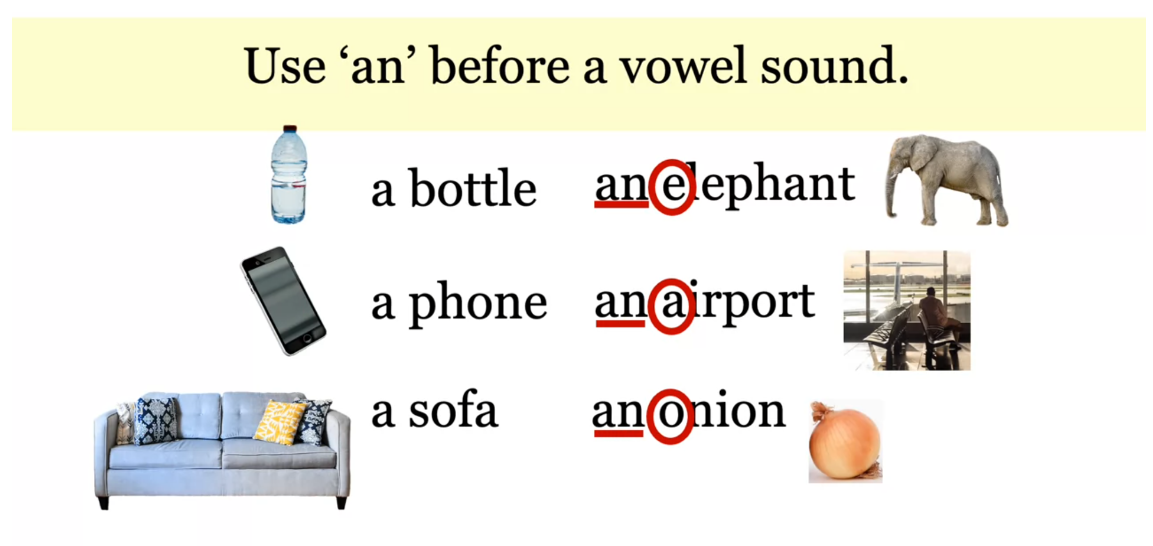
Let’s practice. You are going to
see a word, think, do we use a or an? House, a house. Orange, an orange. Umbrella, an umbrella. Spoon, a spoon. Bird, a bird. Owl, an owl. How did you do? Do you see all the vowel sounds that start the
words on the right?
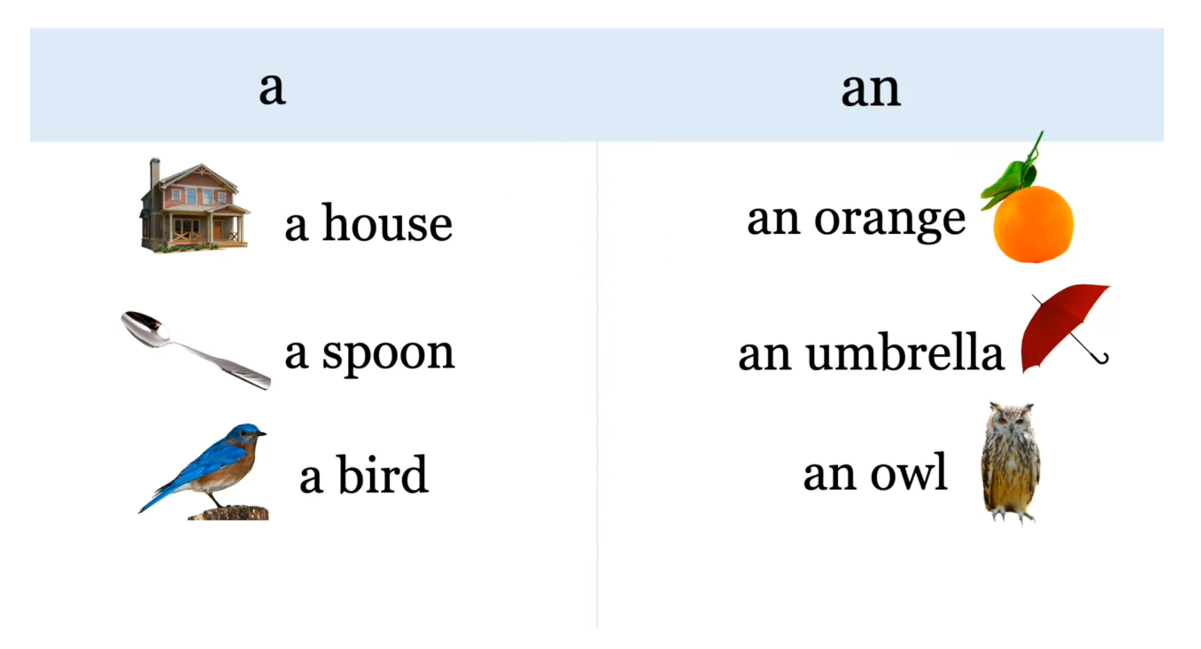
Here’s one more,
guitar, a guitar. But an electric guitar, why? Electric is an adjective. Adjectives describe nouns and adjectives come before
nouns in English. Electric also starts
with a vowel sound. It comes before the noun, but the article comes first, this is why we say
an electric guitar.
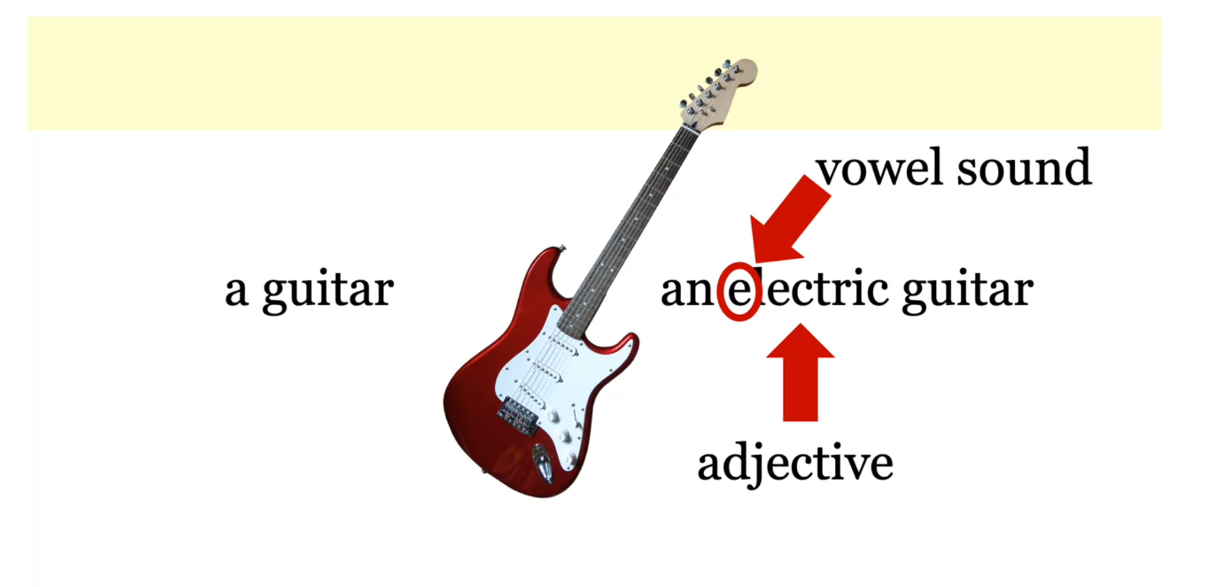
Adjectives come before nouns. This is Tom. Tom is a cat. Tom is fat. We can take the adjective
fat and put it before cat. Tom is a fat cat. But do you see the article, it’s still in front. We can put more adjectives
in front of cat. We can say Tom is
a fat gray cat. But notice the article is before the adjectives and the
adjectives are before the cat. You learned a lot
in this lesson. There are singular
and plural nouns, there are spelling
changes in the plural, like trucks, dishes,
and cherries. There are irregular
plural nouns like men, women, and children,
leaves, and mice. We use articles for
singular nouns, a bird, an orange, and we put
adjectives before nouns. A big red umbrella. End.
Nouns & Articles (Practice Exercise)
Practice Exercise
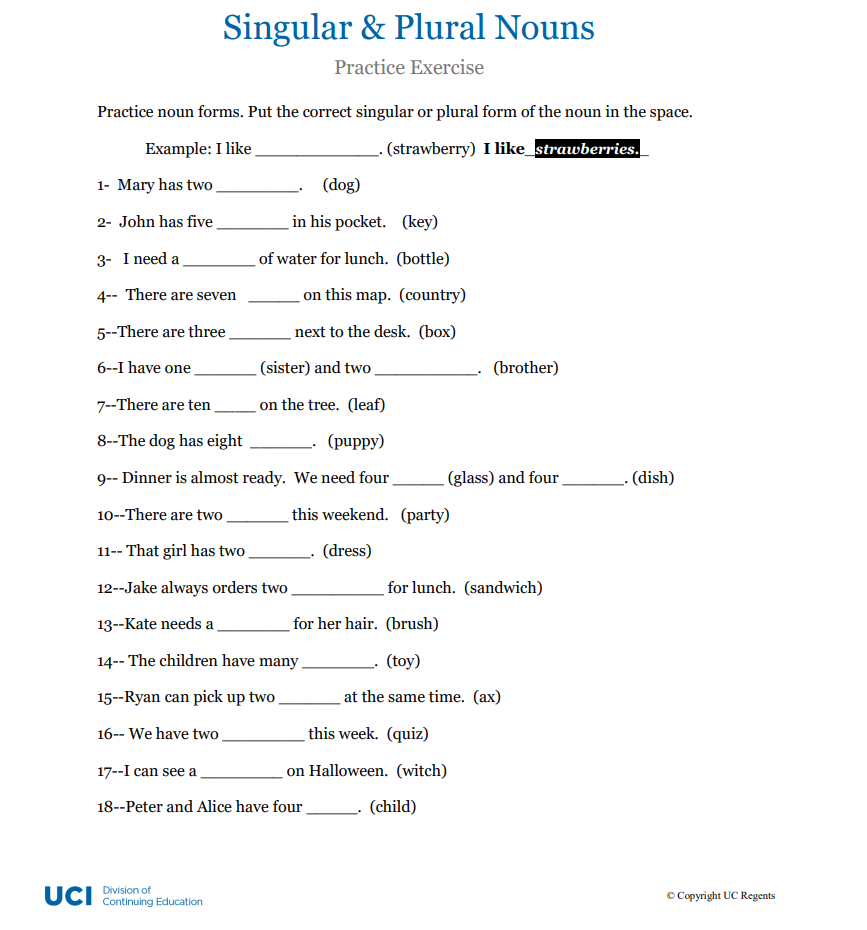
Answer
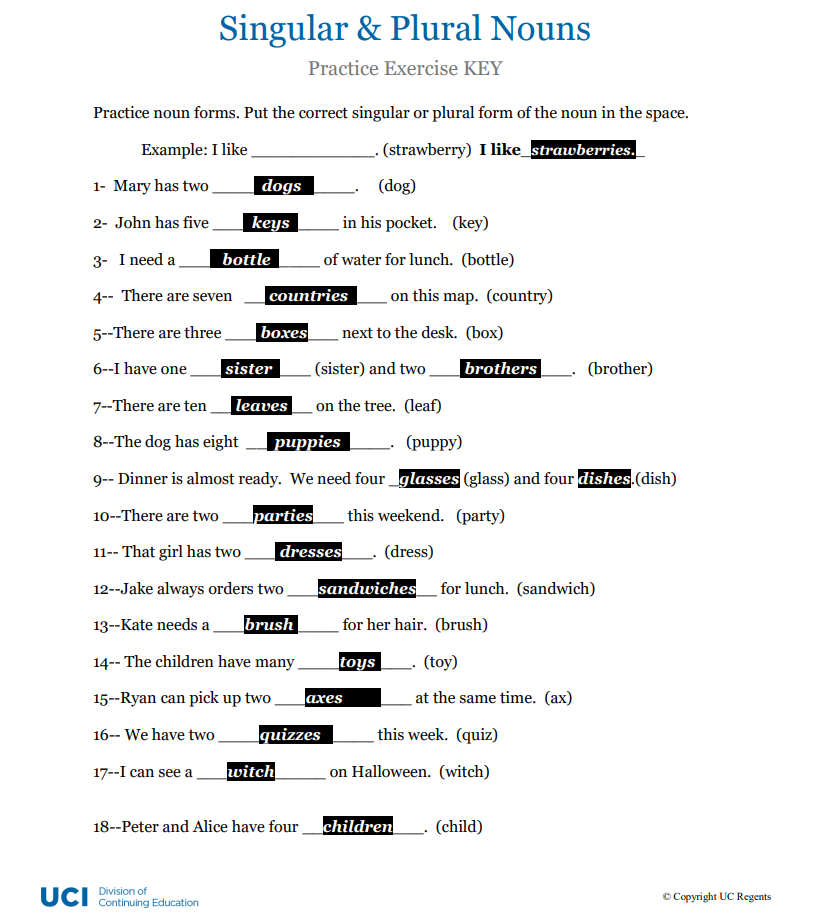
Quiz: Word Forms & BE Verb
plural: quizzes
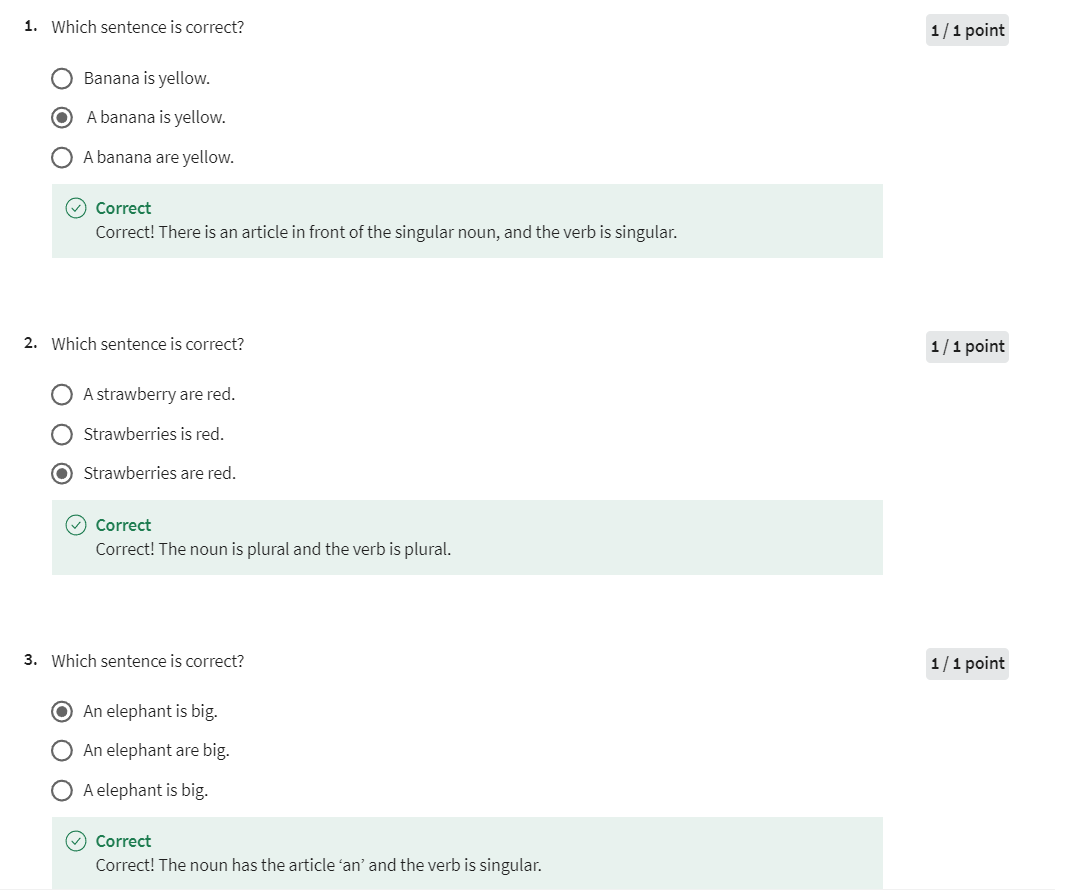
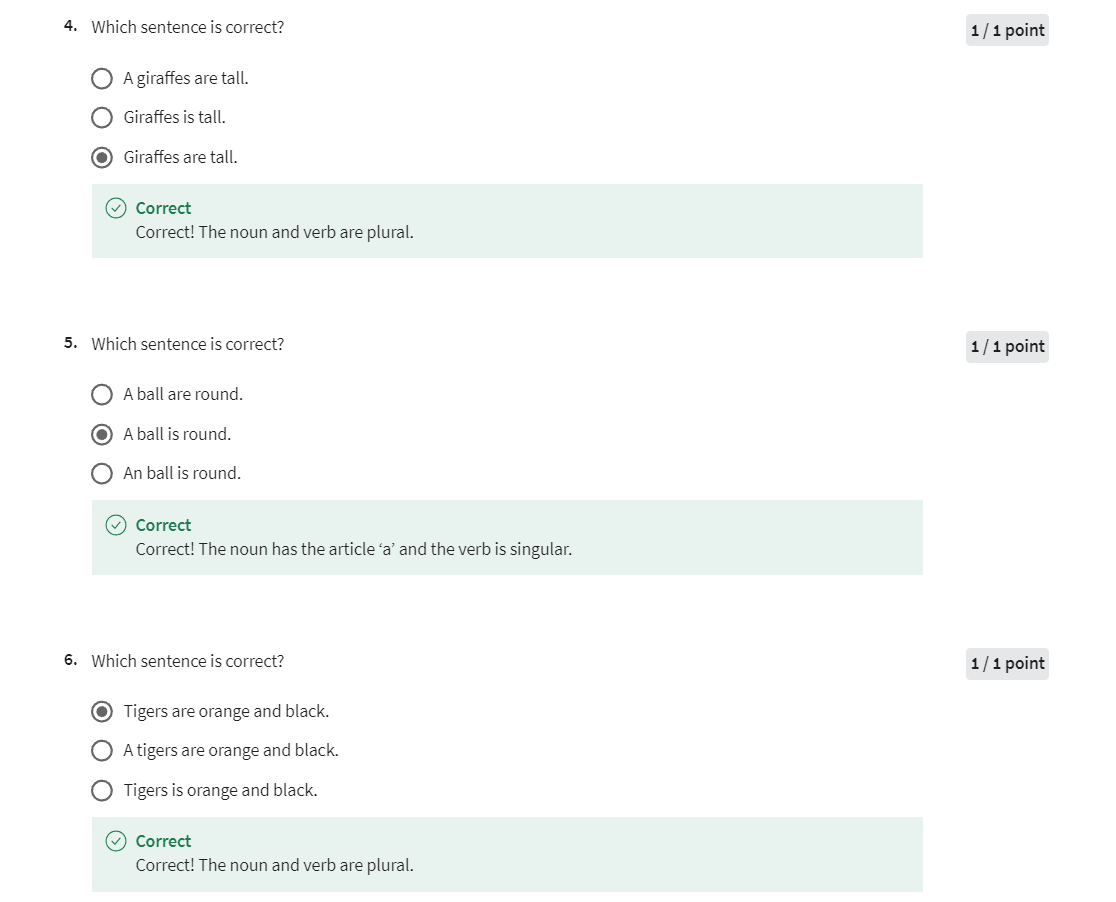
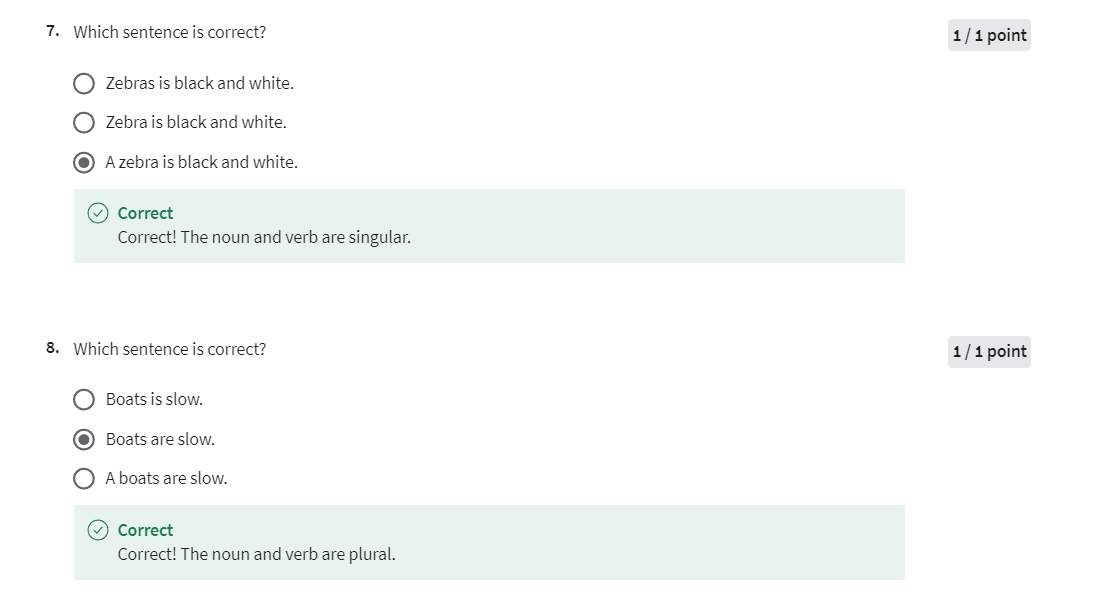
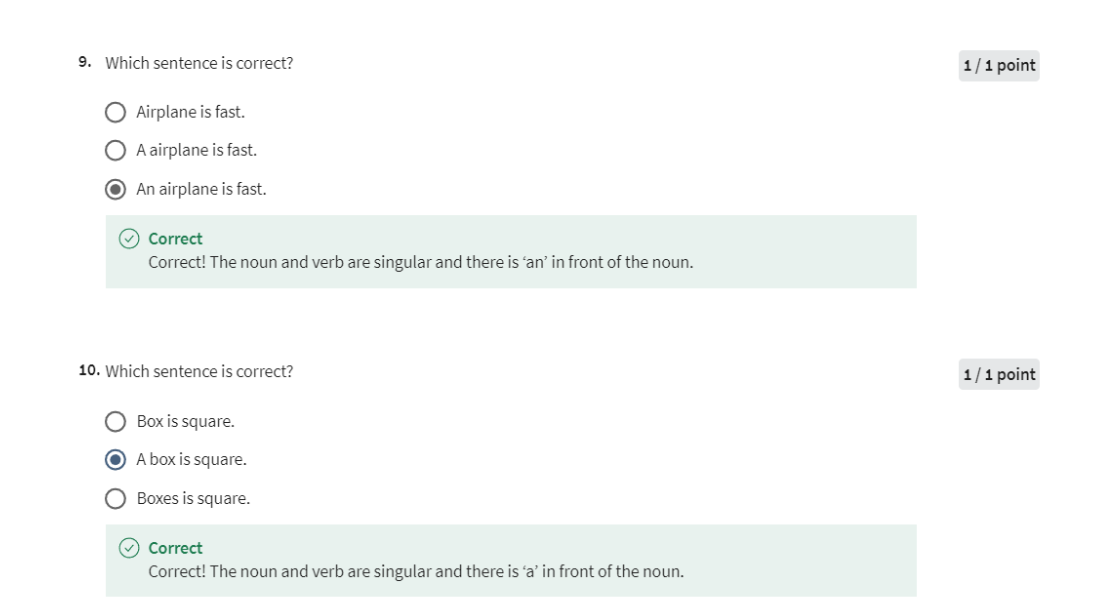
Week 02: Simple Present
simple present: 一般现在时
This week, we will look at other verbs in the simple present. You will learn how to form and use the simple present. You will also learn about the different spelling changes that happen when you add an “s” to a verb in the simple present. You will also learn about possessive adjectives and the apostrophe “s” to show someone has something.您还将学习所有格形容词和表示某人拥有某物的撇号 “s”。
Learning Objectives
- Form the simple present.
- Recognize possessive adjectives and apostrophe ‘s’.
Go, Do & Have
This lesson is about the verbs go,
do, and have. Go, do and
have are three verbs we use a lot. You hear them in sentences like,
I go to work at 9:00. They always do their homework. And, have a nice day. Go, do and have.
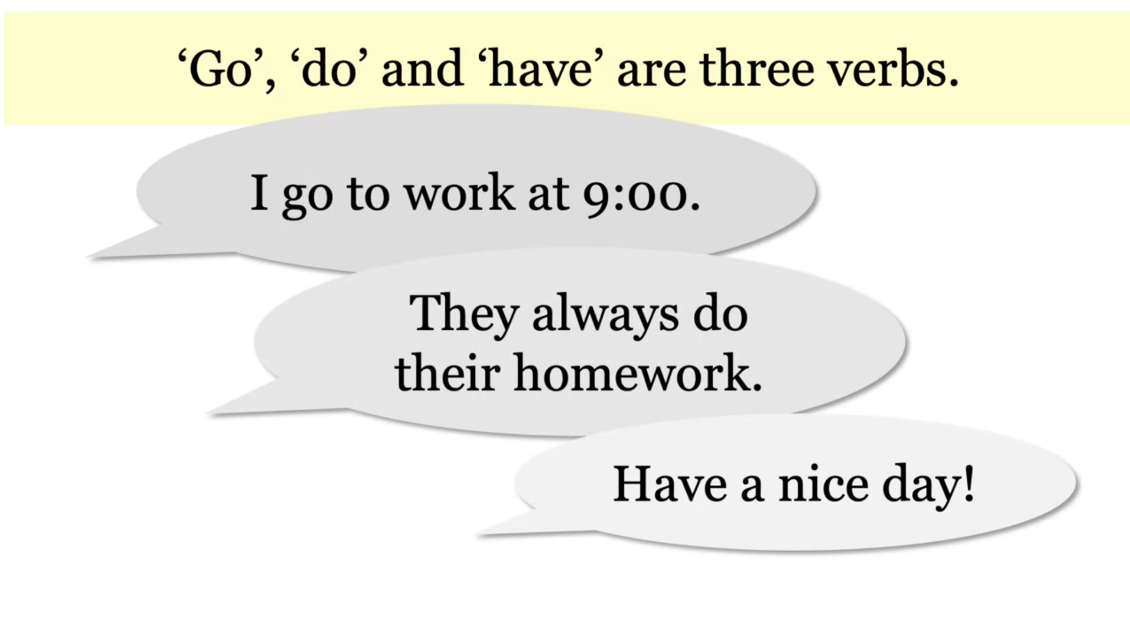
This is the verb chart for have. I have, you have, he has, she has, it has, we have, you have, they have. You can see they’re are only two forms,
have and has. Notice there is an S on the end of
the third person singular form. There’s always an S in this area but
have is an irregular form. You might want to write haves,
this is incorrect. The verb is has, for
third person singular.

Let’s look at some examples. Kim has two cats. One cat has long hair. The other cat has short hair. Both cats have pretty eyes. Notice the verb have in its two forms, has, has, has, and both cats have.
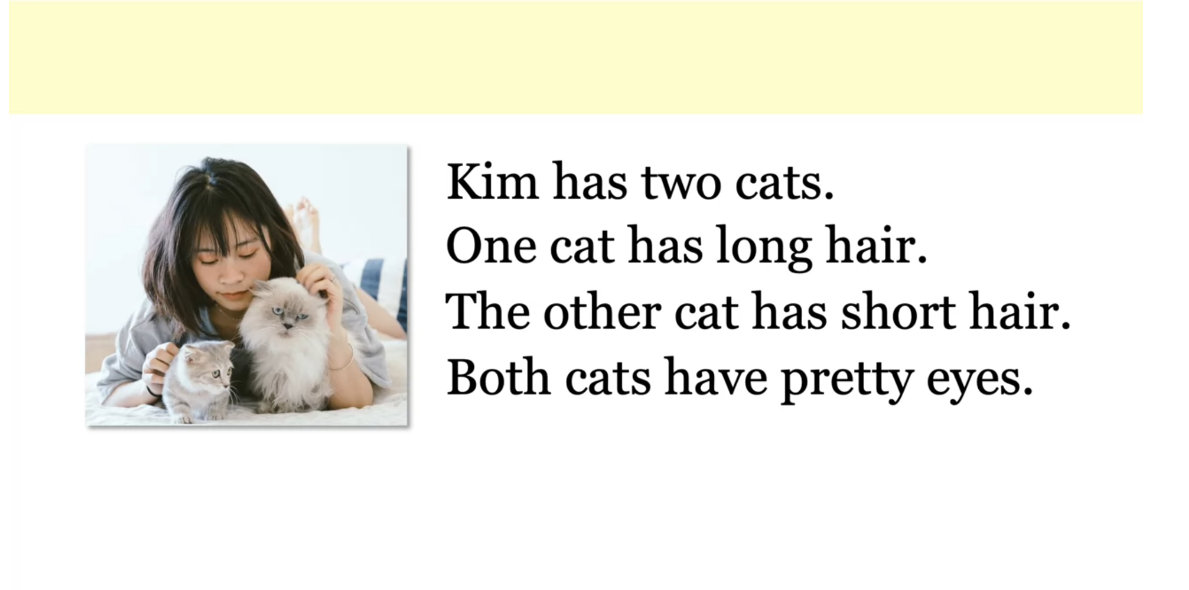
There are many uses of the verb have. She has a baby brother. He has a question. He has breakfast at 7:00. He has fun in the leaves.
Okay, here is the verb chart for do. I do, you do, he does. Notice the pronunciation does not do’s. She does, it does, we do, you do, they do. There are two forms of do in
the simple present, do and does. And again, these all end with an S. Because third person
singular always has an S. Do is also an irregular verb,
so it ends with ES. The spelling is a little
different than a regular verb.
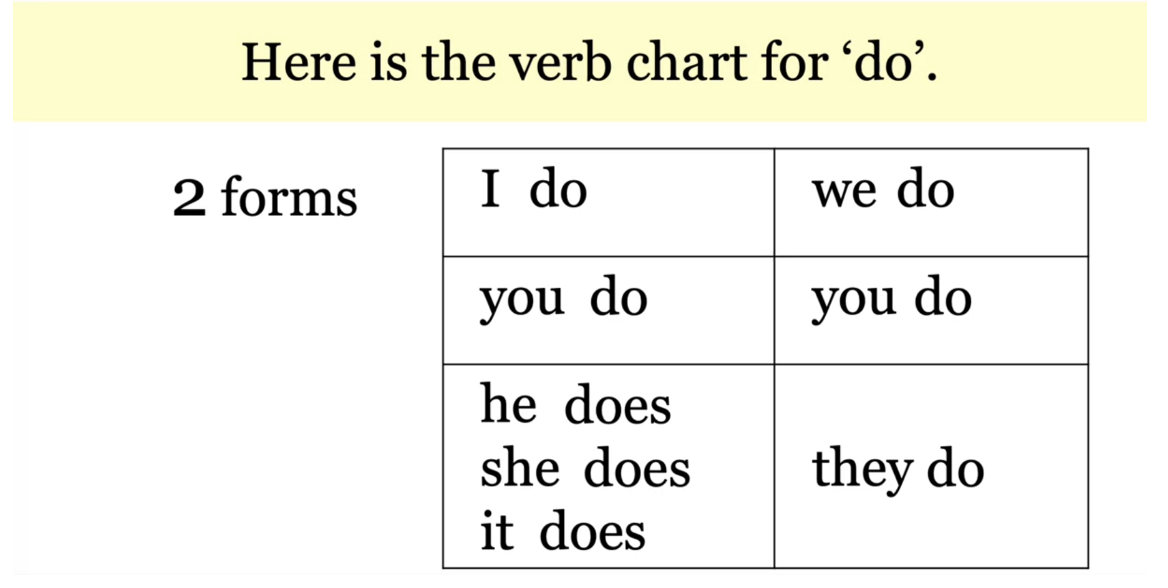
Let’s look at do in some sentences. There are many uses of the word do. She does yoga in the morning. She does homework after school. He does dishes after dinner. She does laundry every day.
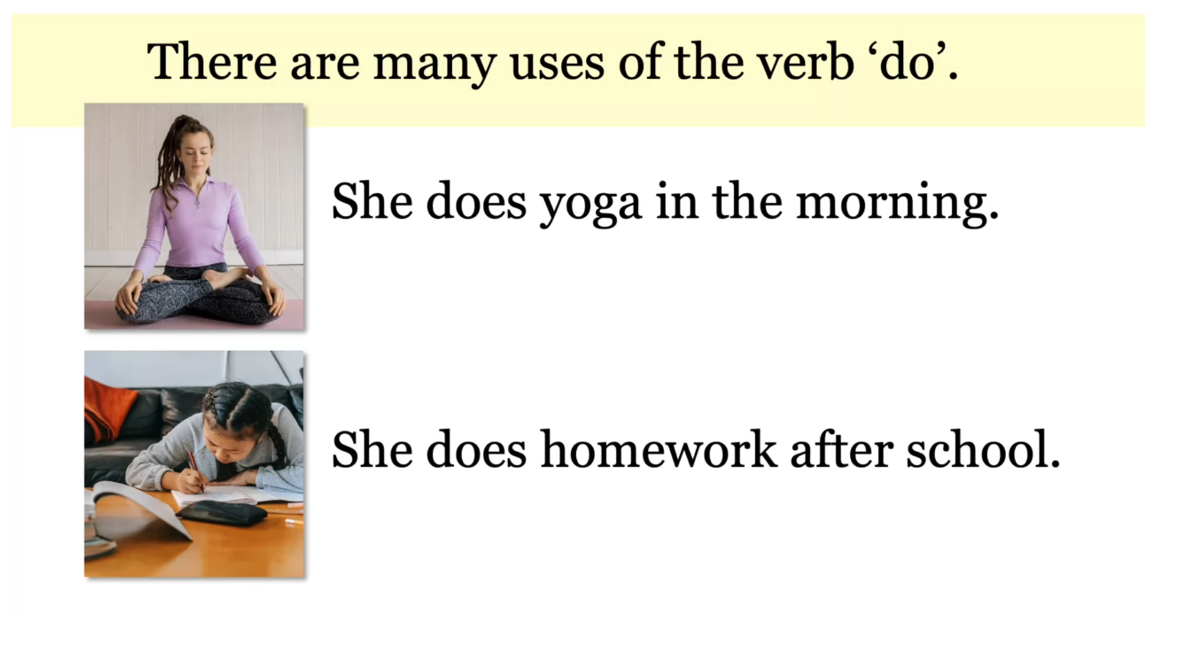
Okay, and go,
here is the verb chart for go. It’s the same pattern. I go, you go, he goes, she goes, it goes, and it’s spelled with an ES. We go, you go, they go. Again, we’ve got two forms, go and goes. And again, these all end with an S. because there’s always an S for third
person singular in the simple present.
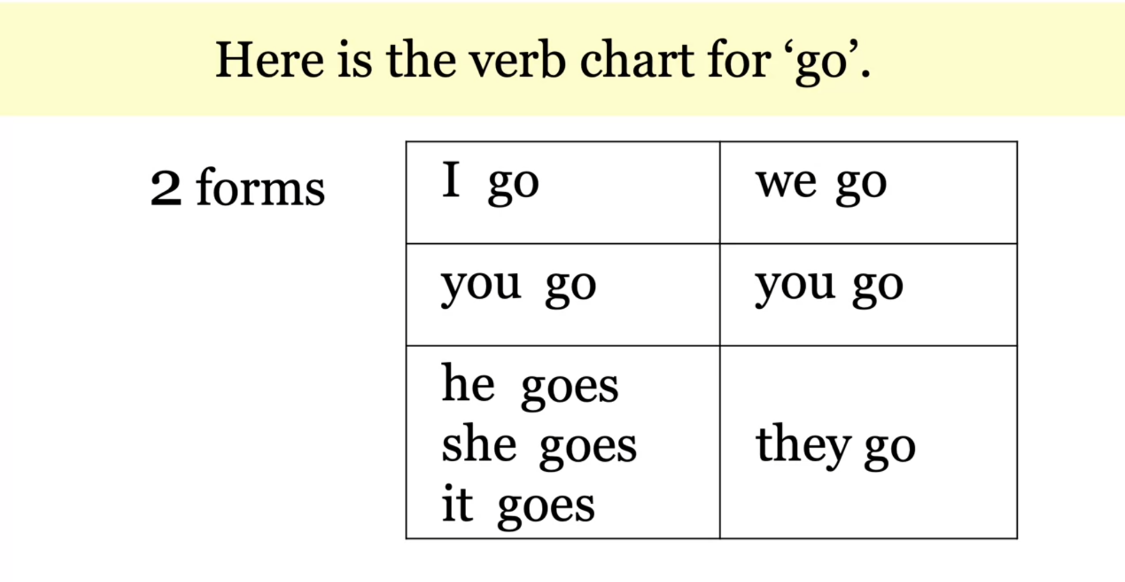
Okay, let’s look at some examples. They go to school. He goes to work. She goes to the store. The family goes for a walk.
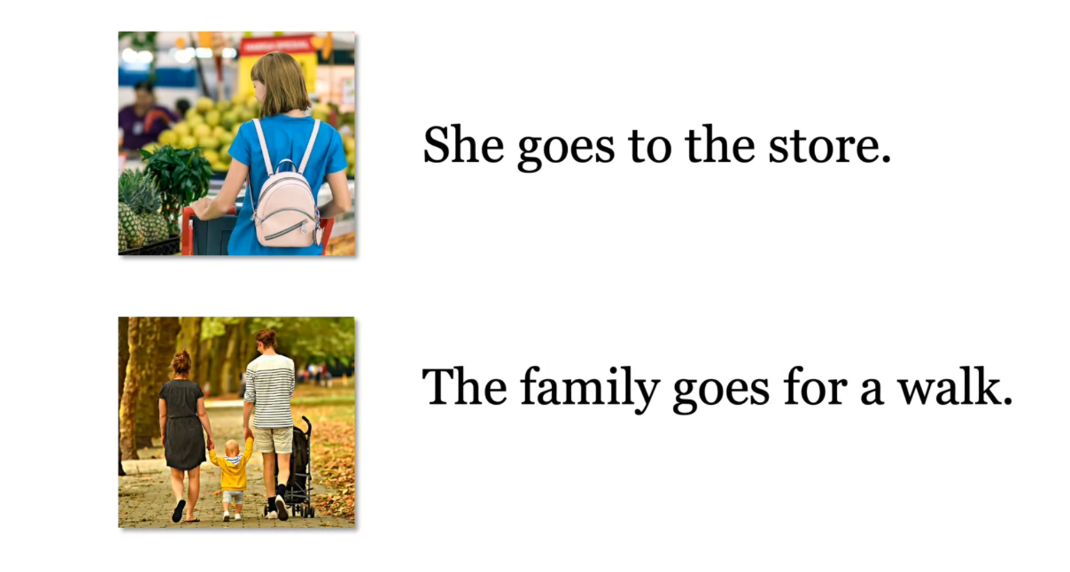
Here are some frequency words. Always, usually, often,
sometimes, rarely, and never. These tell how often something happens. Always, 100% of the time. Usually, lot of the time. Often, almost the same as usually. Sometimes, a little less. Rarely, doesn’t happen often,
almost never. And never, is 0% of the time.
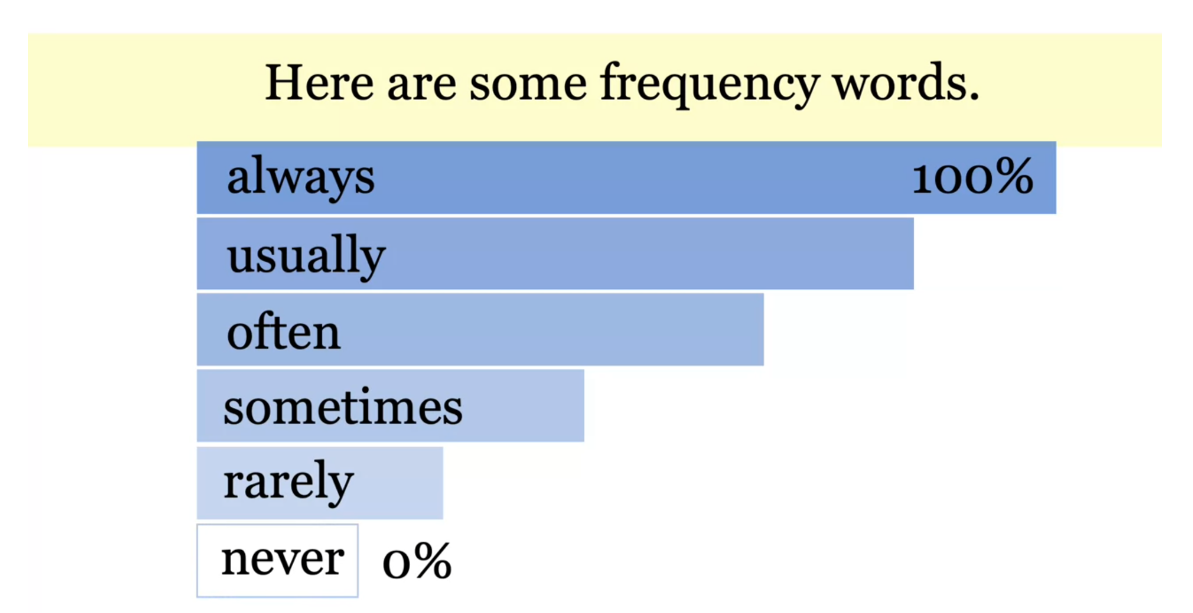
Let’s look at how we use these
with the simple present. Put frequency words before the verb. Let’s look at some examples. Here is a timeline. Sarah goes to the gym. Put the frequency words here,
before the verb, to tell how often she goes to the gym. For example, Sarah always goes to the gym. Sarah usually goes to the gym. Sarah often goes to the gym. Sarah sometimes goes to the gym. Sarah rarely goes to the gym. And Sarah never goes to the gym. We use frequency words a lot
in the simple present. She always goes to the store on Mondays. He often goes to work at 8:00 AM. They never go to school on Saturday.
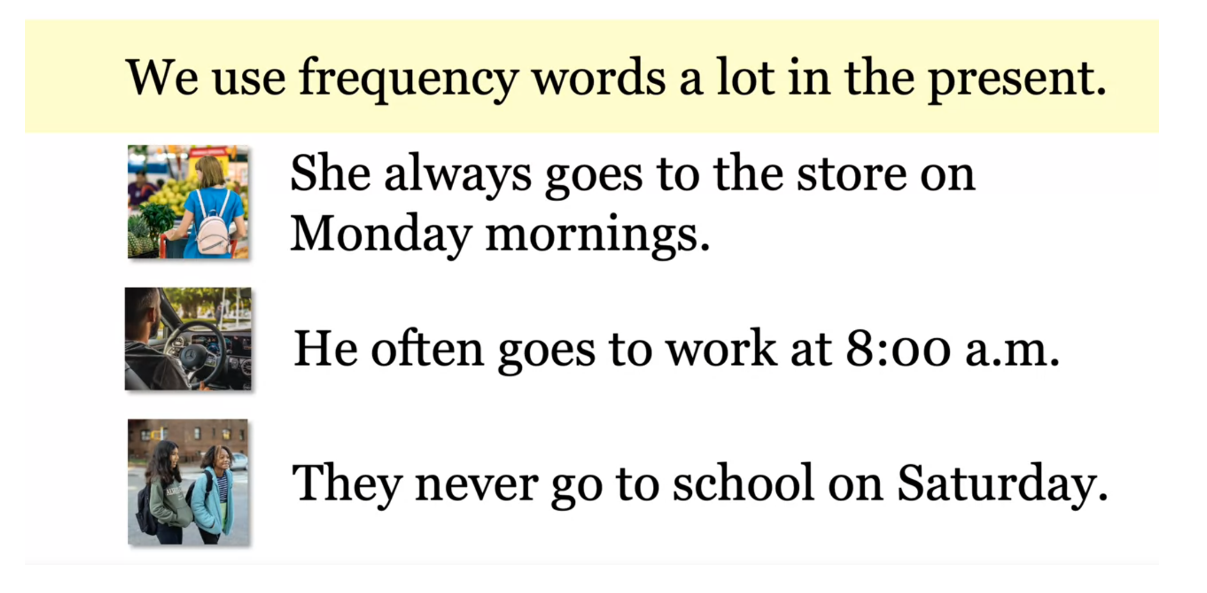
Okay, you try. Put the sentence in the correct order. You have the words, goes,
to the library, Megan, and often. Think, Megan, often, goes, to the library. The frequency word goes before the verb. Okay, let’s do it again. Put the sentence in the correct order. Goes, on Sunday, Bob, usually, to church. Okay, ready? Bob, usually, goes, to church, on Sunday. Okay, one more. Put the sentence in the correct order. Okay. They, never, go, to work, on Saturday. They never go to work on Saturday. Have, do, and go are verbs,
they’re very common. They all have two forms
in the simple present, have/has, do/does, go/goes. We often use them with frequency words. Like always, sometimes, and never. End.
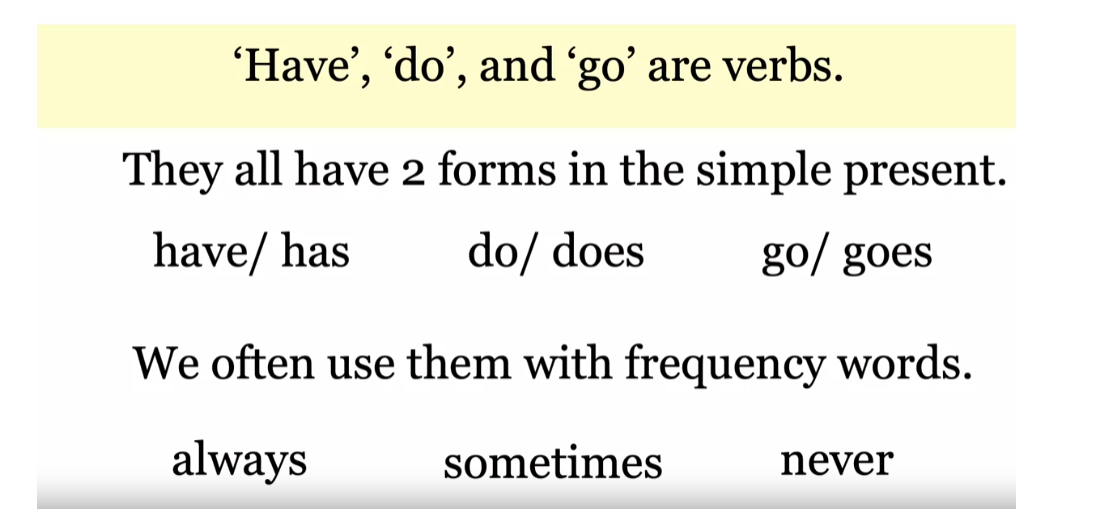
Go, Do & Have (Practice Exercise)
Practice Exercise
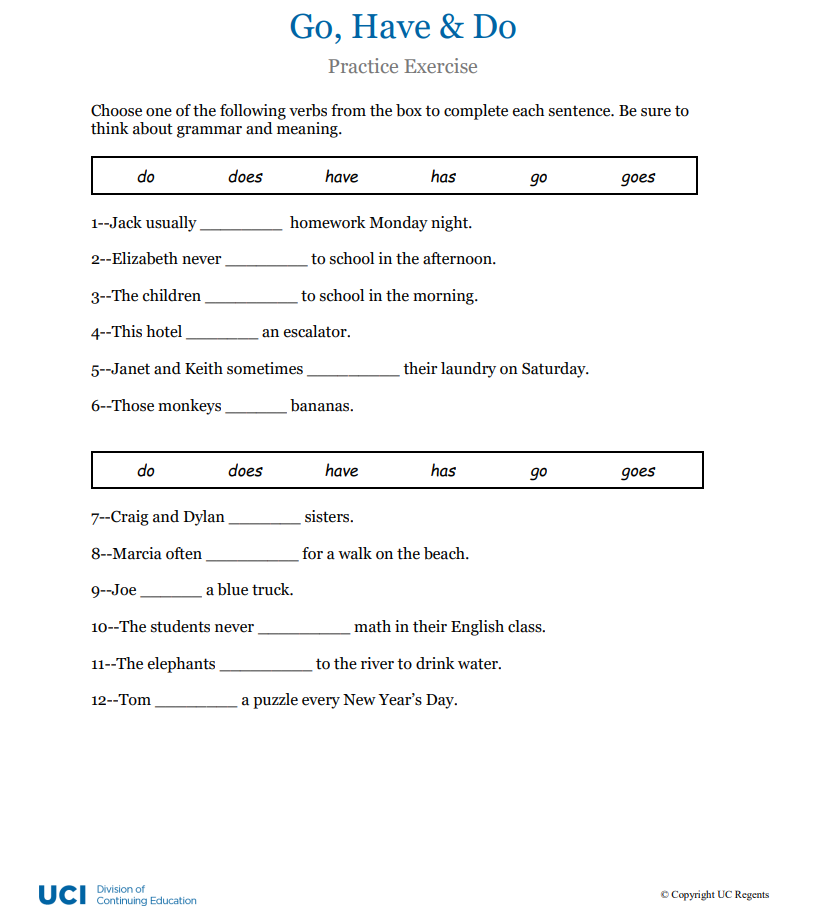
Answer
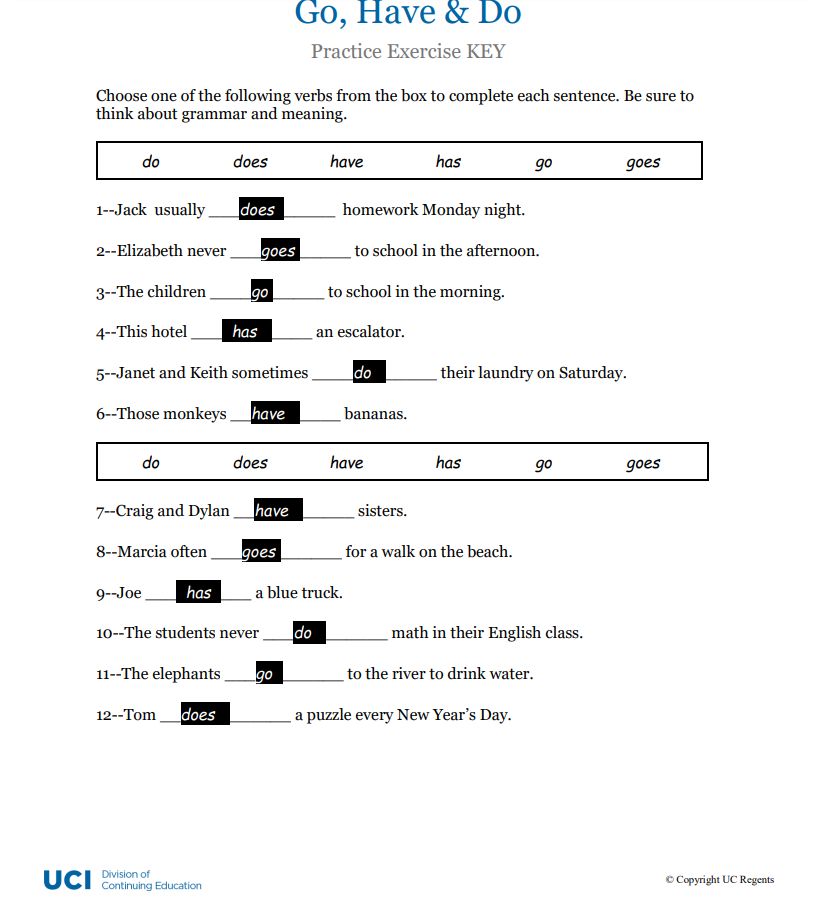
Simple Present Verbs
In this lesson, you will learn about verbs in the
simple present. You know four verbs; be, do, have, and go. These verbs have
irregular forms. There is something
different about the spelling that you
just have to remember. For example, be,
she is a student, is is the be verb. Do, she does homework. Have, she has two cats, and go, he goes to work. In this lesson, we will look at regular verbs in
the simple present, how to form them and
how to use them. There are many verbs. Wave, study, swim, travel, eat, give, love, buy, and help
are just a few of them. But all of them follow the same patterns in
the simple present. Let’s look at this. Ken goes to school at 8:00 AM. He takes his big,
yellow backpack. He waves to his mother. Ken walks to school. His mother stays home. Here is the verb goes, takes, waves, walks, and stays. These are all verbs in
the simple present.
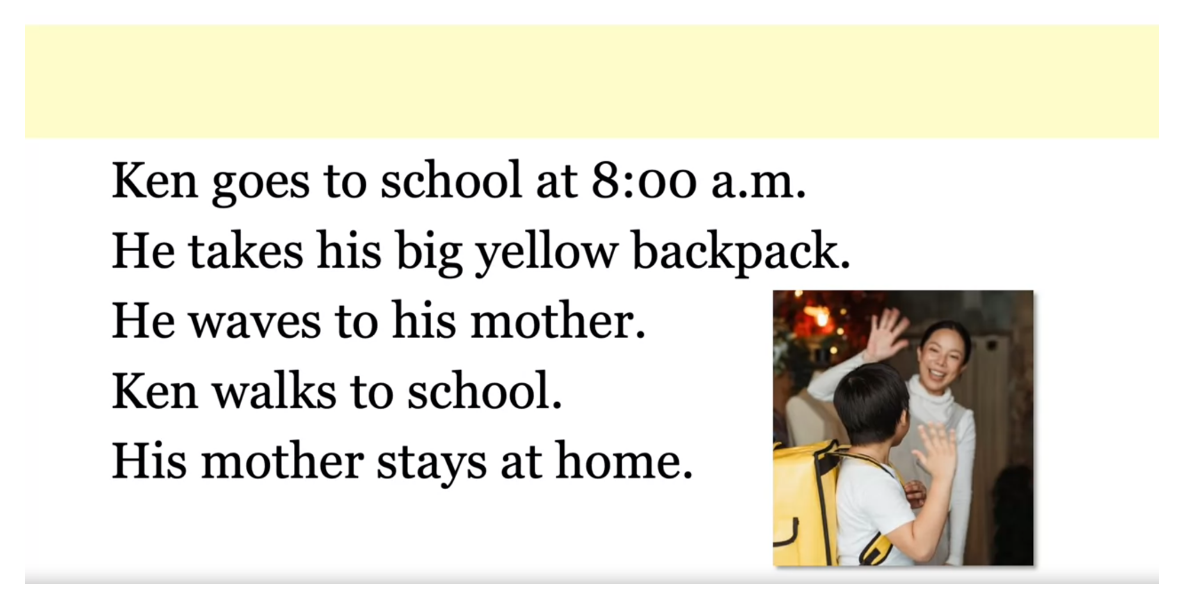
Here is the simple
present verb chart. We’ll just use the verb
talk as an example. I talk, you talk, he talks, she talks, it talks, we talk, you talk,
and they talk. Notice there are two
forms: talk and talks. Notice there’s an ‘s’ on the end of the third
person singular. There’s always an ‘s’ on
the third-person singular.
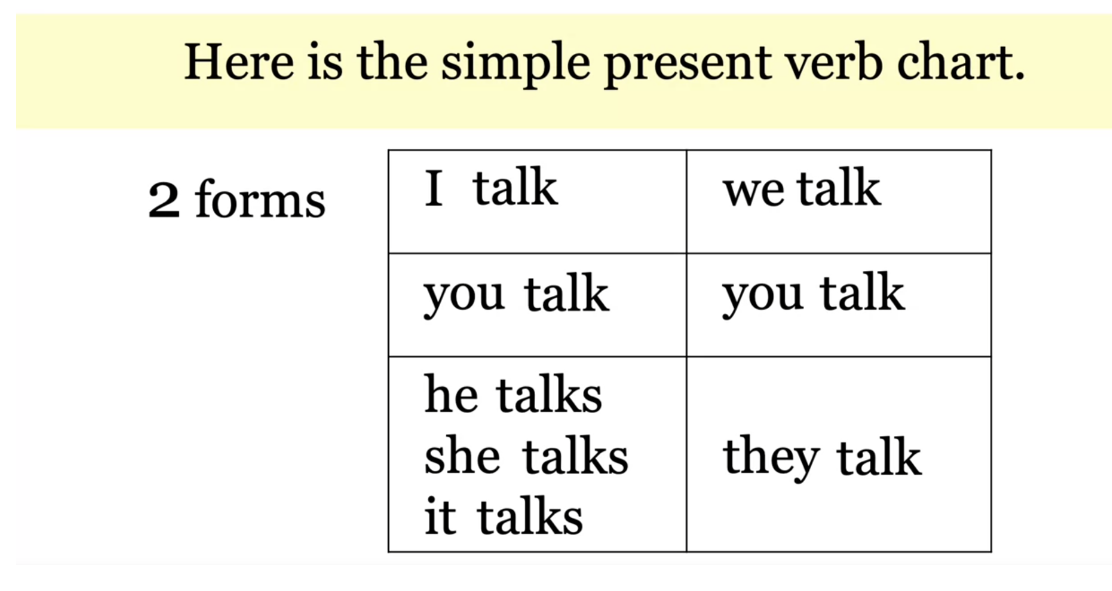
Let’s read this. Jill
has classes all morning. She eats lunch at 1:00. She usually buys lunch
in the cafeteria. Sometimes she eats lunch alone, but she often joins
some friends for lunch. After lunch, she
goes to the library. Look at the verbs for
the subject Jill, they all end with s: has, eats, buys, eats,
joins, and goes.
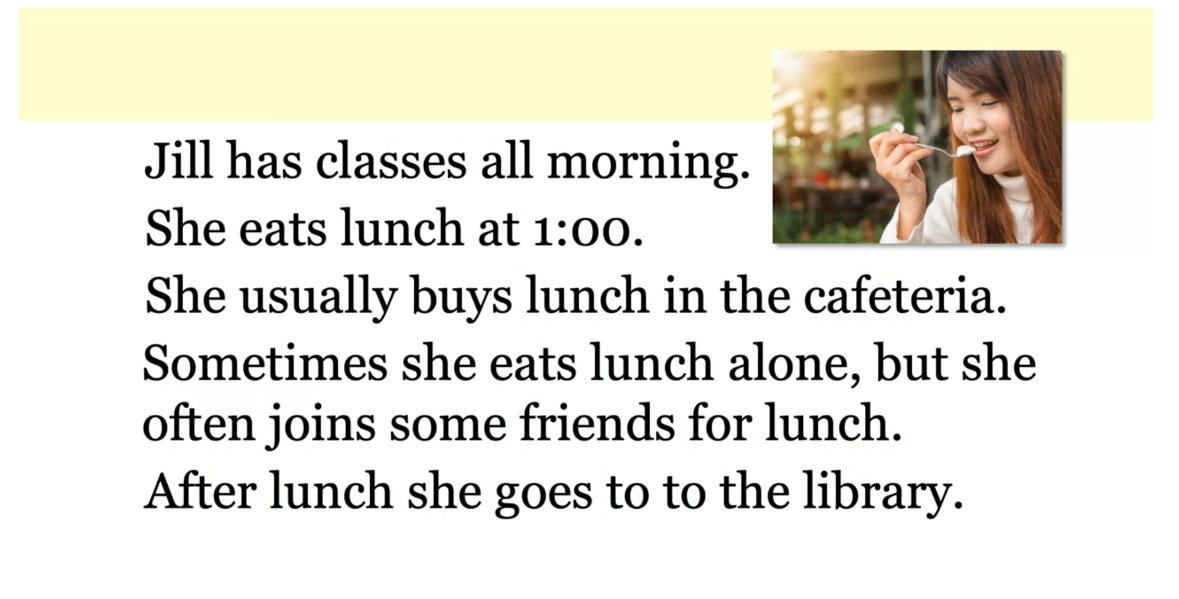
Okay, you try. Here is the verb sleep. What form of sleep
goes in the blank. Sleeps, Paul sleeps a lot. Here the verb is look, Jason and Evan, that’s they. Jason and Evan look at
their phones. One more. Give. Mr. Chen. What form of give
goes in the blank? Gives, Mr. Chen gives his
wife seven pink flowers. Verbs and nouns are different. They have different rules. Let’s take a look. In this sentence, Mr. Chen gives his wife
seven pink flowers. Look at this ‘s’ on gives. This ‘s’ is for third
person singular verb. But look over here, we have
an ‘s’ here on flowers. This ‘s’ is for a plural noun. We have seven pink flowers. The uses are different, but some of the spelling rules
look the same.
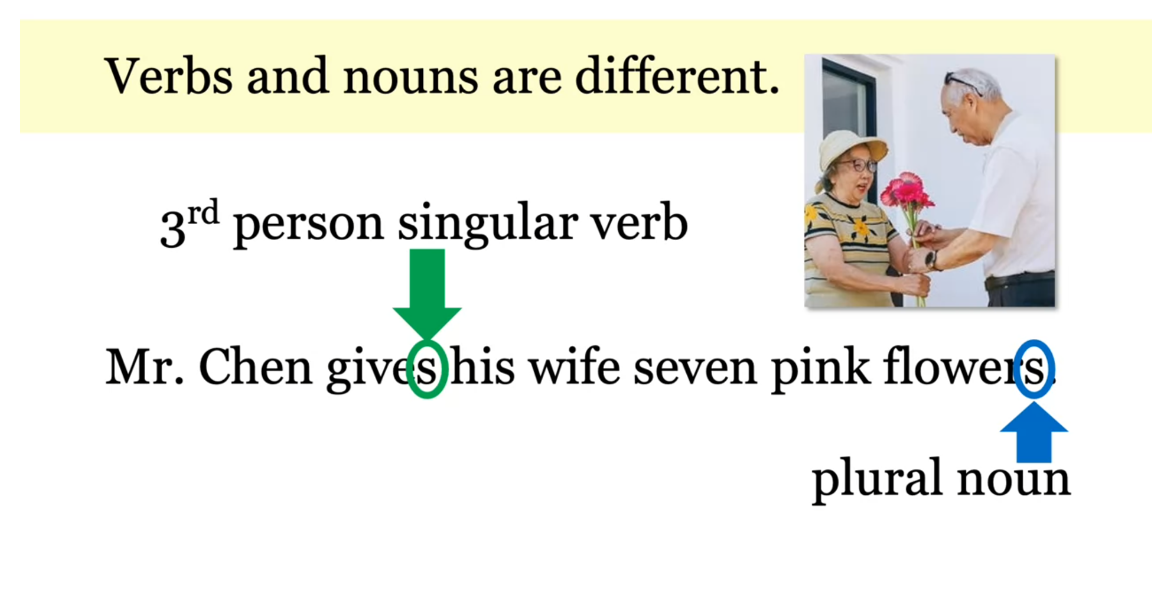
Let’s look. There are spelling
changes with ‘s’. For many verbs, we just add ‘s’, like thinks, and reads. For some verbs, we add ‘es’, like washes and catches. For other verbs, we drop
the ‘y’ and add ‘ies’, like carries and flies.
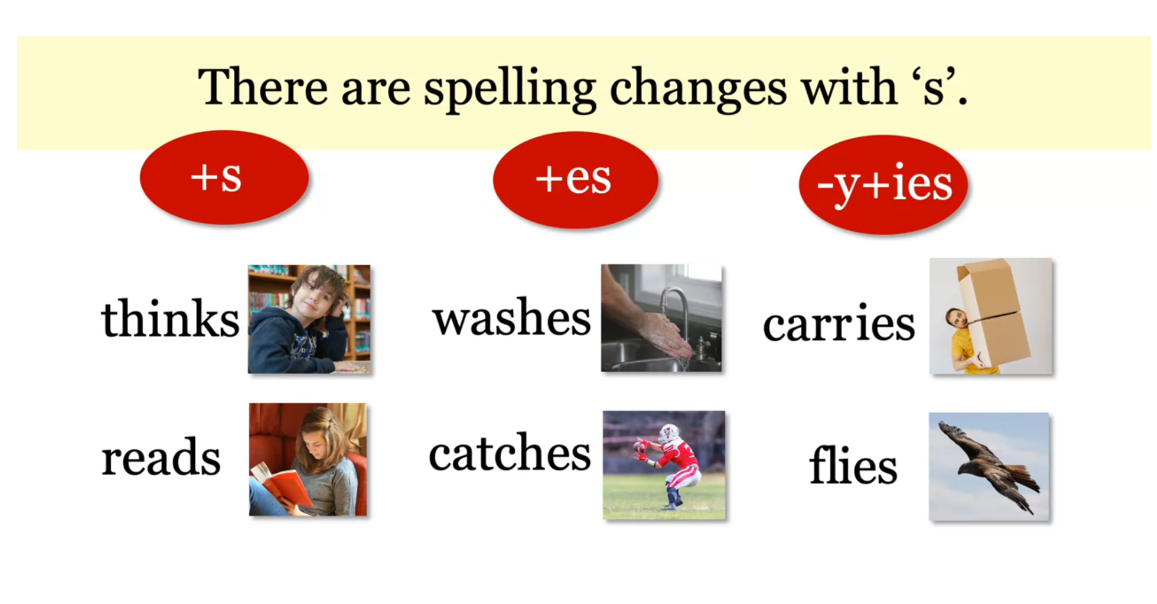
Let’s take a closer
look at these rules. For many verbs, add ‘s’. He thinks she reads, she talks, she eats. Add ‘es’ when a verb
ends with -s, -ch, -sh, -x, and -z, they all have
a ‘sh’ sound on the end. For example, he washes, he catches, he
fixes, she kisses,
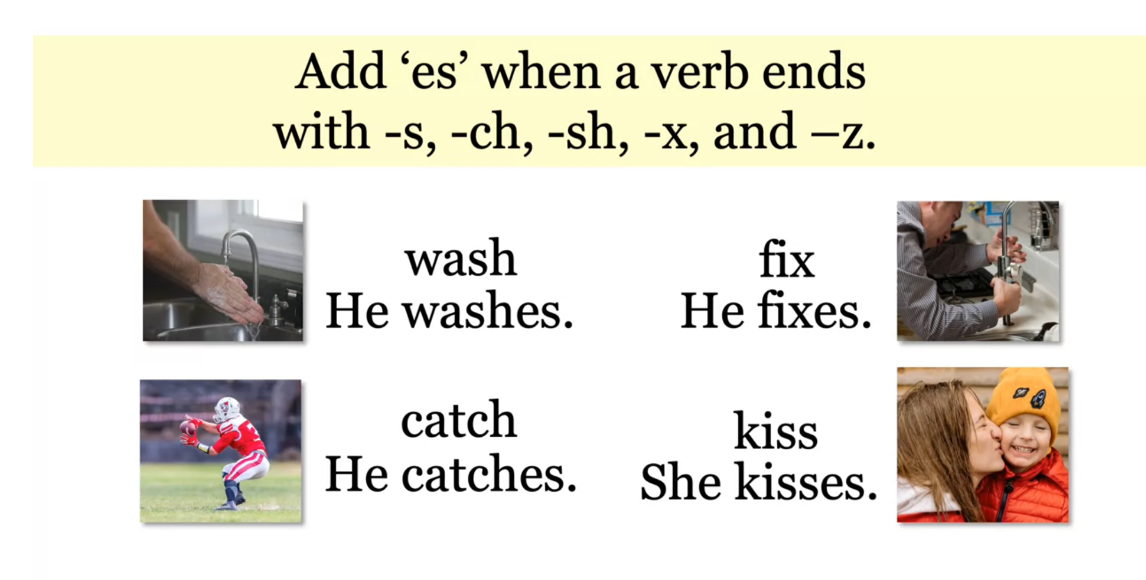
and drop ‘y’ and add ‘ies’ when a verb ends with
a consonant and a Y, for example, he carries, it flies, she worries,
and she studies.
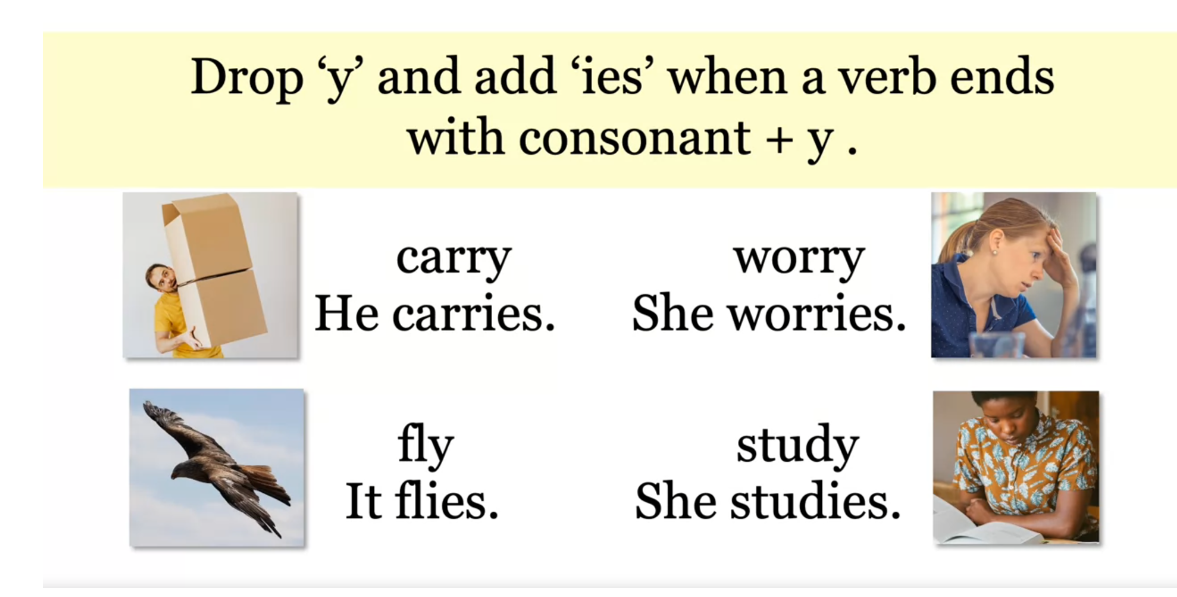
Let’s practice, look
at the verb cry, when we add an s, which spelling rule do we use? Cries, we drop the
‘y’ and add ‘ies’. How about drive? Drives, just add an
s. Clean, cleans, also just add an s. Brush,
look at the ending, -sh, brushes, add ‘es’
because of that -sh ending. Dry, dry ends in a
consonant and a Y, drop the ‘y’ add ‘ies’. Play, plays, just add an s. Remember this is
a vowel and a y, so we just add an s, no need to drop the y, mix, mixes, because
of that -x ending. How did you do? Let’s
practice some more, look at the sentence, she cooks dinner, think, is the verb form correct? She cooks dinner, yes, correct, I speak English, also correct, Tom run fast, no, the grammar here is wrong, there is no -s on runs, we need to add an
-s, Tom runs fast, Pandas eat bamboo, yes, that’s correct, the
friends plays tennis, no, this has an extra -s, we don’t want -s
on plays because the friends is third
person plural like they. You listen very well, yes, that is correct. Remember, watch out
for the -s endings for the third person singular
form in the simple present.
Remember the frequency words? Always, usually, often,
sometimes, rarely, and never, put the frequency word between
the subject and the verb, here we have Bob and Kevin, Bob and Kevin are old friends, they eat lunch
together on Friday. We put the frequency
word right in here, they always eat lunch
together on Friday, they eat lunch
together on Monday, no, they never eat lunch
together on Monday. Put the frequency
word before the verb, after the subject,
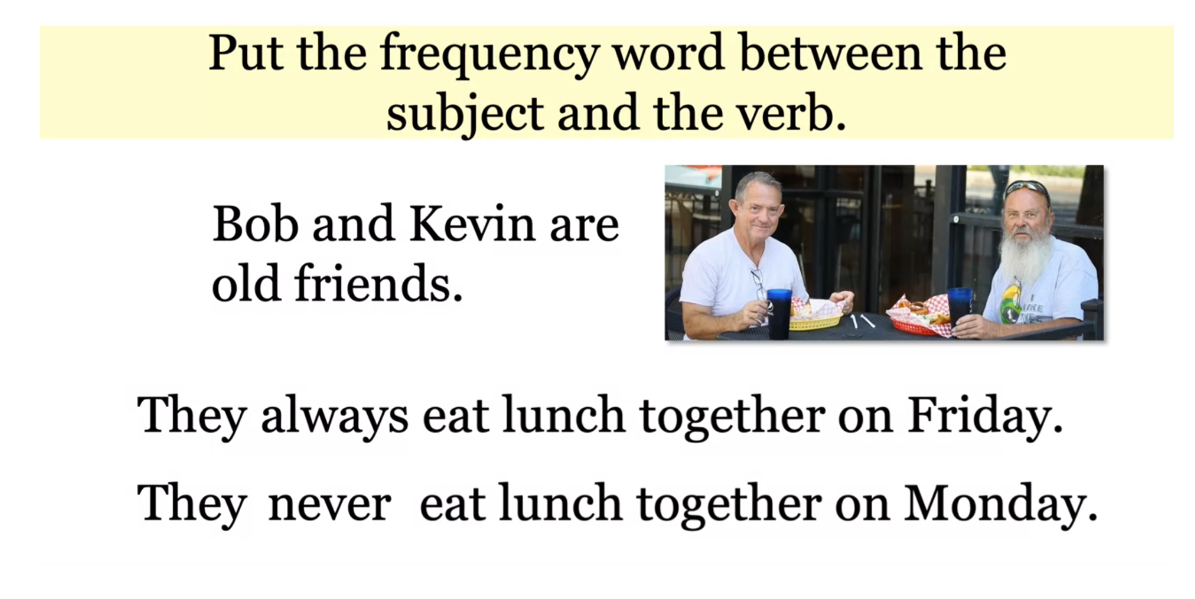
let’s read this, as you listen, notice that every sentence
has a subject and a verb, there are lots of S’s here because it’s
third-person singular, and there are also
some frequency words. Tanner likes to go fishing, he catches trout
and cooks it too. At home he never eats fish when his mother cooks it, however, on camping trips, he
often catches fish, cleans it, cooks it, and eats it too.
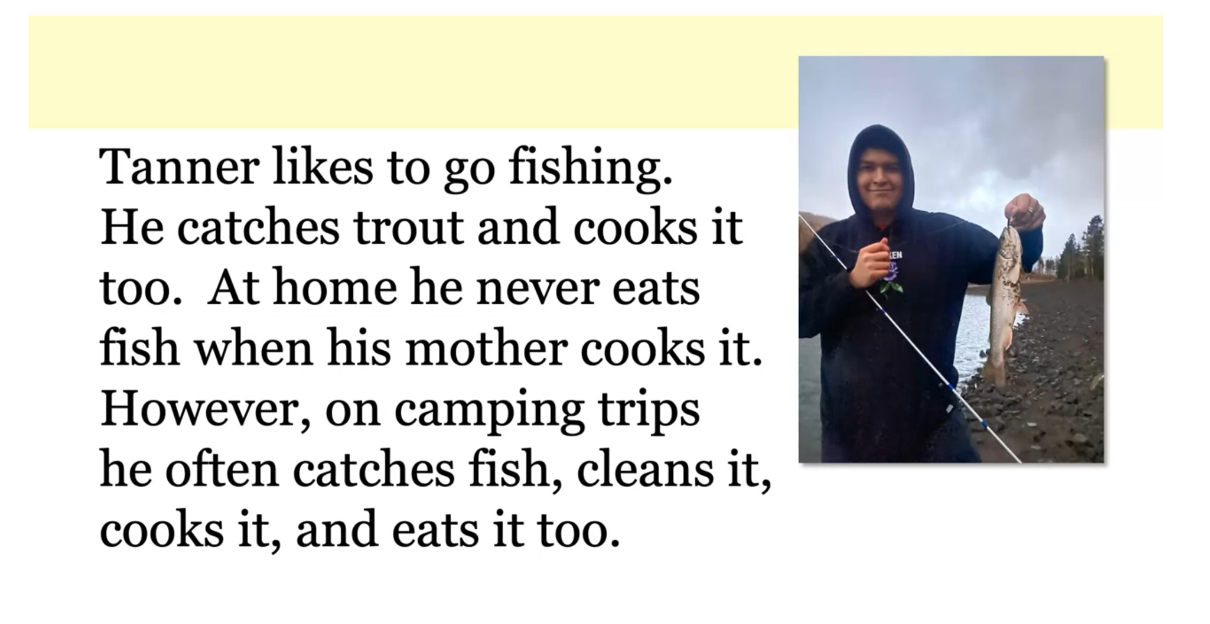
Verbs in the simple
present have two forms, like eat, eats, think, thinks, and give, gives. Third person singular ends
with an -s, he sleeps. There are some spelling
changes when you add the -s, reads, sometimes
you just add -s, catches, sometimes you
add -es, and flies, sometimes you have to drop
that ‘y’ and add ‘ies’.
Simple Present Verbs (Practice Exercise)
Practice
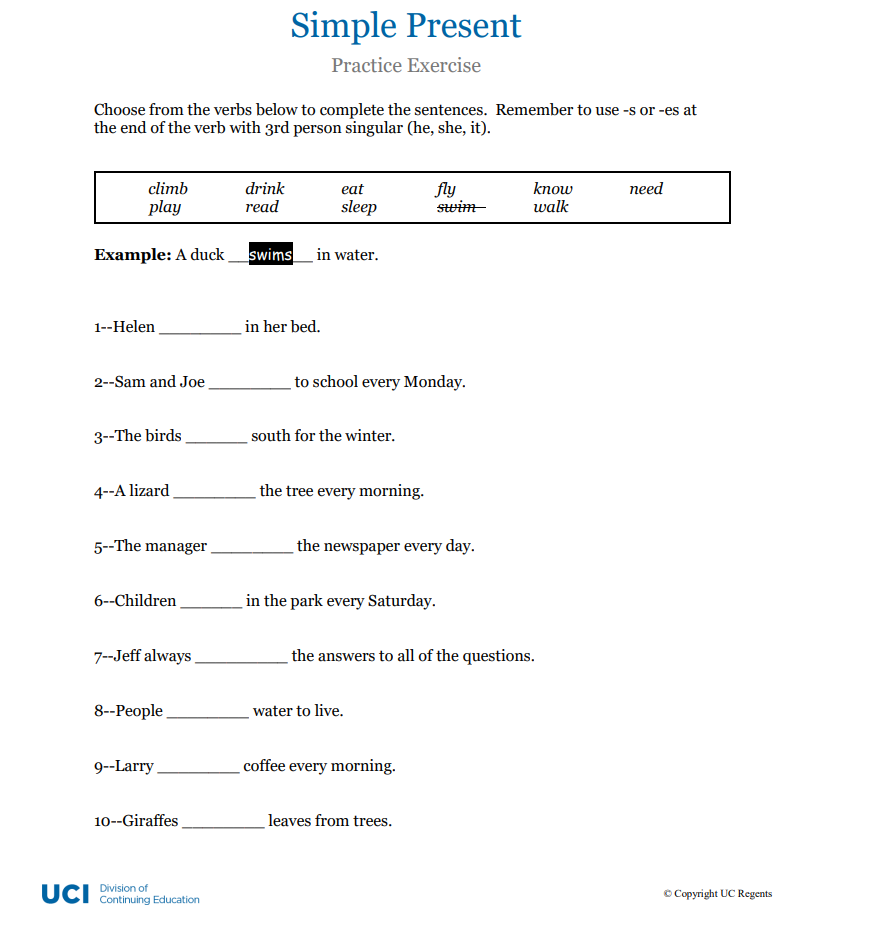
Answer
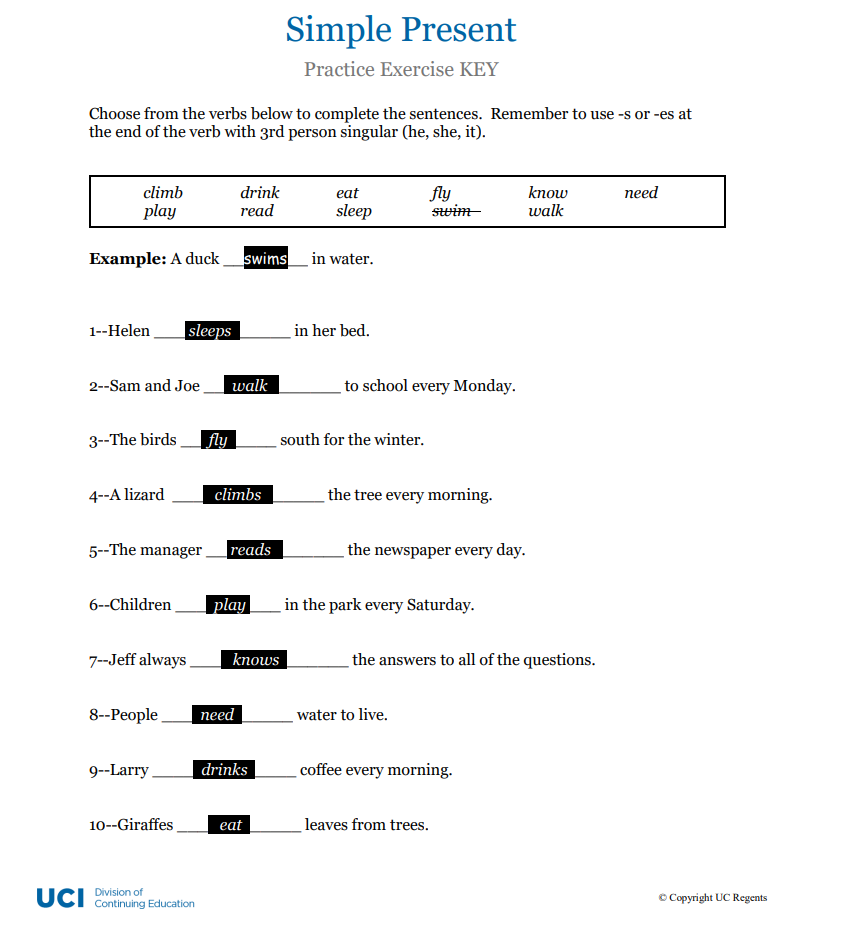
Possessives
Possessive. In this lesson, you are going to
learn about possessive adjectives and apostrophe s. Michelle rides her bike to school,
her bike is pink and her helmet is orange. Brian rides his skateboard to school. His skateboard is yellow and
its wheels are small. Notice these words, her, his, and it’s. These are possessive adjectives. Her, shows that Michelle has a bike, and
that the helmet belongs to Michelle too. His shows the skateboard belongs to brian,
and it’s shows that the wheels
belong to the skateboard.
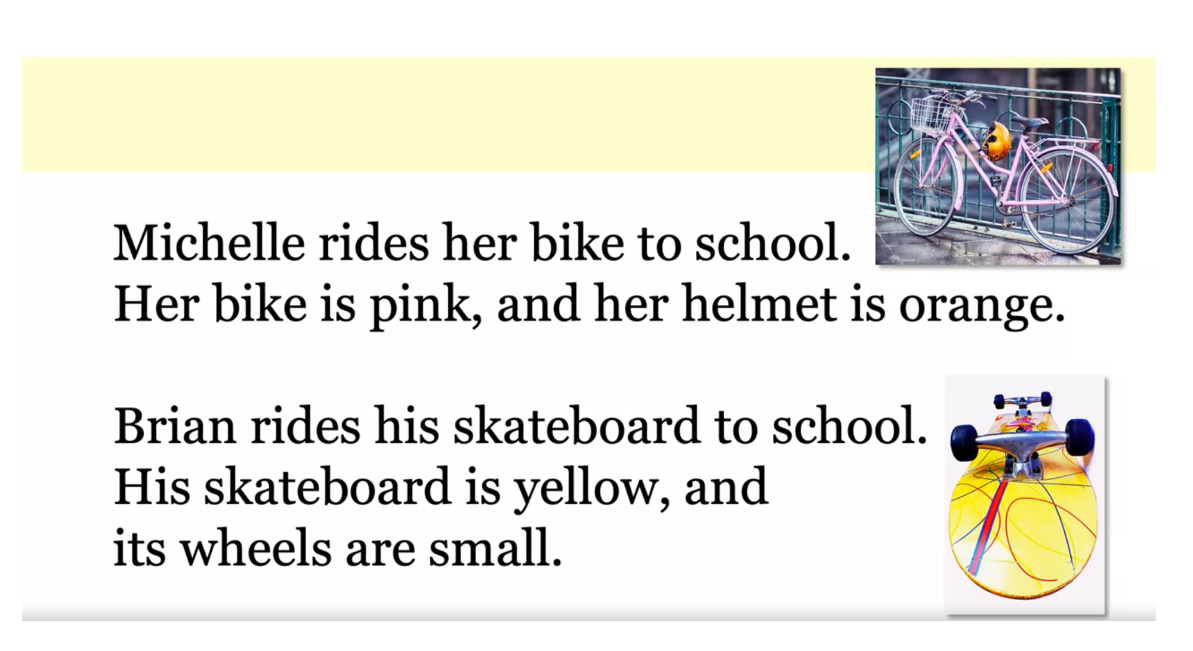
Let’s look at the chart. These are the possessive adjectives, my, your, his, her, it’s our, your, and there. Posses is another word for have, so these adjectives show what
different people or things have. For example, it is a blue book, it is my book, it isn’t your book. In the first sentence,
blue is the adjective. In the second sentence, it is my book, I use a possessive adjective to show
you that the book belongs to me. In the third sentence, I use a possessive adjective to show you
that the book does not belong to you.
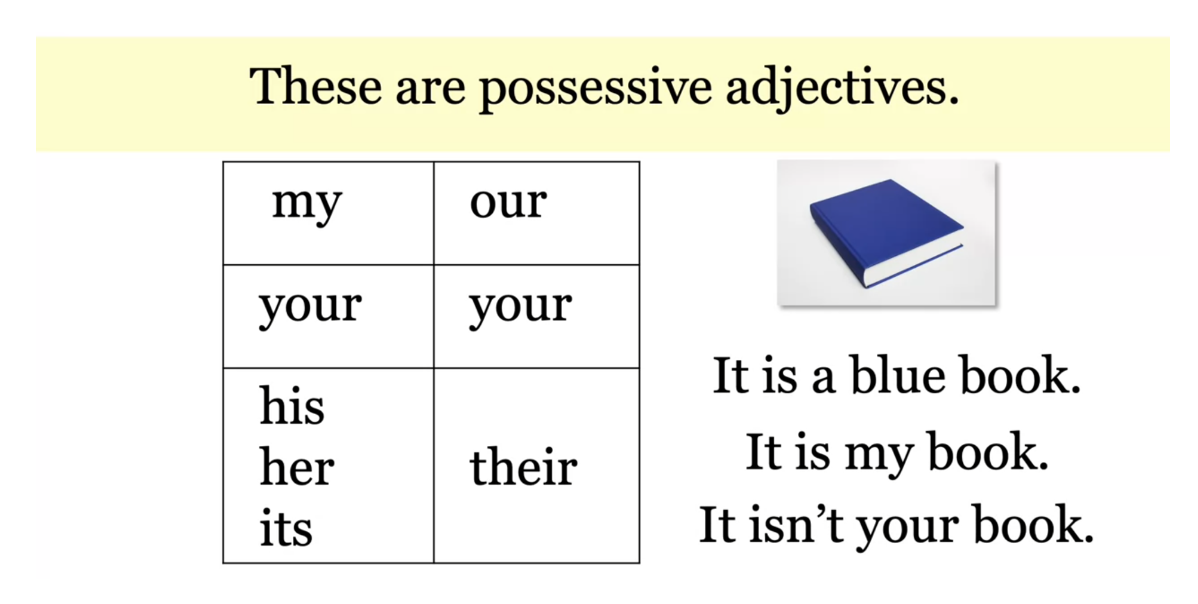
Here is another example. Tyler walks to school every day. His school isn’t far. He always takes his red backpack. Again, we use his to show
you Tyler has a school and his to show you that Tyler has a backpack. It’s his red backpack.
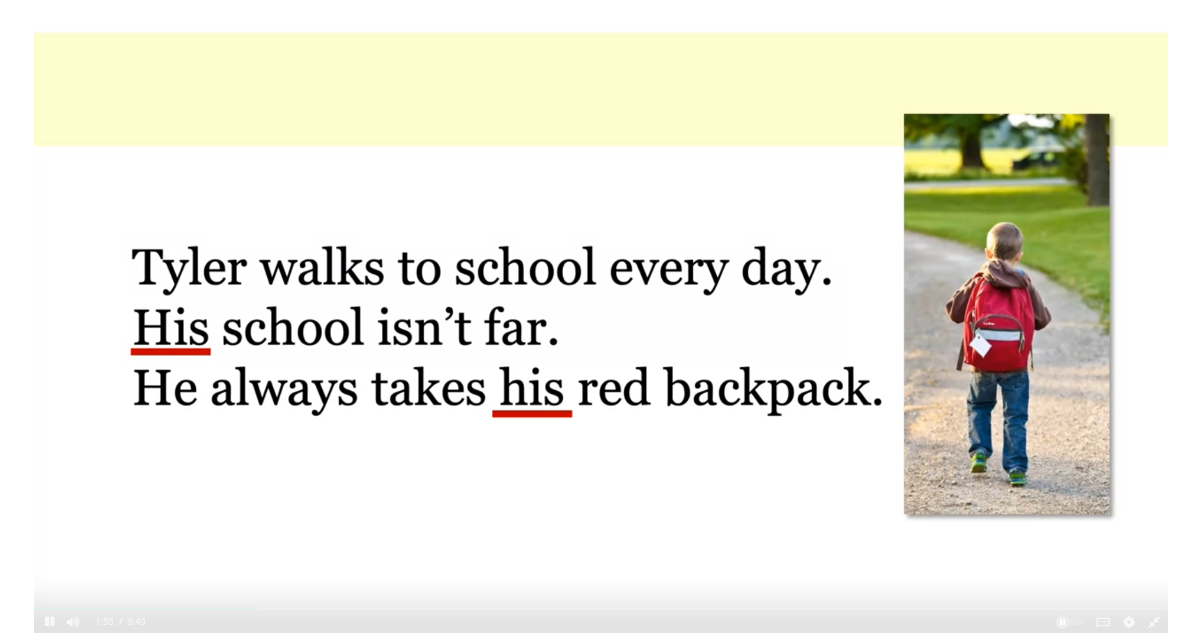
Now you try. Here we have Mary and
Marge, they are sisters. Can you fill in the correct
possessive adjectives? Ready? Okay, Mary and Marge are sisters. Mary is on the left, her hat is orange. Marge is on the right,
her shirt has pink flowers. They often check their phones.
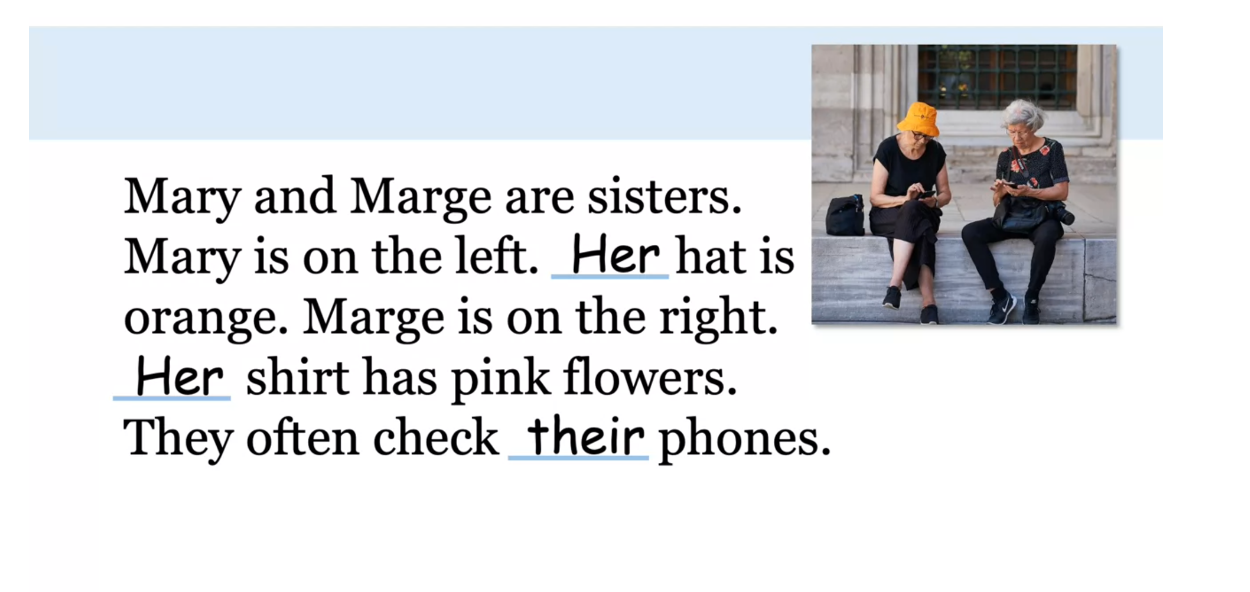
Okay, let’s try again. Okay, here we have Jay and
he loves soccer. What possessive adjectives
go in the blanks? Jay loves soccer, but
his team isn’t very good because the team belongs to Jay or
Jay has a team. And Jay is the only other subject here,
so it has to be his. Okay, Jay loves soccer but
his team isn’t very good. They lost 5 of their last 6 games. And why is it their? Because they is the subject
of the sentence, they are the ones with the games.
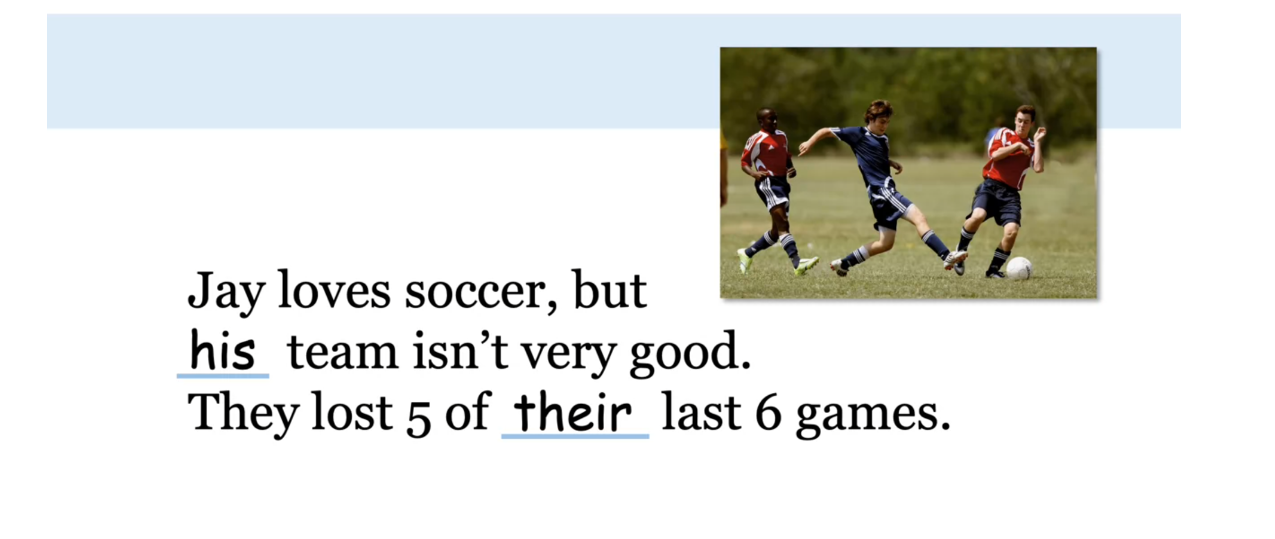
One more time, you and
I have class together. Okay, which possessive adjectives go? We are talking about you and I. Our classes are about grammar. I make videos on my computer. You watched the videos on your computer,
or phone.
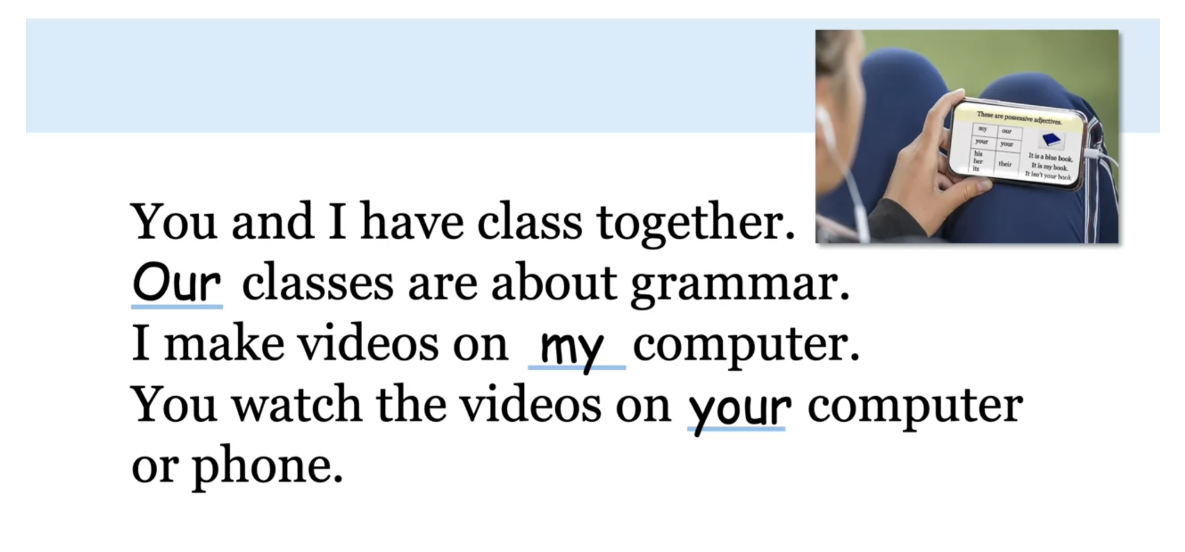
Okay. Here we have more examples. Amy has a new puppy,
her puppy is very friendly. His name is rex, he’s 3 months old. Amy’s puppy is cute. Okay, what do we have here? I see an apostrophe S. And you know that this is he is,
he is 3 months old. He’s Rex, he’s 3 months old. But look here,
I’ve got another apostrophe S. And this is not the beaver
because it doesn’t make sense. Amy’s puppy is cute, that doesn’t work. So this s a different
kind of apostrophe s, this is a possessive, let’s look.
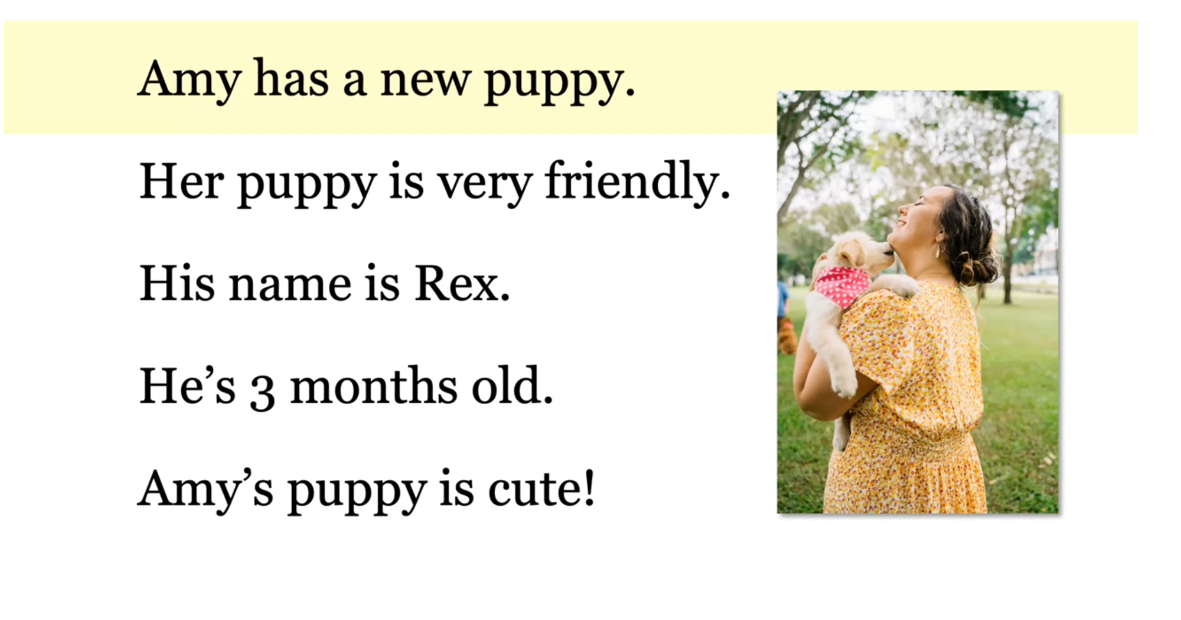
Amy’s puppy is cute. This mark is an apostrophe right here, but this is not a contraction,
like the other apostrophes you know. This apostrophe shows
that Amy has a puppy. It’s a possessive,
the puppy belongs to Amy.
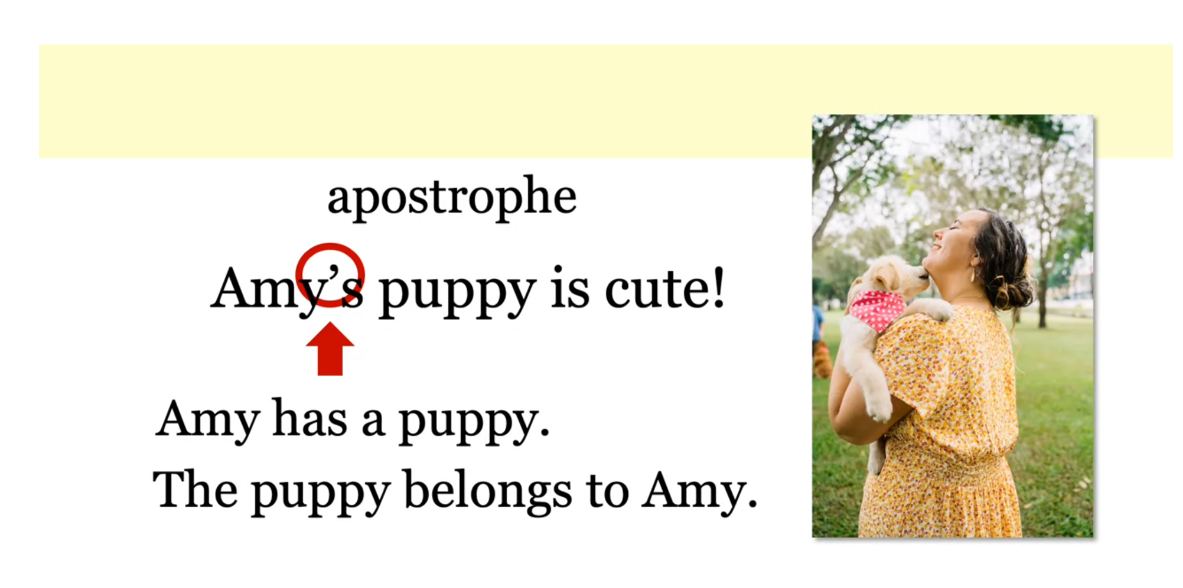
Let’s look at some more examples. Tom and Dylan walked to school. Tom’s shirt is orange,
Dylan shirt is black. Their classes start at 8:30. Okay, look Tom’s shirt,
Tom’s shirt is orange, so I know that the guy with
the orange shirt is Tom. Dylan’s shirt is black, so
I know this boy here with the black shirt is Dylan because
the shirt belongs to him. That’s what this apostrophe s shows us. Their classes start at 8:30.
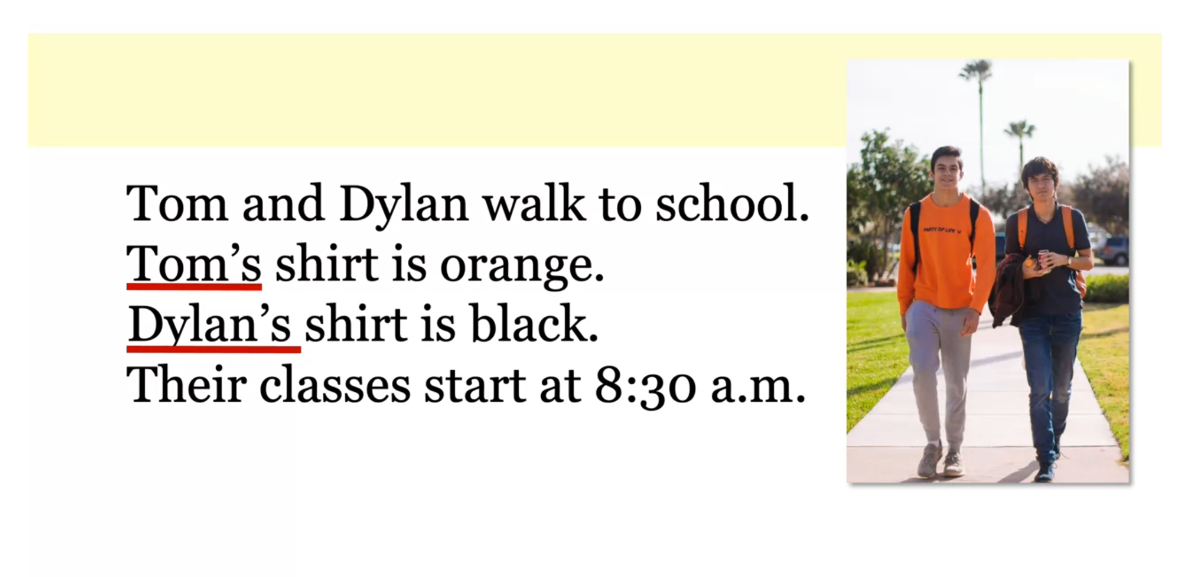
Tom and Dylan both have sisters. Tom’s sister is 14,
she goes to their school. Dylan’s sister is 5 years old,
she’s in kindergarten. So again, we’ve got Tom’s sister
that shows he has a sister. Dylan’s sister, that apostrophe s shows
Dylan has a sister, but what’s this? This is she’s in kindergarten. This is a contraction, this is she is.
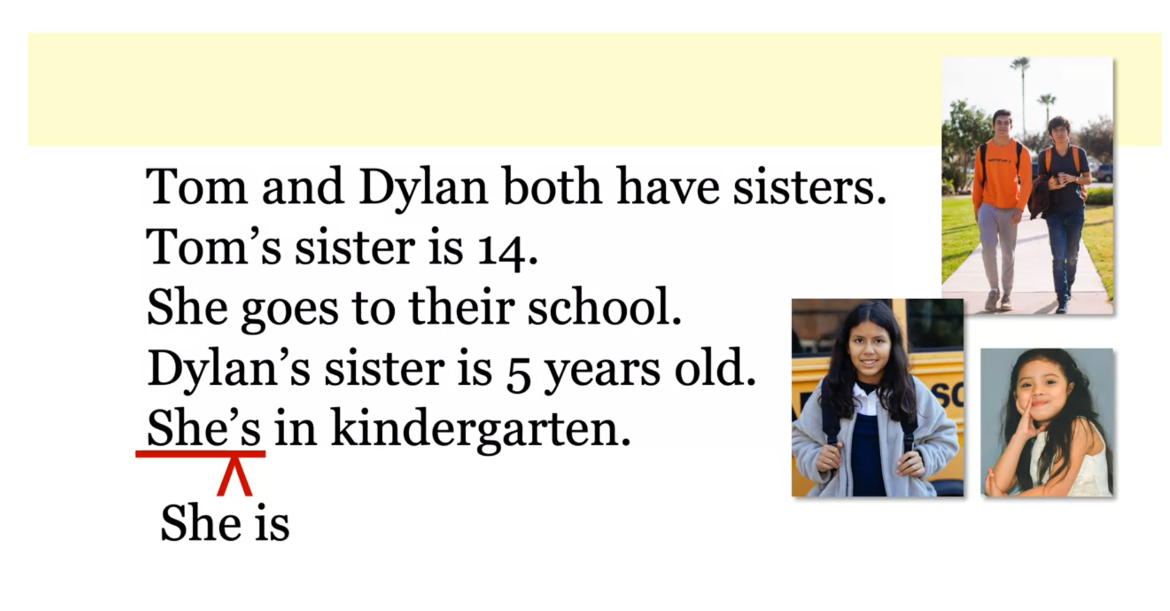
Be careful with the apostrophe. Here we have two pictures,
on the right, it’s cold today. On the left, its teeth are sharp. It’s and its in these two sentences
sound exactly the same, but when I write them, it’s cold today is
a contraction of it is cold today. So I use the apostrophe s, but
over here its teeth are sharp, means the teeth that belonged
to the crocodile are sharp. This is a possessive adjective and
the possessive adjective, its doesn’t get an apostrophe,
that’s the only difference.
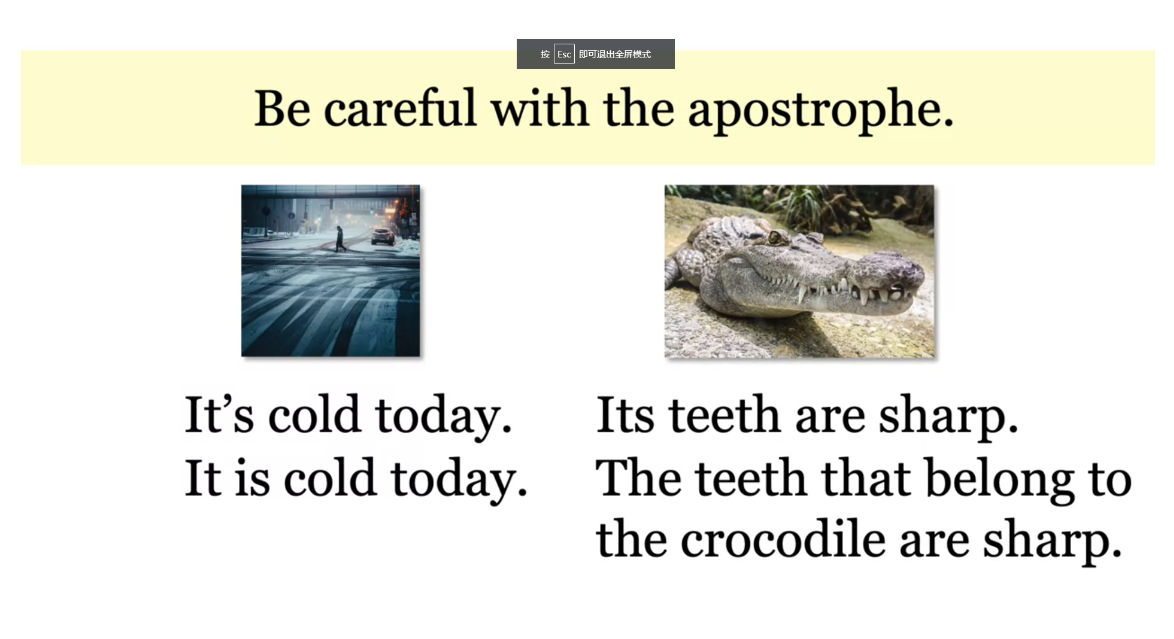
Let’s see if you understand,
you are going to see a sentence. Look at the sentence and
think is it a contraction of the be verb or is it a possessive? Sam’s dog runs fast. That’s a possessive. Sam has a dog. The girl’s dress is purple. Also a possessive, the girl has a dress. It’s a beautiful day. That one is, it is,
it’s a beautiful day is the be verb. Its ears are long, this is a possessive, its without the apostrophe
is a possessive adjective. He’s a happy man,
he’s with the apostrophe is he is, that is the be verb, okay? One more thing about possessive and
the apostrophe s. If the word is plural,
put the apostrophe after the s. So here you see two sentences. The boys have sisters. The boys’ sisters are smart. Boys sounds the same in both sentences,
but do you see this apostrophe? This shows me that the boys have sisters. We put the apostrophe after the s for
plural. Here’s another example,
if I have 1 boy and he has 2 sisters, it’s boy’s sisters with
the apostrophe before the s. If I have 2 boys who have 2 sisters, then the apostrophe goes after the s.
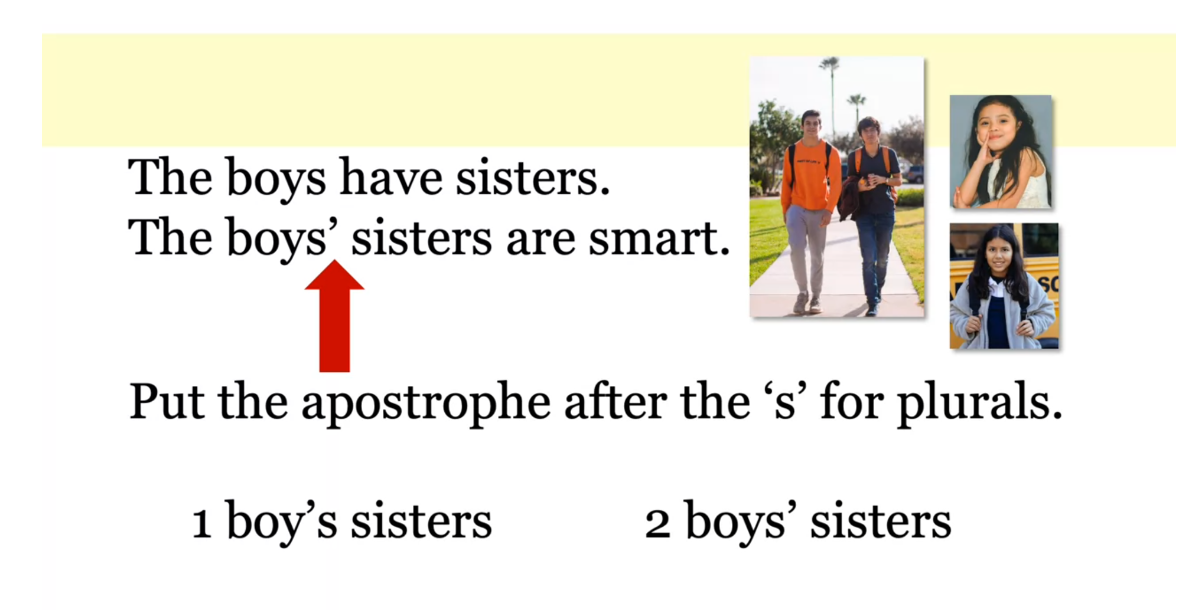
Let’s take a look at one more example. The girl’s uniform is red and white, there is one girl,
the apostrophe comes before. The girls’ uniforms are red and
white, and now I have plural girls. Do you see the apostrophe before the s for
singular? After the s for plural? You learned in this lesson that
possessive forms show what belongs. She rides her bike,
he rides his skateboard, the possessive adjectives her and his show that she
has a bike, and he has a skateboard. Amy’s puppy is cute. The players uniforms are red and white, the apostrophe s shows that Amy has
a puppy, and the players have uniforms.
Possessives (Practice Exercise)
Practice
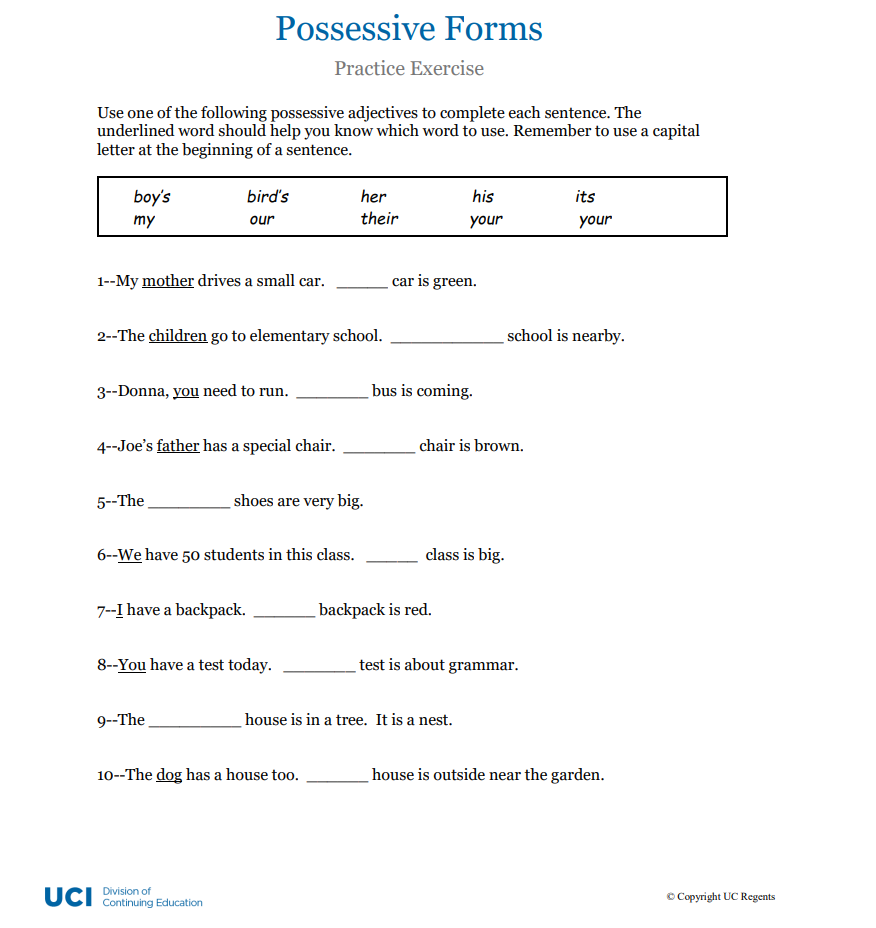
Answer
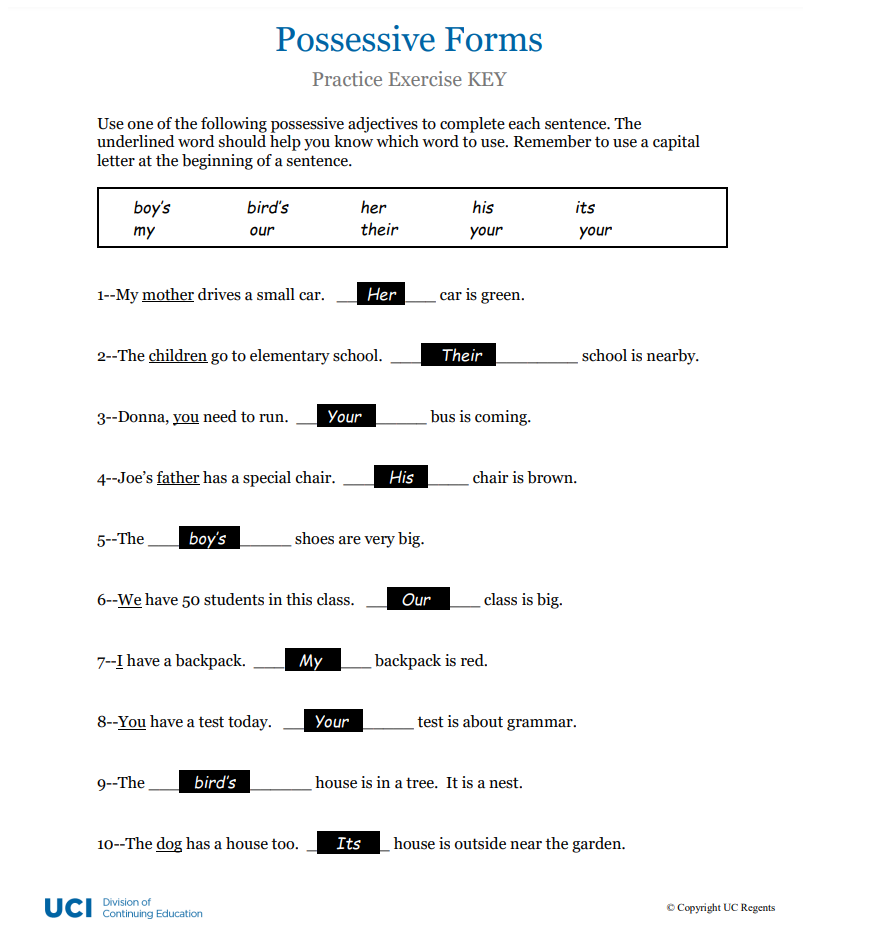
Quiz: Simple Present
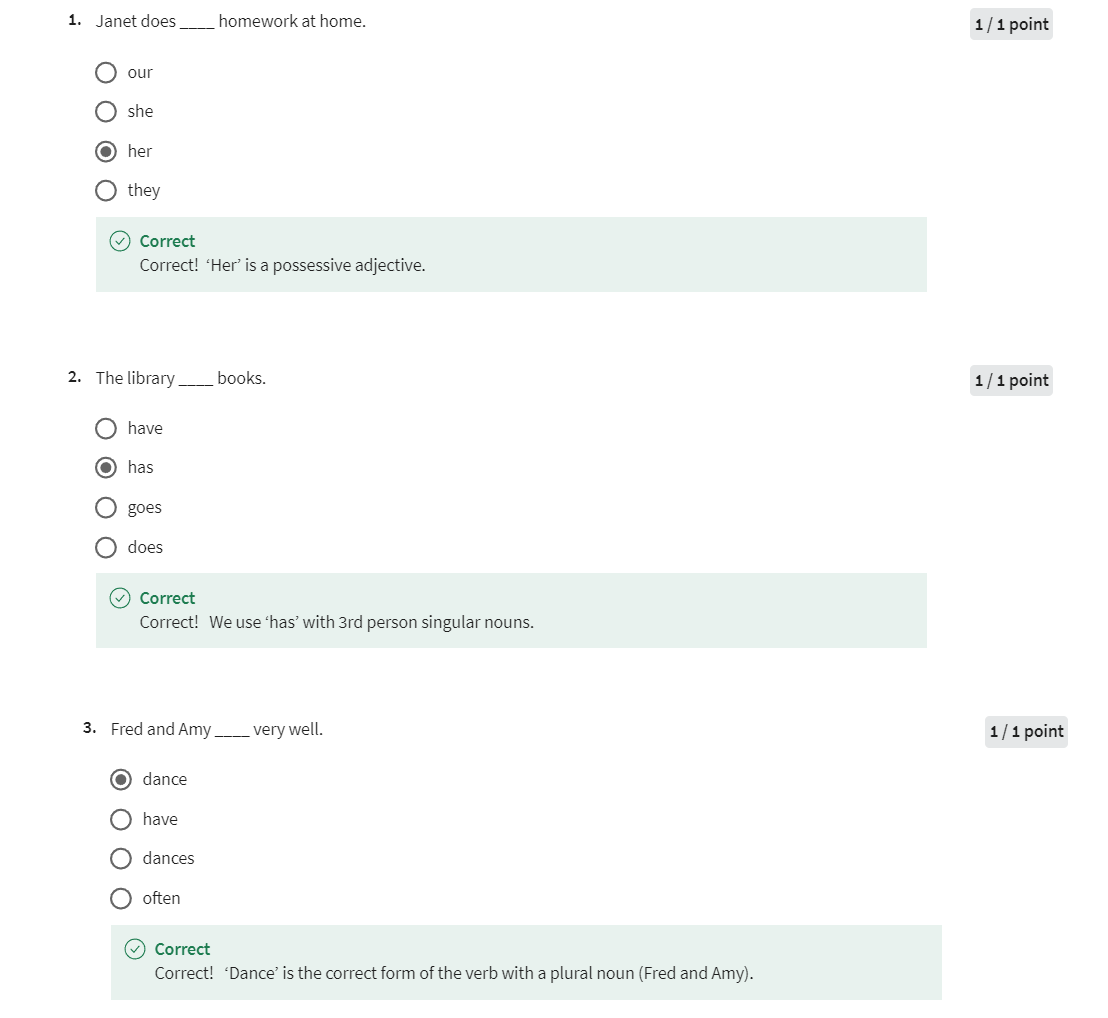
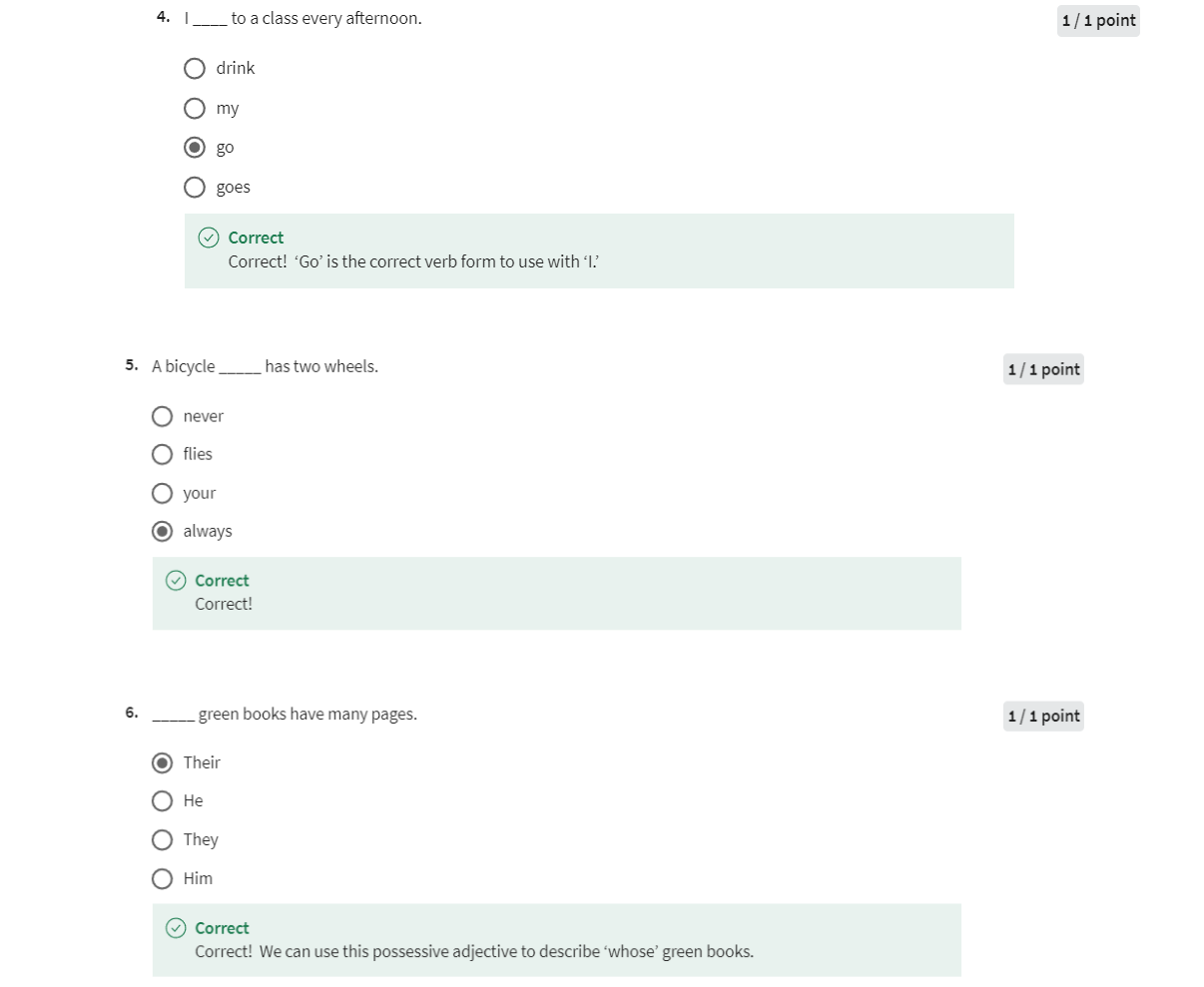
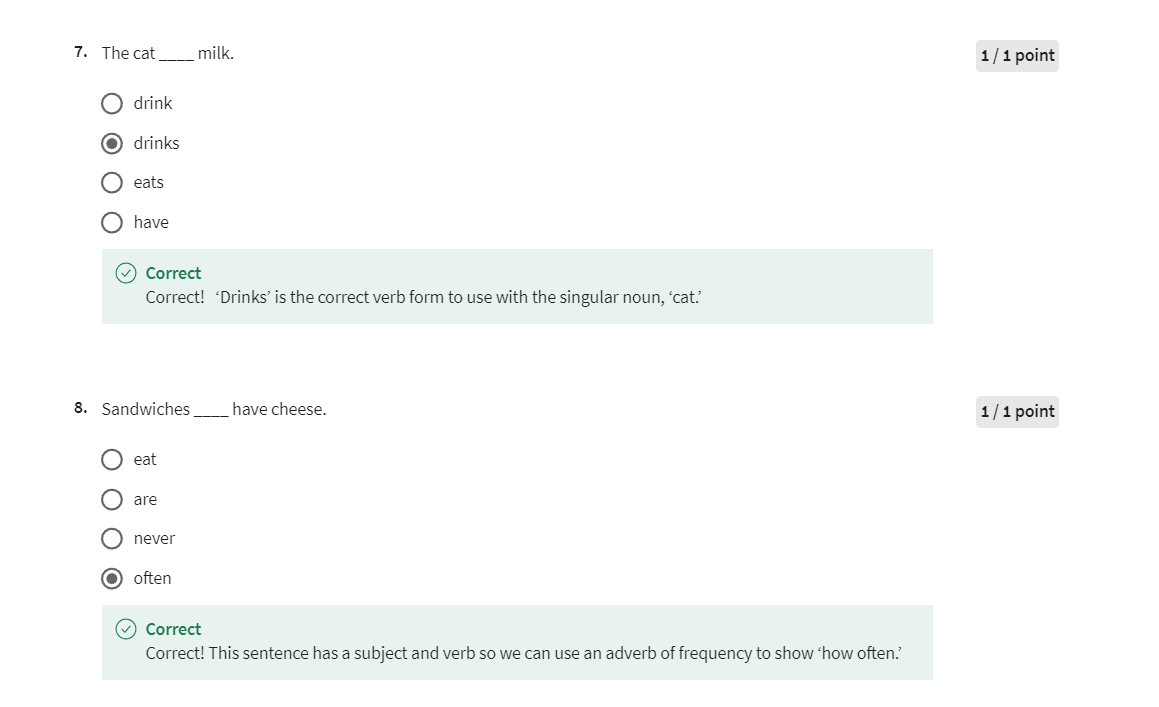
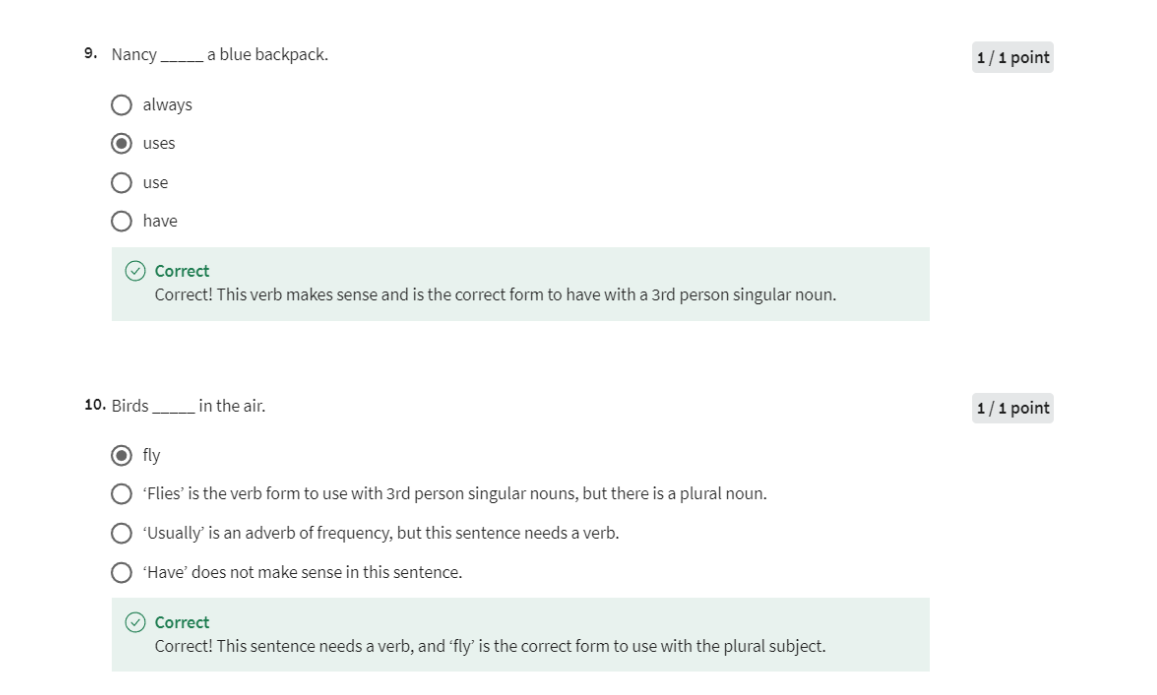
Week 03: Simple Present Negative
This week, you will learn more about the simple present. We will look at how to form the negative for the BE verb and for all other verbs. The BE verb always has rules that are different from other verbs. You will also learn how to use “There is” and “There are” to describe things in a place.
Learning Objectives
- Form negatives in simple present.
- Use ‘there is/isn’t’ and ‘there are/aren’t’ to describe.
Negative BE
Negative be. This lesson is about how to form be in the negative
in the simple present. Remember the be verb chart. There are three
forms; am, is, are. The negative of be is simple. To form the negative, add the word not. I am not, you are not, he is not, she is not, it is not, we are not, you are not, and they are not. If you know the be verb, you know how to
form the negative.
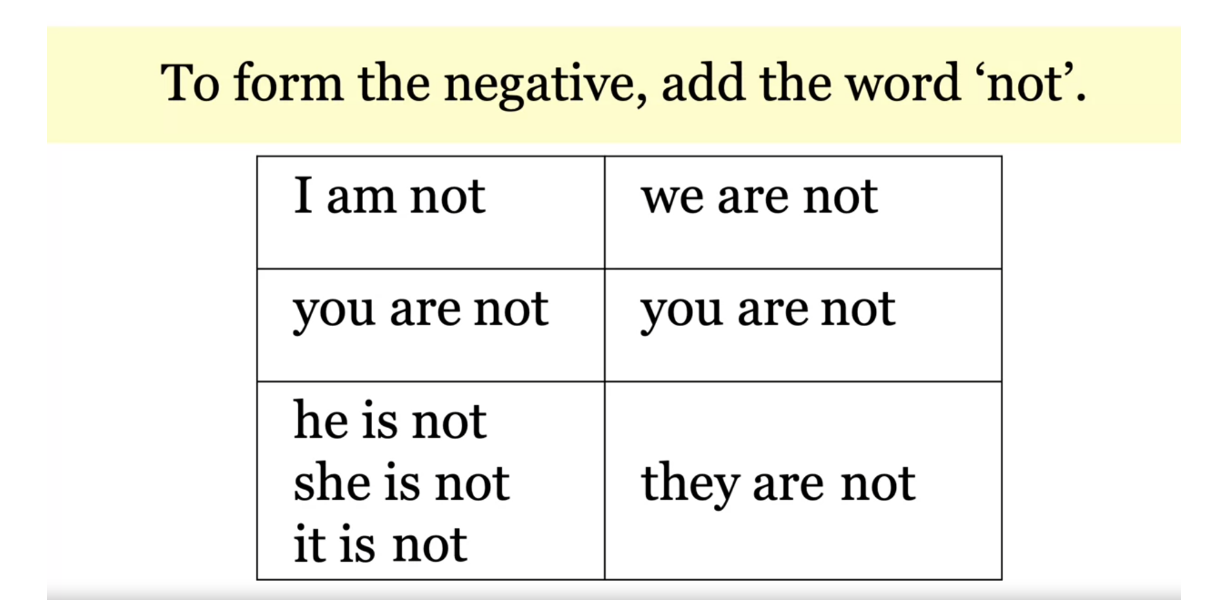
Here are some examples. Diana is a scientist. She is not a doctor. She is not sad. She is not at home.
She is at work.
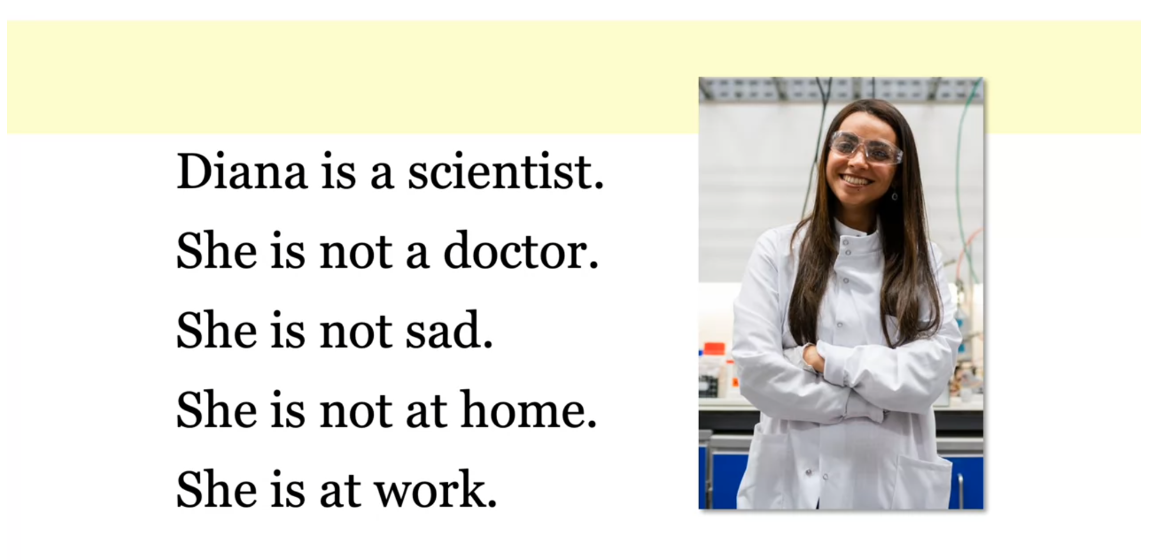
The strawberries are sweet. They are not sour. They are not green. They are not on a plate. They are in a bowl.
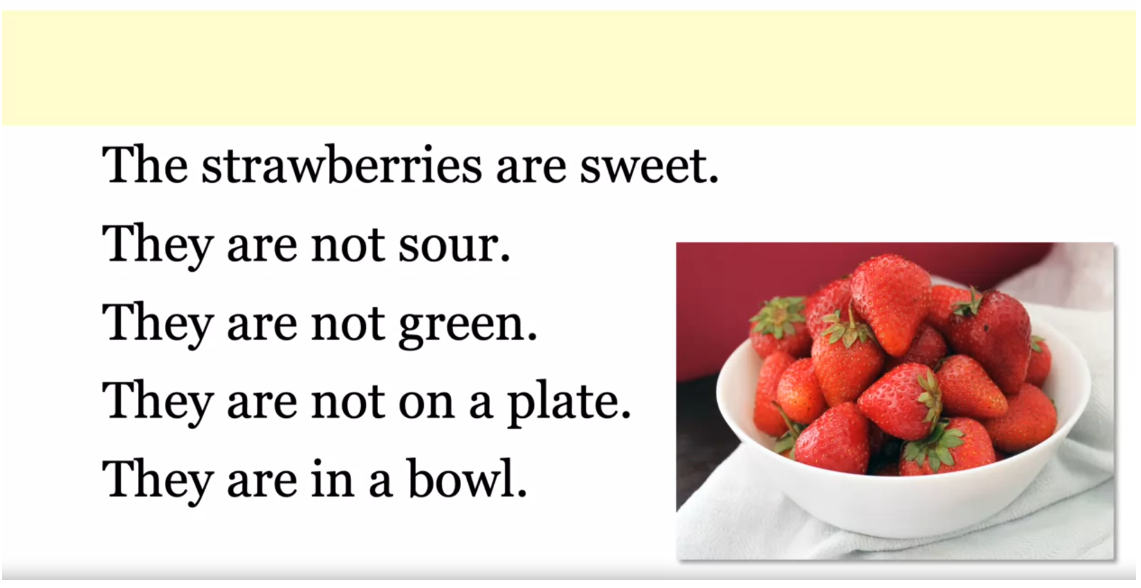
You can see, just add not when you want the
meaning to be negative. There are three ways to
write the negative form. Let’s look. Cindy is asleep. She is not awake. She’s not awake. She isn’t awake. These three sentences
all mean the same thing. In the first sentence, you can see not, she is not awake. In the second sentence, we put she and is
together to make she’s. In the third sentence, we put is and not
together to make isn’t. Do you remember what
these are called? Contractions.
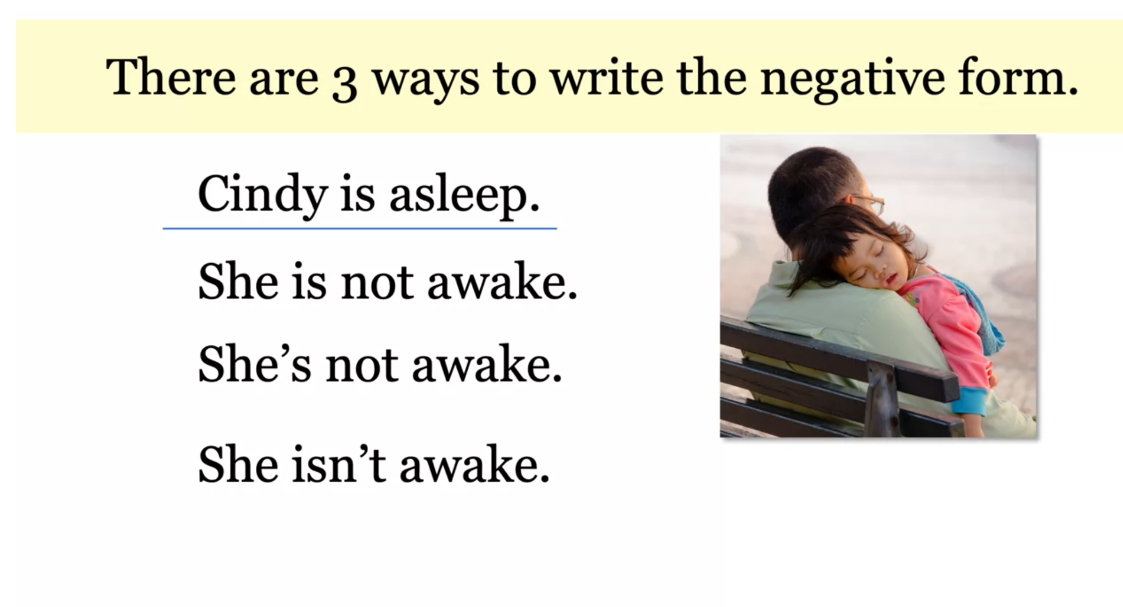
Let’s take a closer look. There are three ways to
write the negative form. Actually, that’s not true, there’s only two ways for
I am, for first person. But there are three ways for all of the other
forms, let’s look. The first way you know, add the word not. I am not. You are not. This is simple. The second way is combine the pronoun and be. You already saw this
with the be verb chart. Look at I am not. Remember, drop the a, push it together, don’t forget
the apostrophe; I’m not. You are not, same
thing, drop the a, make one word, don’t
forget the apostrophe. He is not. This time, it’s the s you drop, then use the apostrophe, he’s not, and she’s
not, and it’s not. The rest of these are, are, so they follow the same pattern. We’re not. You’re
not. They’re not. The third way to
form the negative is to use a contraction
of be and not. You cannot use this way for I, there’s no change for
first person singular. But the rest, we can
do this third way. Look at you are not. This time, we drop the o, we make one word with
the n and the t, and we add the
apostrophe; you aren’t. With he is not, it’s the same. Drop the o, make one word, don’t forget the
apostrophe; he isn’t. She isn’t. It isn’t. The rest all use the form, are, so they look like aren’t. We aren’t, you aren’t,
and they aren’t.
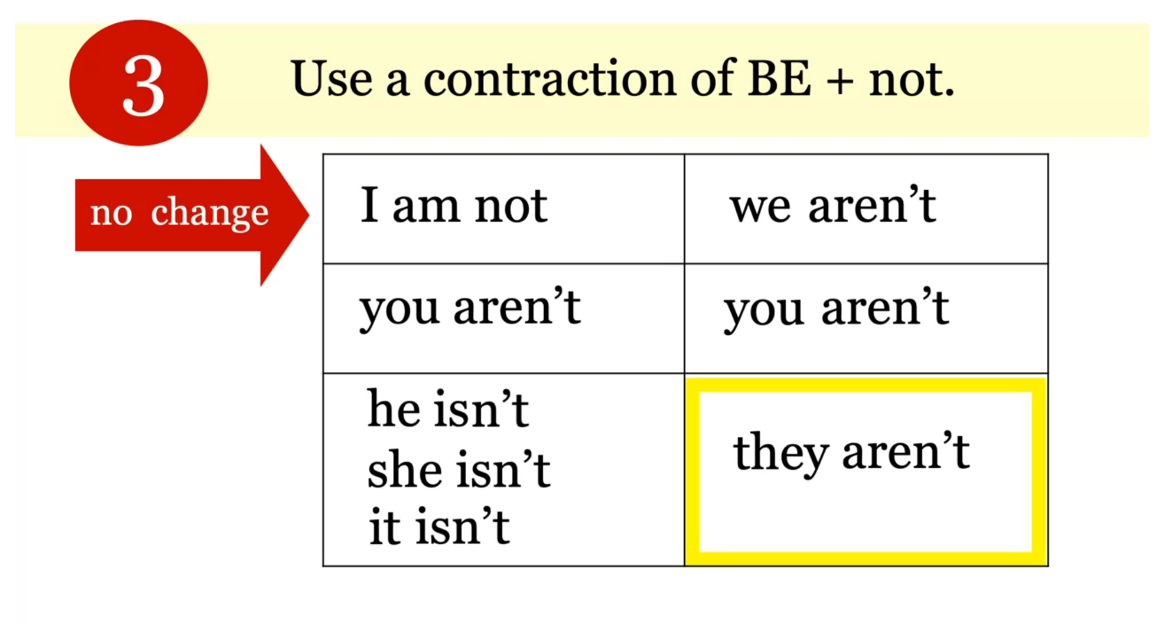
Here are the three ways to
form the negative of be again. This car is dirty. First way, just
add the word not. It is not clean. Second way, make a
contraction with it and is, so we say, it’s not clean. The third way is to make a
contraction with is and not, so we say, it isn’t clean. Notice, we still have is
and not in every sentence. You try. What are the three
ways to make it negative? The sentence is,
he is a student. But no, he is a teacher. How do we make this negative? The first way is, just add not. Where does not go? He is not a student. The second way is to make a
contraction with he and is; he’s not a student. The third way is to make a
contraction with is and not; he isn’t a student. Notice in all three ways
we still have is and not. What are the three ways
to make it negative? This time, the sentence is, they are in class, but no, look at the
picture, they are outside. The subject is they, so this time, it’s plural. The first way is, just add not. They are not in class. The second way, make a
contraction with they and are. They are not in class. The third way, make a
contraction with are and not. They aren’t in class.
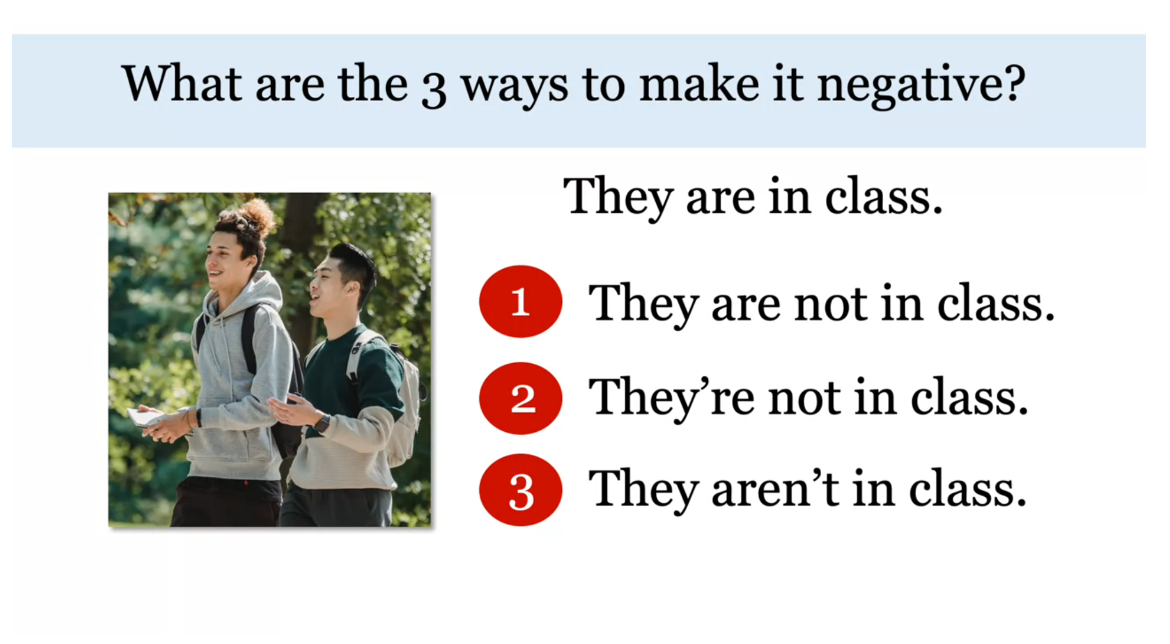
What are the three ways to
make the sentence negative? He is early. I don’t think so. One, he is not early. Two, he’s not early. Three, he isn’t early. Okay? One more. What are the three ways
to make it negative? The sentence says, I am tired, but this is me and I feel fine. The first way, add not. I am not tired. The second way, I’m not tired, and the third way, nothing. Remember, I, you can’t do the
third way in the negative. Here’s some information
about a koala that has all three kinds
of negative sentences. Look for them as we read. This is a koala. A koala is not a bear. It’s a marsupial. Koalas aren’t fast
on the ground. They live in trees
and eat leaves. They aren’t meat-eaters. This koala isn’t an
adult. It is young.
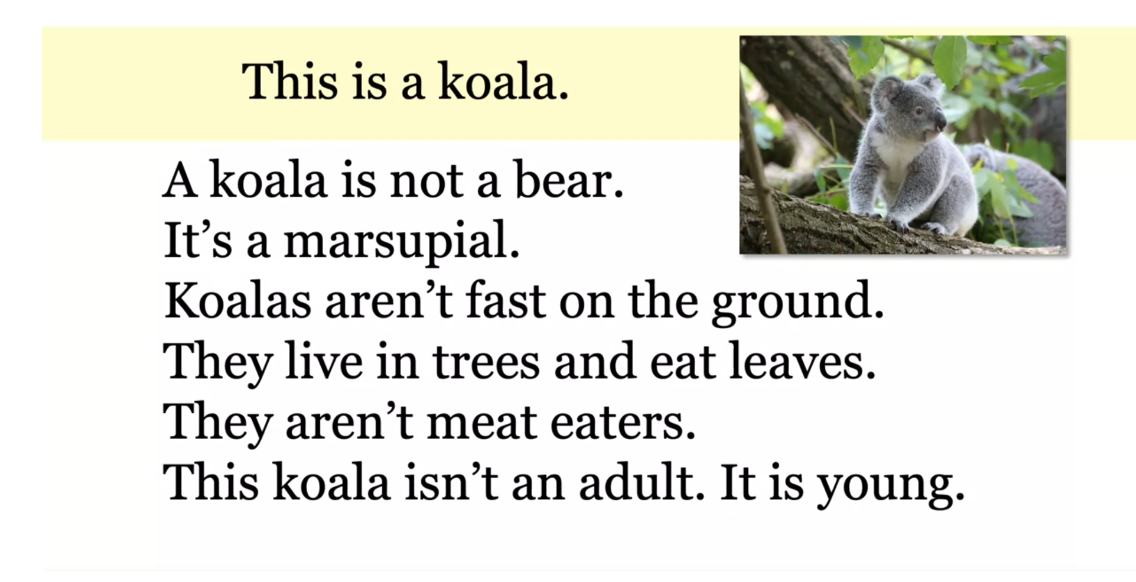
Now you know. Form
negative be with not. Add not, like, they
are not green. Or make a contraction, they’re not green,
they aren’t green. Remember, they’re and aren’t have the be verb
and the word not.
Negative BE (Practice Exercise)
Practice

Answer
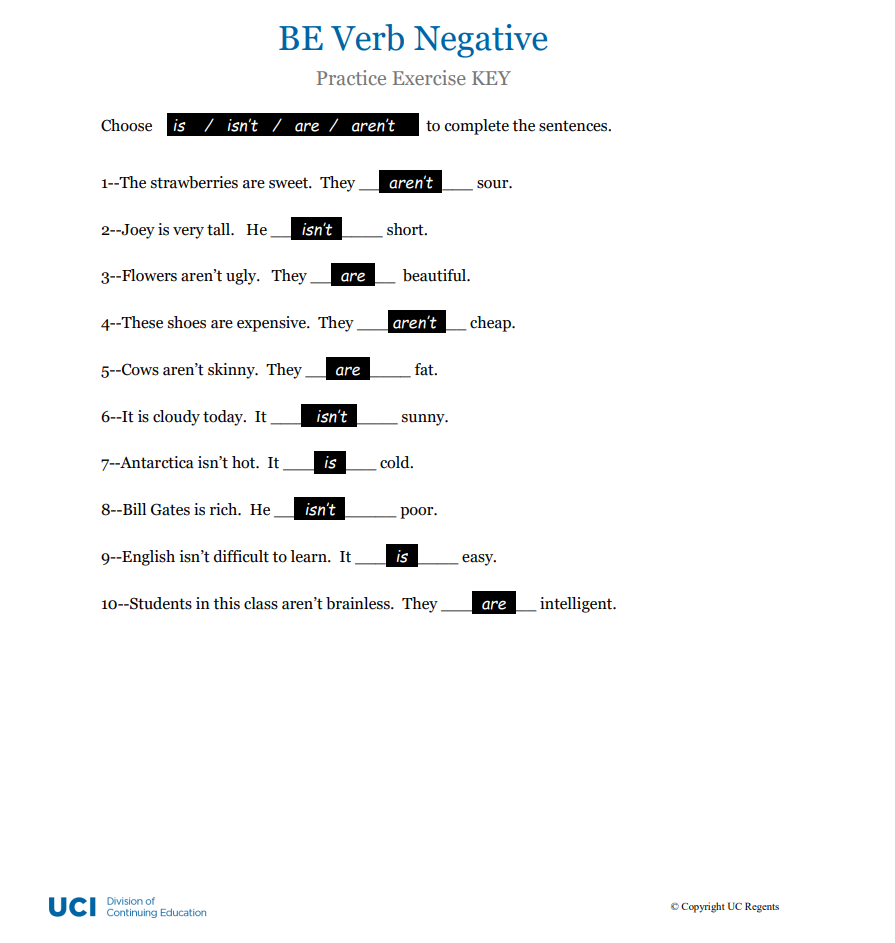
There Is & There Are
In this lesson, you will learn about,
there is and there are. There is a zoo in Washington, DC. There are three pandas at the zoo. There is a camera in the panda area so
people can watch the pandas from home. This describes or
tells about pandas at the zoo. It uses There is and there are to
tell us what we can find there.
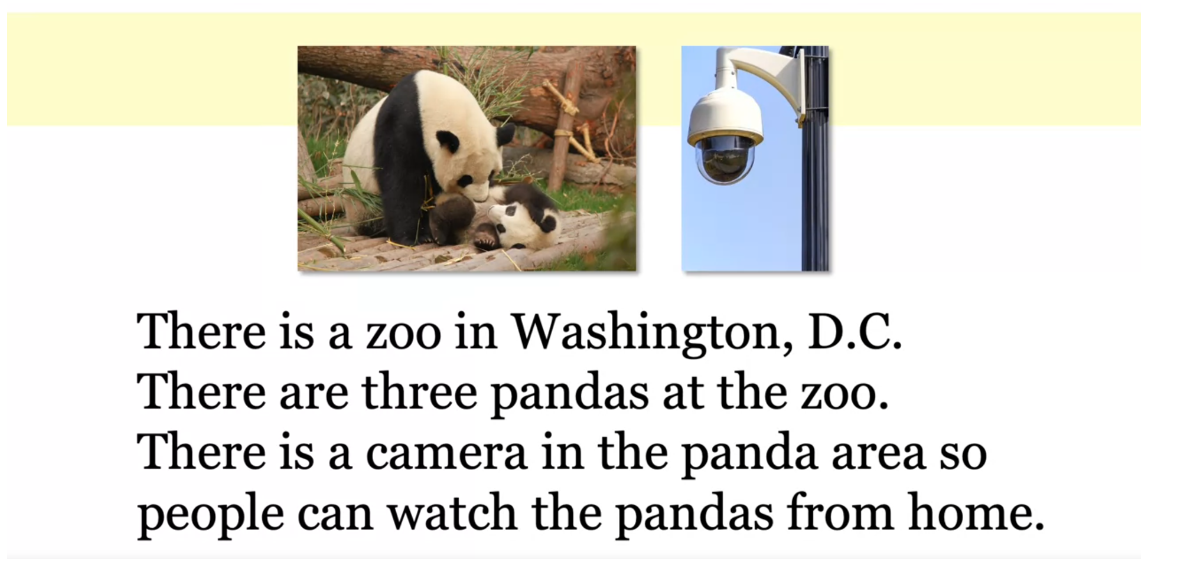
Let’s look at some more
sentences what there is. These sentences describe a soccer stadium. Let’s look. There is a soccer stadium
at the university. There are 10,000 seats. There aren’t any people
in the stadium now. There isn’t a game today. These sentences tell us
about the soccer stadium. This is how we use,
there is and there are.

Let’s look at how to form it. We look at the noun to
decide the verb form. Here is a sentence. There is a computer on the desk. Instead of looking at there we look to
computer the main noun in the sentence. This is a singular noun, so we use the singular form of B. There are books on the desk. Here we look at books and
this is a plural noun, so we use the plural form of B. There are books on the desk.
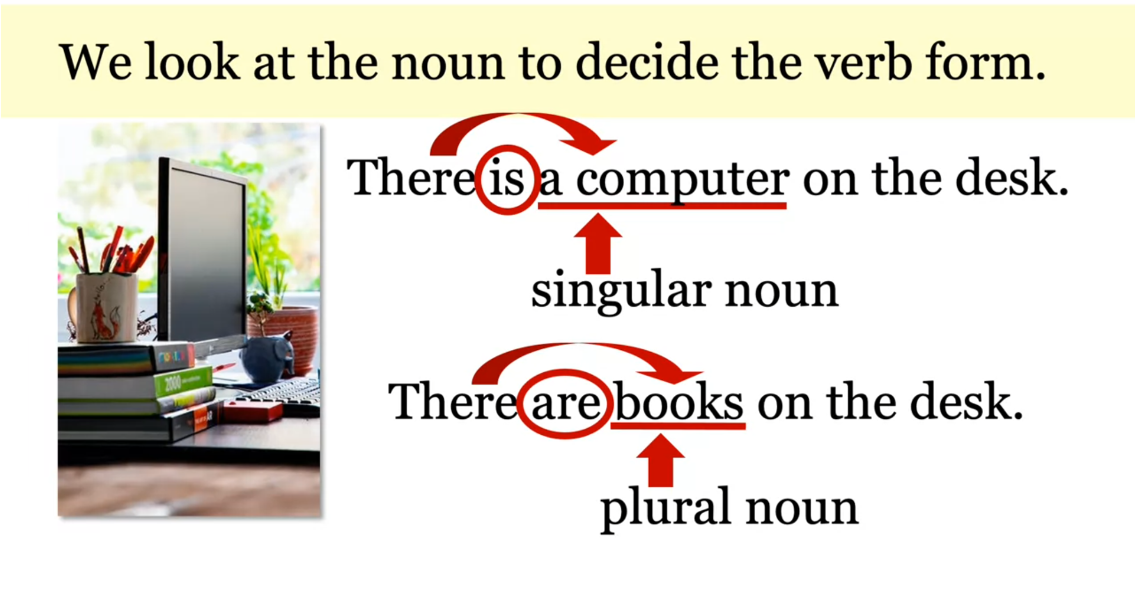
There is a very big park in New York city. Central Park has many trees. There are many sports fields. There are small lakes. There is a stone bridge. There is even a zoo. These sentences tell
you about Central Park. They tell you what you can find there. That’s how we use there is and there are.
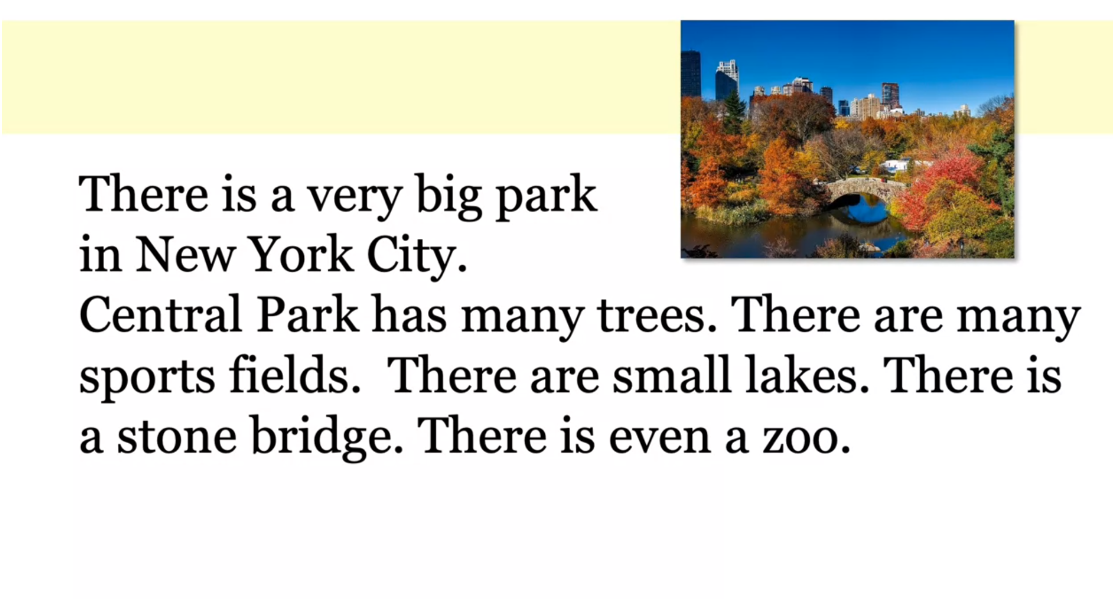
We use there is and there are to describe. We use them to describe a place or
tell about what is in a place. Look at this classroom, what do you see? There is a white board. There are three chairs. There are two backpacks. There is a table. There are papers on the table. All of these sentences
describe the classroom. Notice that there is goes
with a singular noun and there are goes with a plural noun.
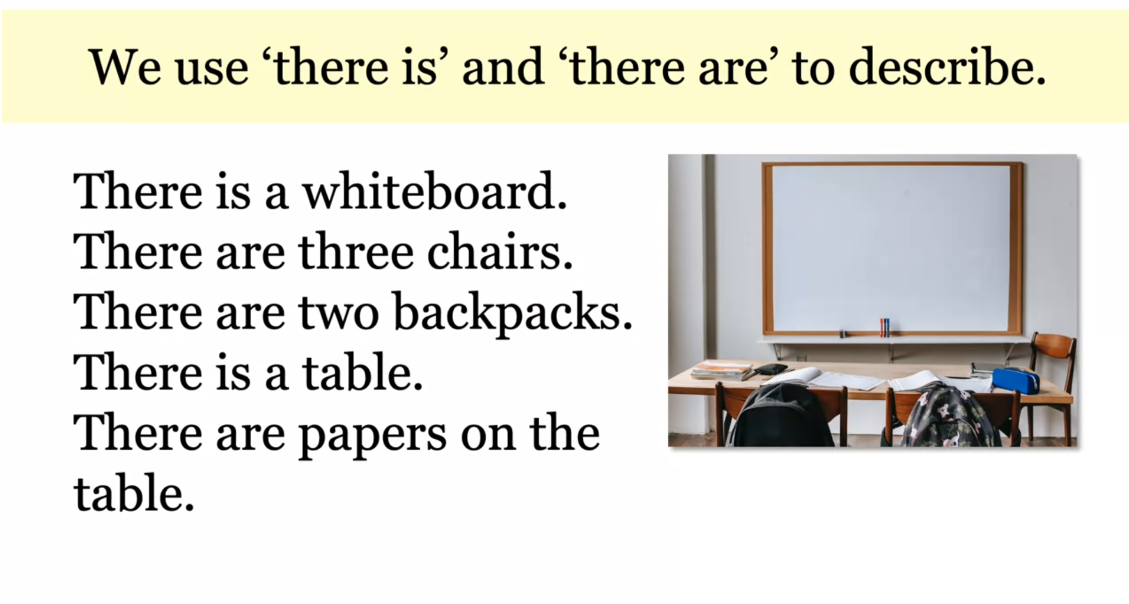
Let’s practice. You try look at the sentences they
describe Amy’s new apartment, fill in the blanks with there is or
there are. Look at the nouns to decide singular or
plural. Ready? Okay, let’s look at the answers. Amy has a new apartment. There is a small kitchen. There are two bedrooms. There is one bathroom. There are big windows in the living room. It’s on the 5th floor,
but there is an elevator. Okay.
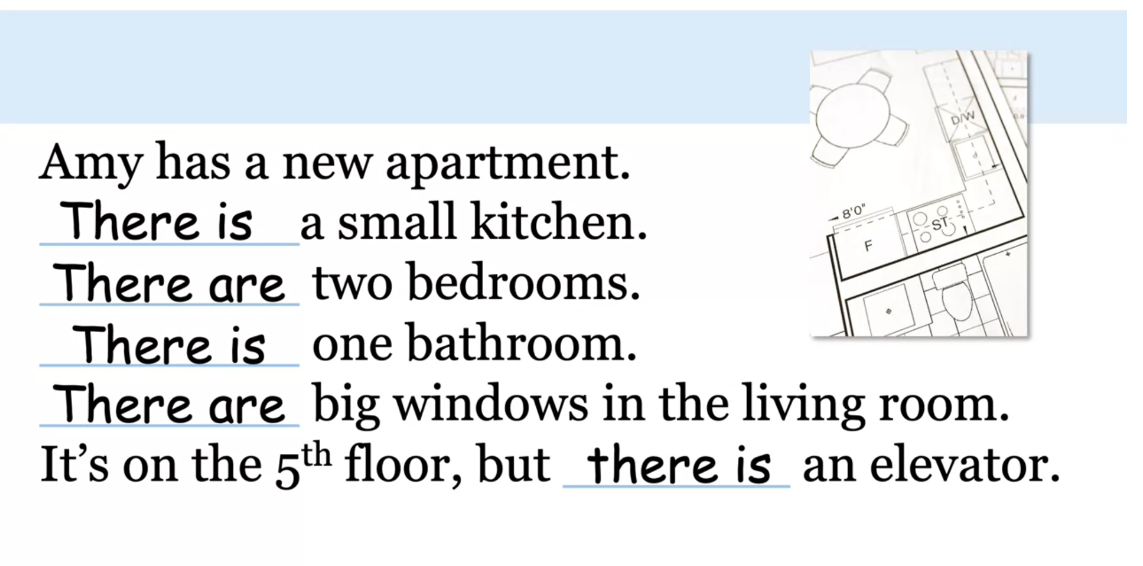
There are many things on this desk. There is a computer. There’s a cup of tea. There are many papers. There’s a green lamp. Do you see the contractions? There’s a cup of tea and
there’s a green lamp. These are the contractions of there is. It is very common to use
contractions with there is. There are many papers there many papers
you might hear this when people speak but there are is not a contraction so
do not write it.
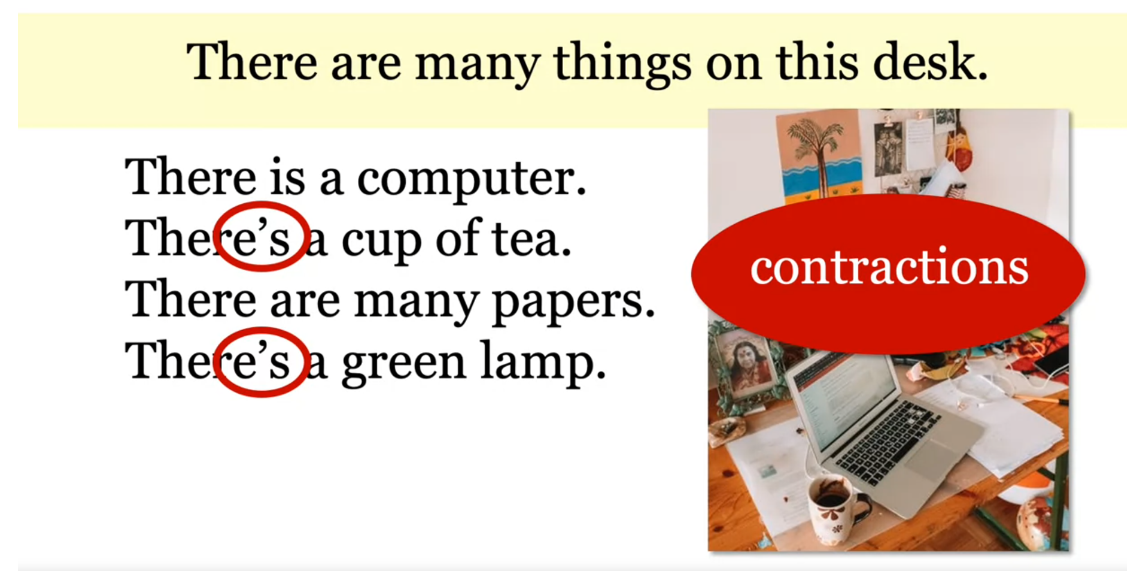
Let’s look at some other
possible mistakes. This speech is crowded. You may want to say there has many people,
but this is not correct. We need to use the be verb not have. There are many people. We use there are you might think you here, they’re a leak in the park. But you probably don’t. This is incorrect. There’s a lake in the park is correct. Listen again, there’s a lake in the park. When you hear it the S may sound very
small but it’s there we need that B verb. There’s a lake in the park. Look at the photo. There is a blue sofa, there is a pillow
on the sofa, there is a small table. There isn’t a plant. There aren’t pictures on the wall. There aren’t people in the room. Now you see we’ve got some negative
contractions that look just like the contractions for
B verb they’re not any different.
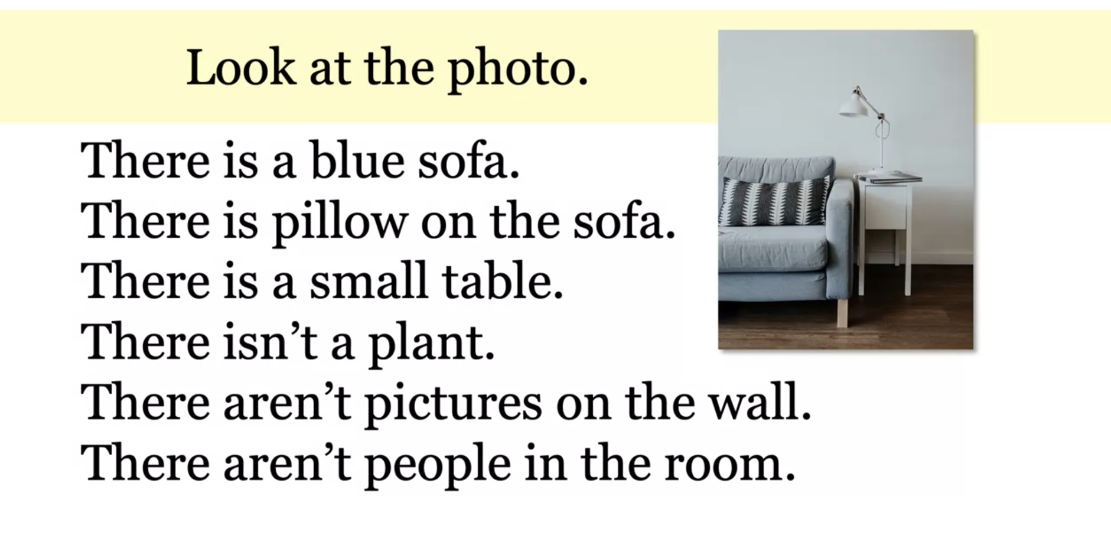
To form the negative of there is
there are use the negative form of B. There is not a plant in the room. There isn’t a plant in the room. There are not pictures on the wall. There aren’t pictures on the wall. Let’s try. Look at the photo. You need to fill the blanks with. There is, there are, or
the negative there is not, there are not. Maybe you want to pause the video and
try it. Okay, are you ready for answers? Let’s look. There is a bed, and
there are two small tables. However, there is not a closet. There are not plants. There is not a lamp. There is not a TV. Okay. Okay now let’s try with contractions. So there is turns to there’s. There’s a bed and there are I
can’t change this one remember. There are there’s no contraction for
so there are two small tables. However there is not. There isn’t a closet. There aren’t plants. There isn’t a lamp and there isn’t a TV. Okay. Okay now you understand how to
use there is and there are.
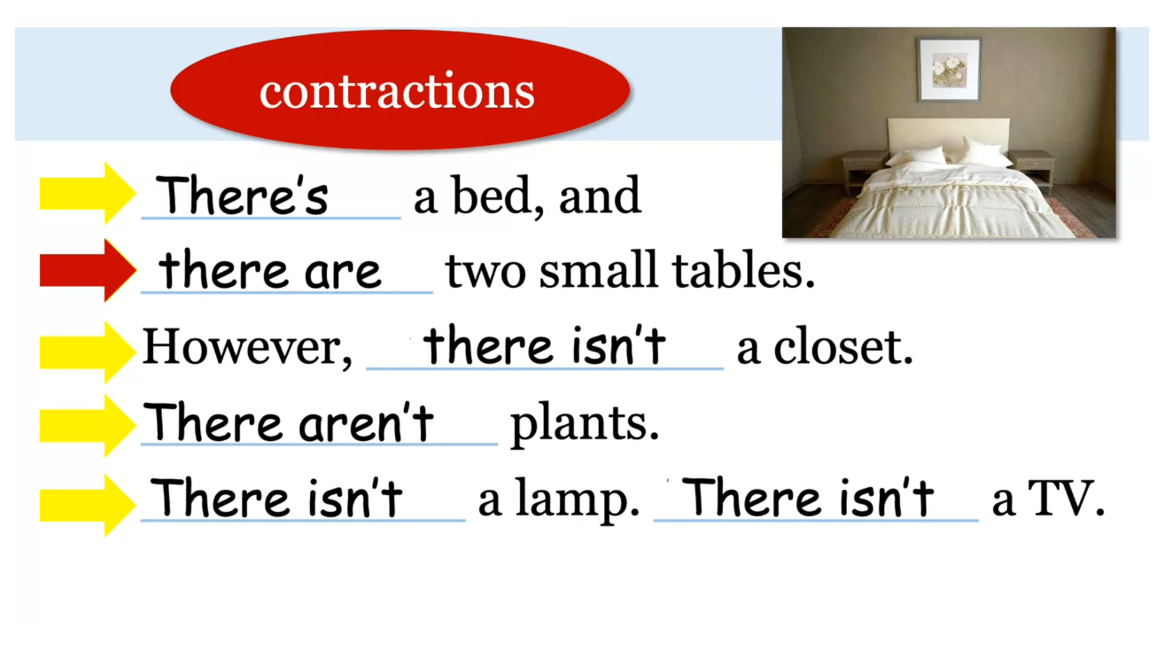
So when we read these sentences
you can see why there is and why there are or the negative,
there isn’t, there aren’t. Let’s read it one more time. There is a soccer stadium at
the university that singular. There isn’t a game today
that’s singular and negative. There are 10,000 seats that’s plural. There aren’t any people in the stadium now
that is also plural and also negative.
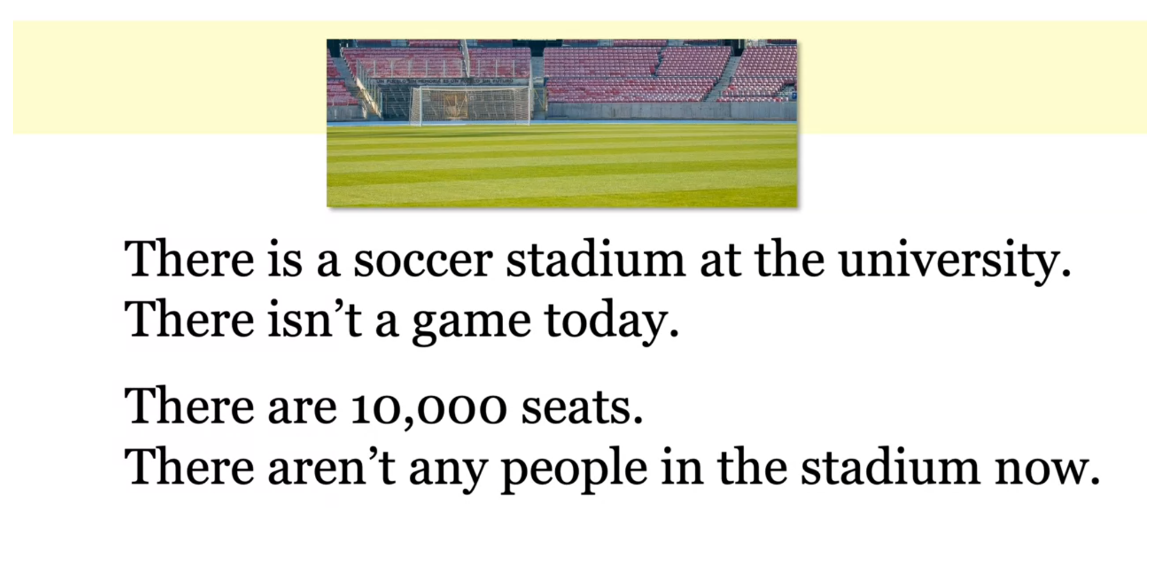
There Is & There Are (Practice Exercise)
Practice
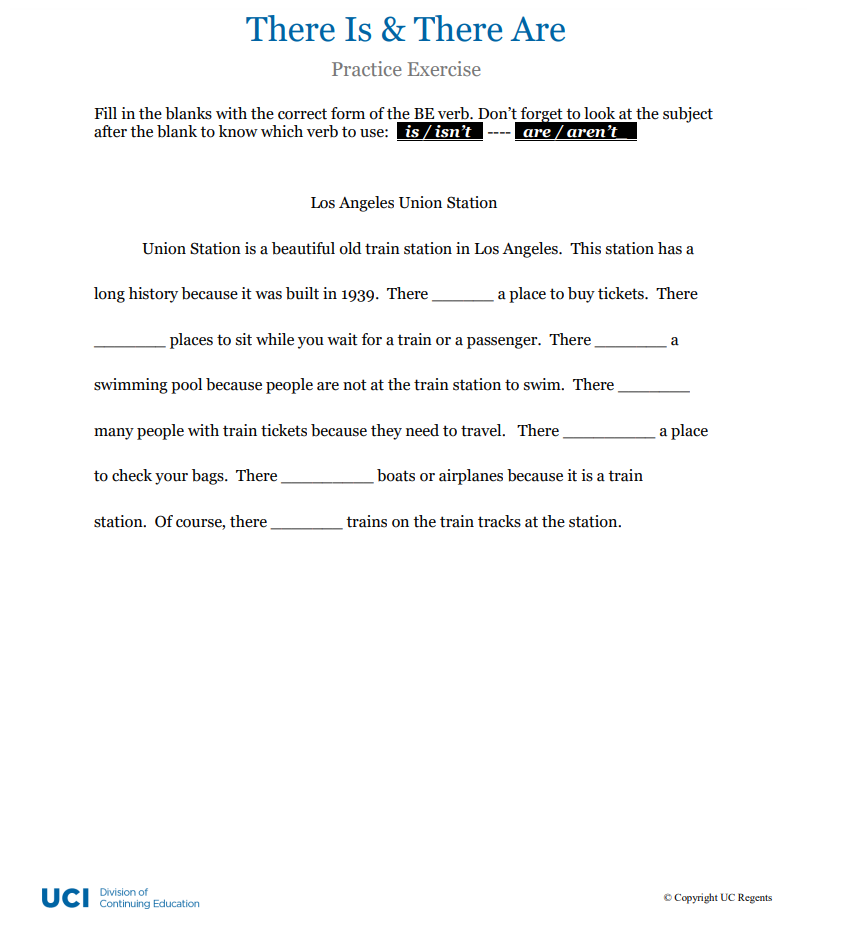
Answer
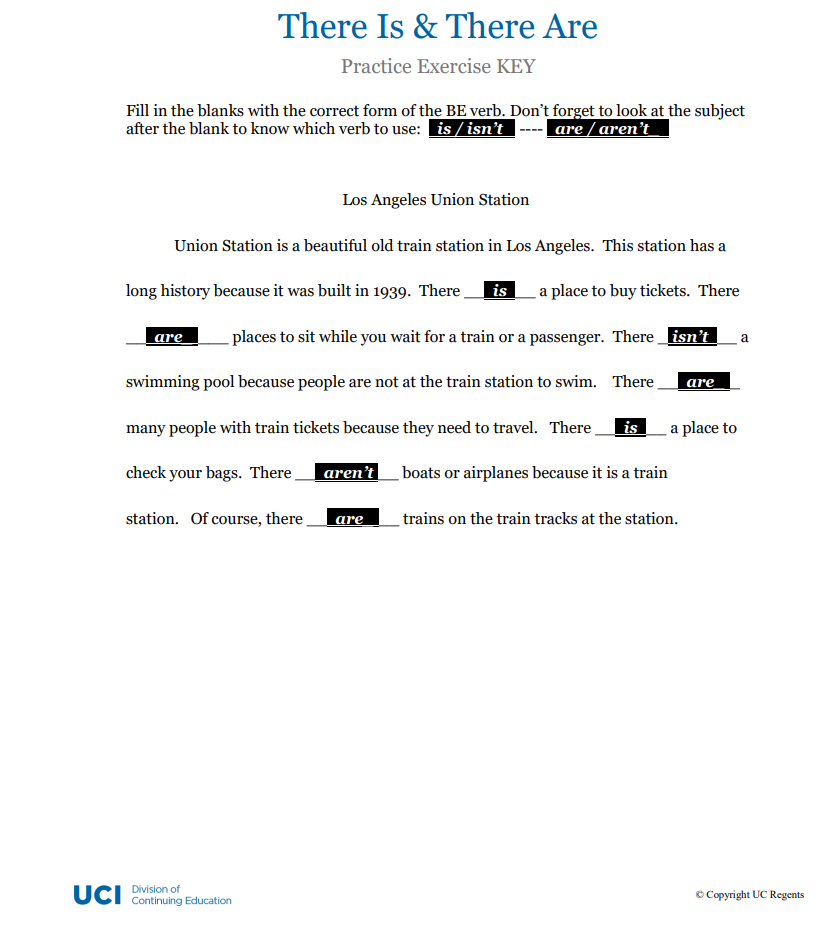
Simple Present Negative
Simple Present Negative. In this lesson you will learn how to form
the negative with all verbs except for be. Let’s look at the negative
form of the simple present. Austin does not go to school on Saturday. He does not get out of bed. His parents do not wake him. They let him sleep. Do you see the negative forms? Does not go, does not get and do not wake. These are the negative forms for
the simple present.
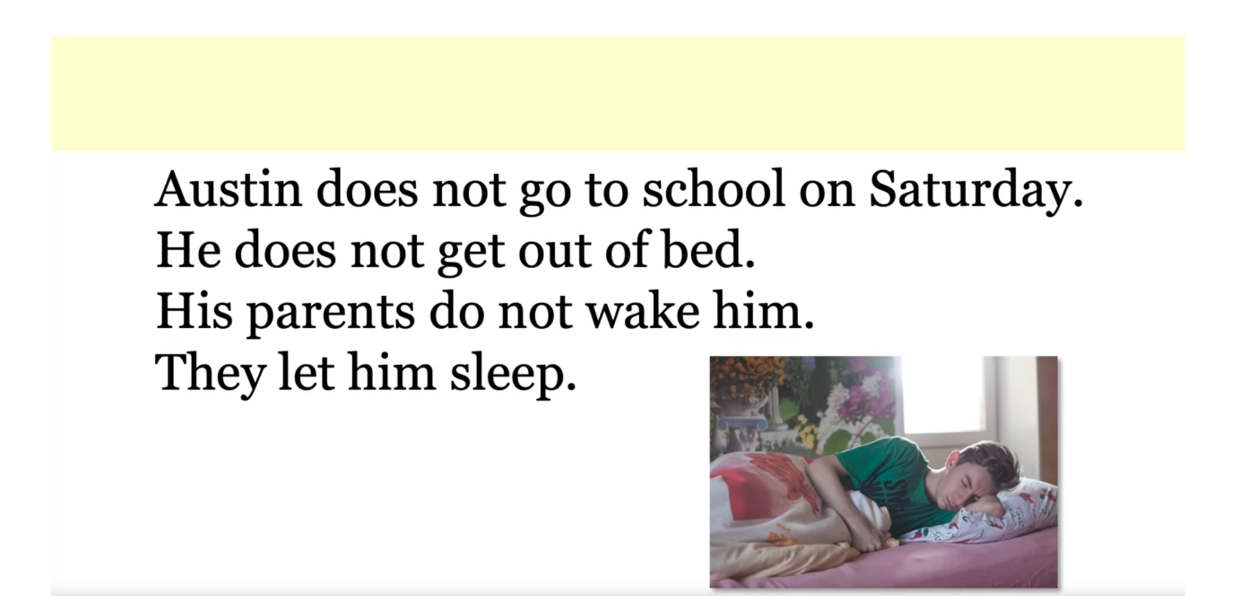
Add, do or does and
not to form the negative. You already know the verb do, but do and
does here don’t mean the same thing. We just use them to form the negative for
all verbs except be, we add do or does and
not to make the negative form. And we don’t put them at the end, we put
them between the subject and the verb. Let’s look,
you see the verb chart here for speak, I speak we move speak over and
do not. I do not speak. It’s the same for you. You speak, changes to you do not speak. And here we’ve got he,
I’m going to move speaks over. But remember the form of do for
he is does, so he does not speak. But something happens here,
I have an s here on does, so I don’t need this s on speaks anymore. We dropped that. He does not speak. We only need one s. She and it follow the same pattern. She does not speak. It does not speak and the plural all
follow the same pattern with do. We do not speak. You do not speak and they do not speak. Remember all of simple present forms, the
negative this way, except for the be verb.
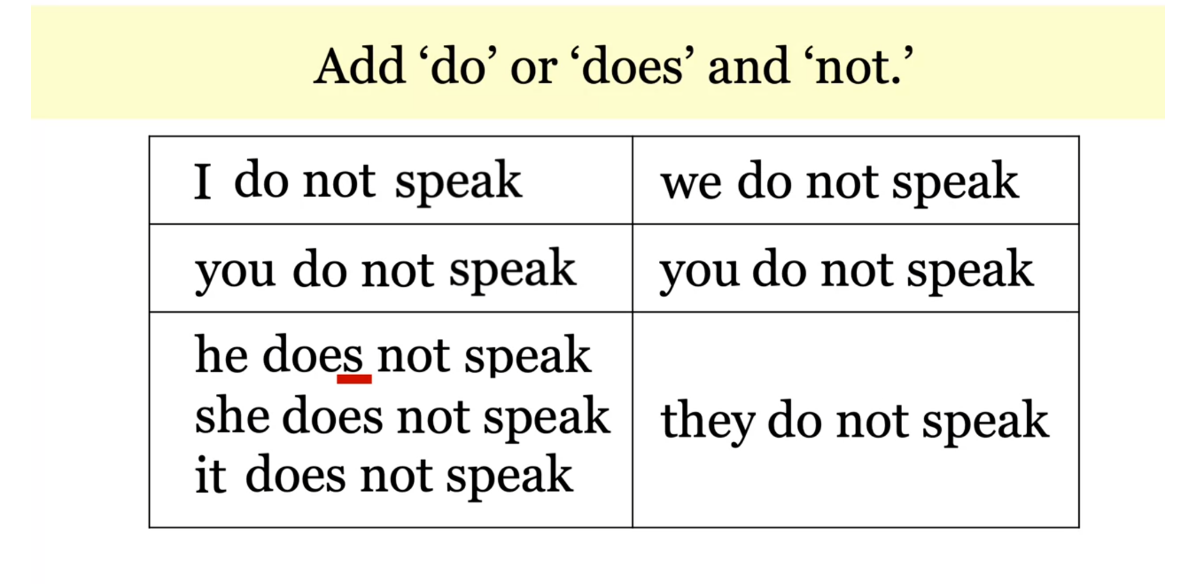
Here’s some more examples. Ostriches are birds, but they do not fly. They do not need to drink water,
because they get water from food. They do not put their heads in the sand,
but many people think they do. Do you see the negatives? Do not fly. Do not need, do not put.
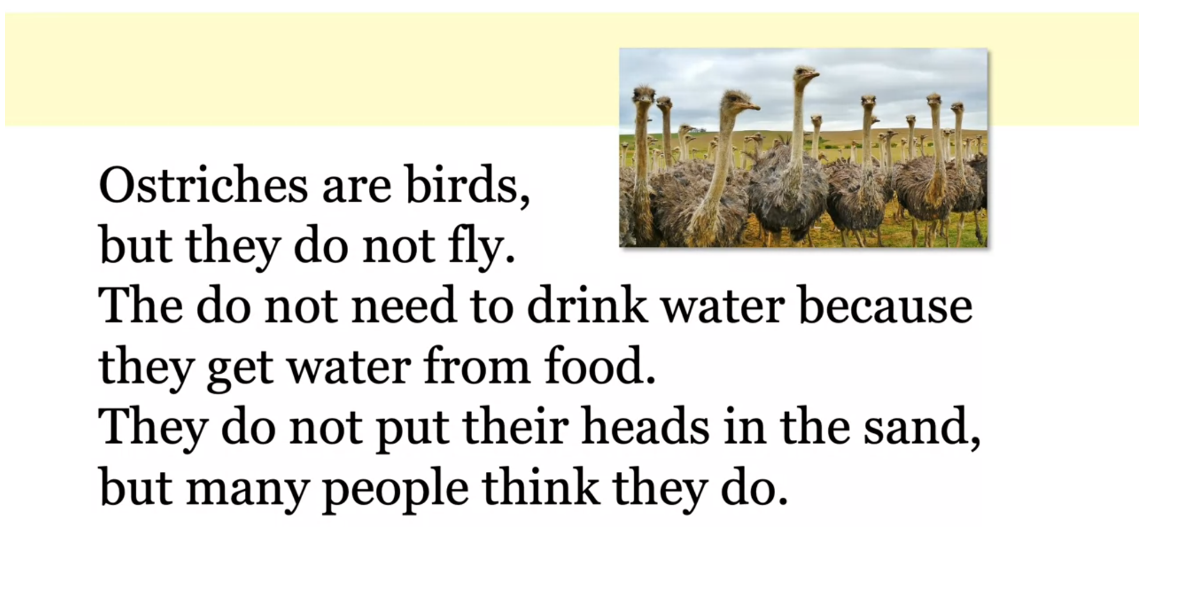
Here is another example. Annie doesn’t have a cat. She has a dog. His name is Bruno. Bruno doesn’t like to walk. Annie doesn’t get angry. She thinks it is funny. Where do you see the negatives here? Doesn’t have,
doesn’t like and doesn’t get. So you can see contractions.
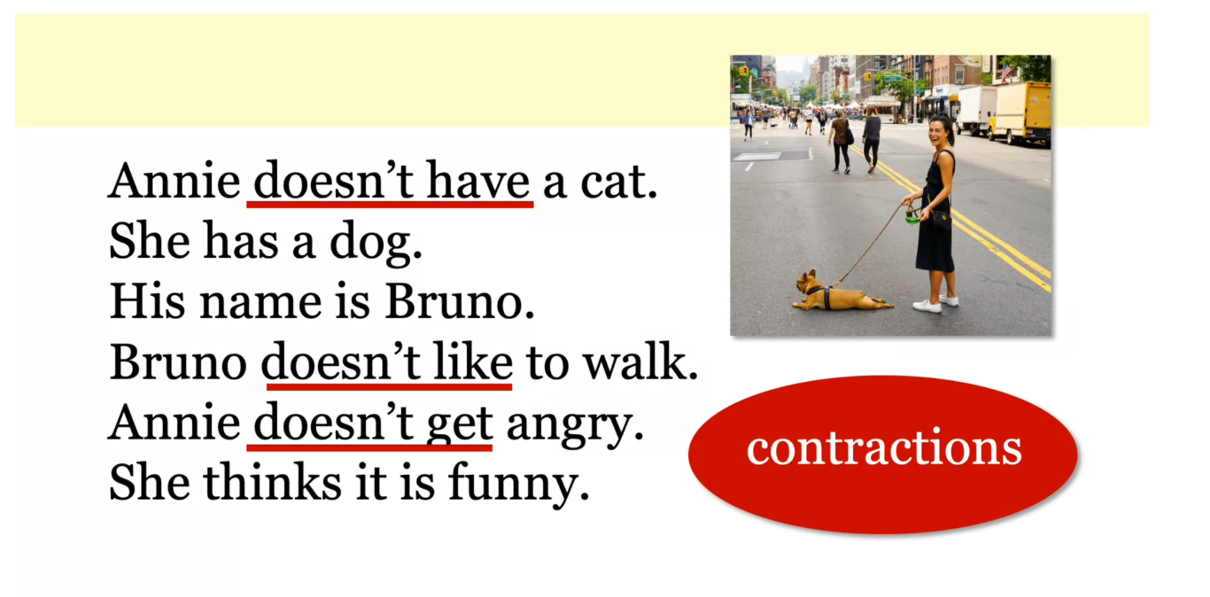
Let’s look at the two ways
to form the negative. There are two ways to form the negative. The first way add do or does and not. So I speak English. Remember, it goes between the subject and
the verb, so I do not speak English and she
speaks English changes to she does not, but look speaks we’ve got double s drop
that s she does not speak English. The second way to form the negative
is with a contraction. I do not speak English. Drop the o make one
word add an apostrophe. I don’t speak English. And she does not speak English. Drop the o make one word
add the apostrophe. And we have, she doesn’t speak English. Let’s practice the negative forms. What goes in the blank? Use the verb have. First try the long form. Remember, you need three
words to form the negative. George does not have a car. He rides his bike to work. Now try the contraction form. George doesn’t have a car. He rides his bike to work. Here we have two verbs for two blanks,
fly and live, put them in the negative. First try the long form. Penguins do not fly and
they do not live in the North Pole. How about contractions? Penguins don’t fly and
they don’t live in the North Pole.
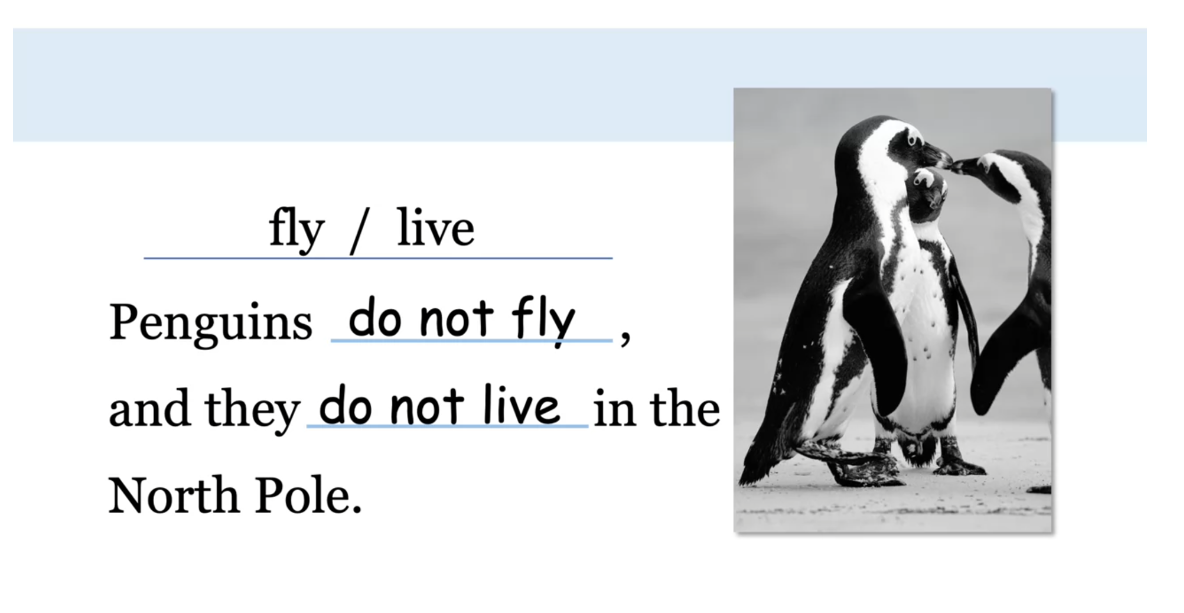
Last one, the verb is work. What goes in the blank? The long form is Jill
does not work at a desk. She sits on the floor. And the contraction Jill
doesn’t work at a desk. She sits on the floor.
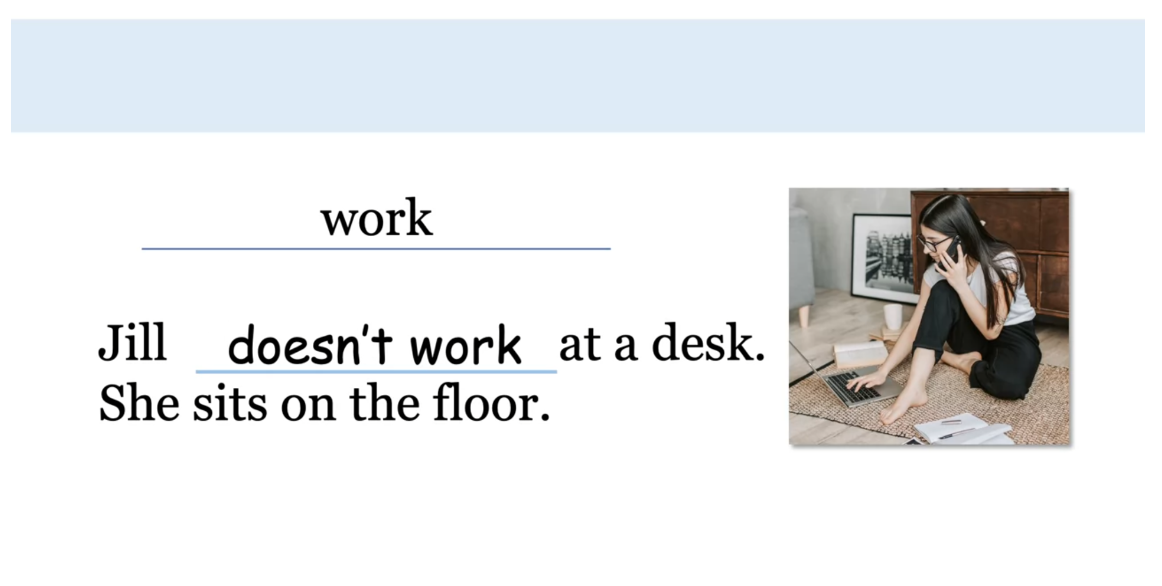
Let’s look at some sentences. Think is the negative form correct? First sentences. He doesn’t like golf. Yes, that is correct. He doesn’t like golf. They don’t want cake. Yes. That is also correct. They don’t want cake. She doesn’t swims. Mm-mh, this is incorrect. Look, we’ve got the s there, so
we have an extra s on swims. She doesn’t swim is correct. I don’t have a cat. That’s correct. I don’t have a cat. She isn’t have a car. This is incorrect. This is the wrong verb. We need doesn’t, she doesn’t have a car. Isn’t as the be verb and
we don’t put it with the verb have. She doesn’t have a car. She doesn’t eat meat. Yes, that is correct, okay?
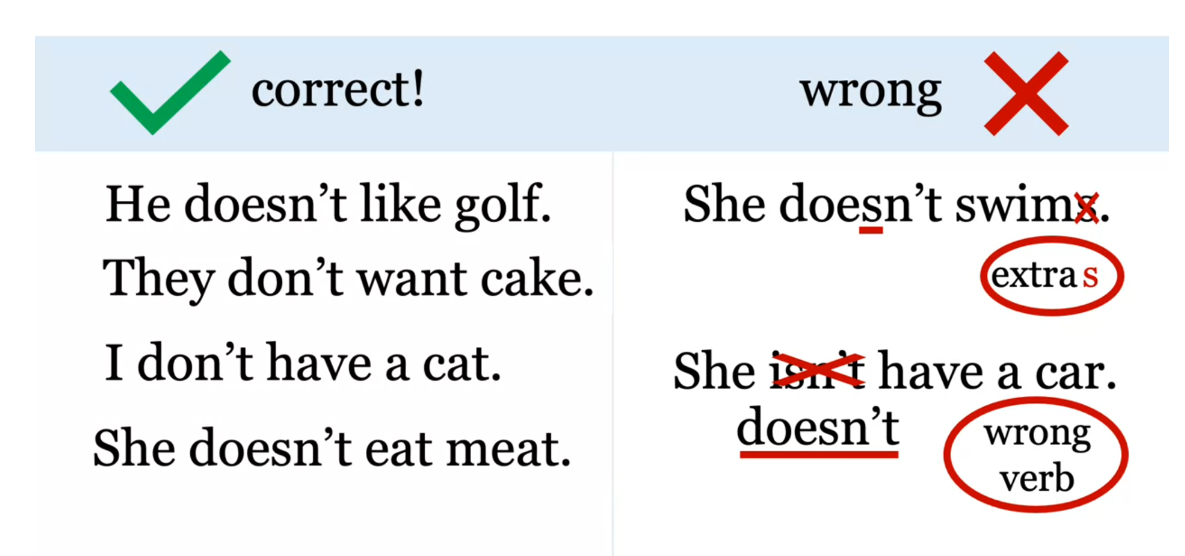
In this lesson you learned, add do or does and not to form the negative. They do not fly. He does not like to walk. And you can make contractions. They don’t fly. He doesn’t like to walk.
Simple Present Negative (Practice Exercise)
Practice
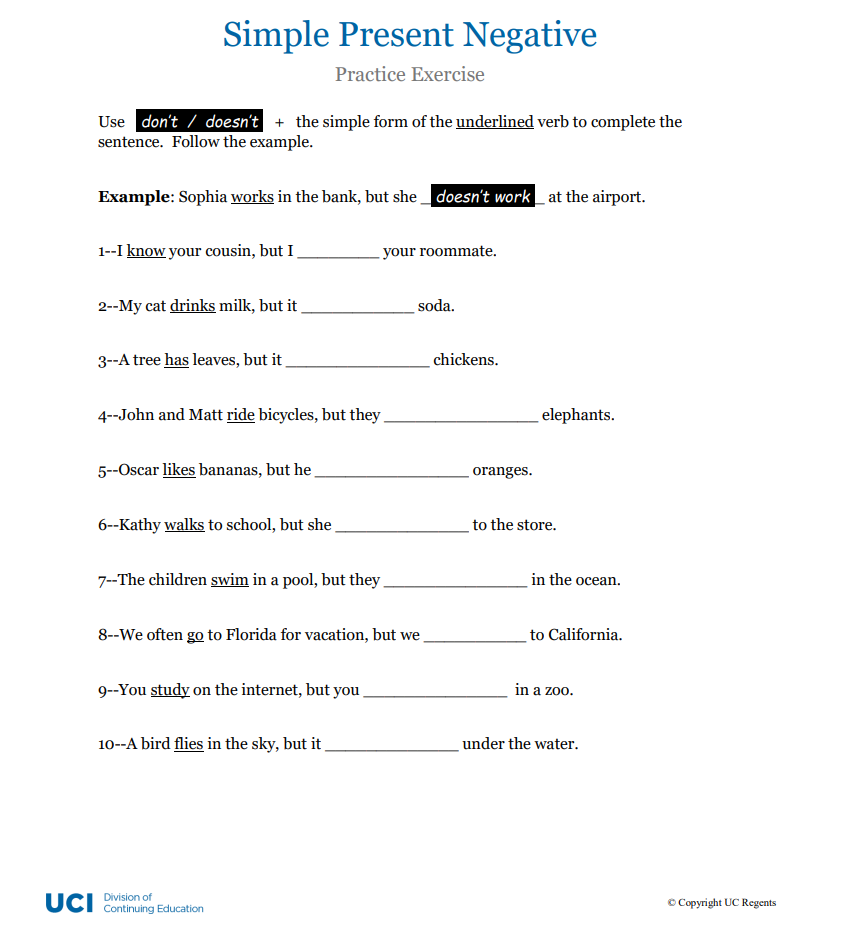
Answer
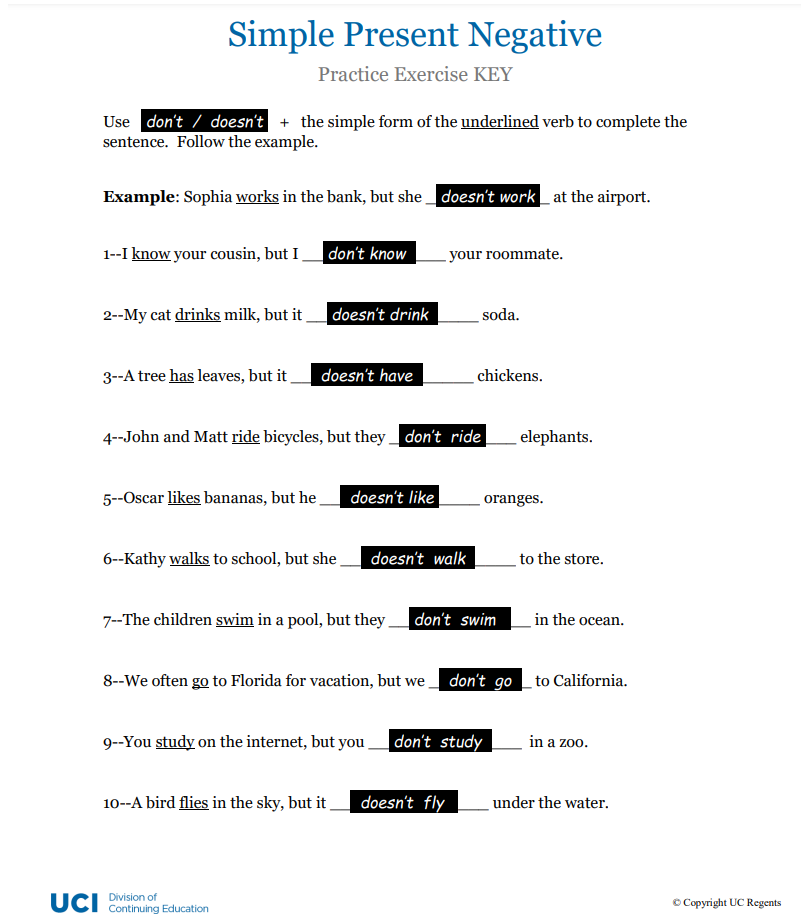
Quiz: Simple Present Negative

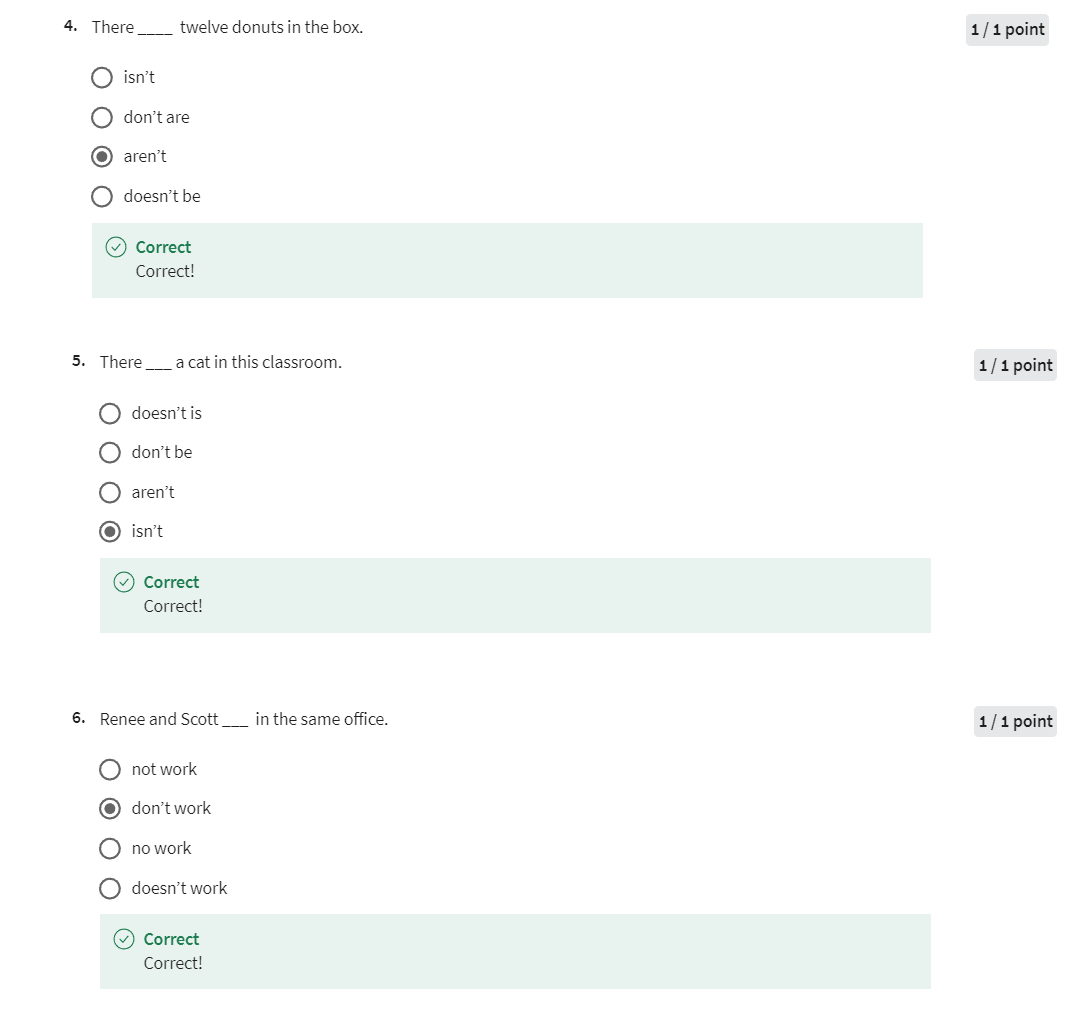

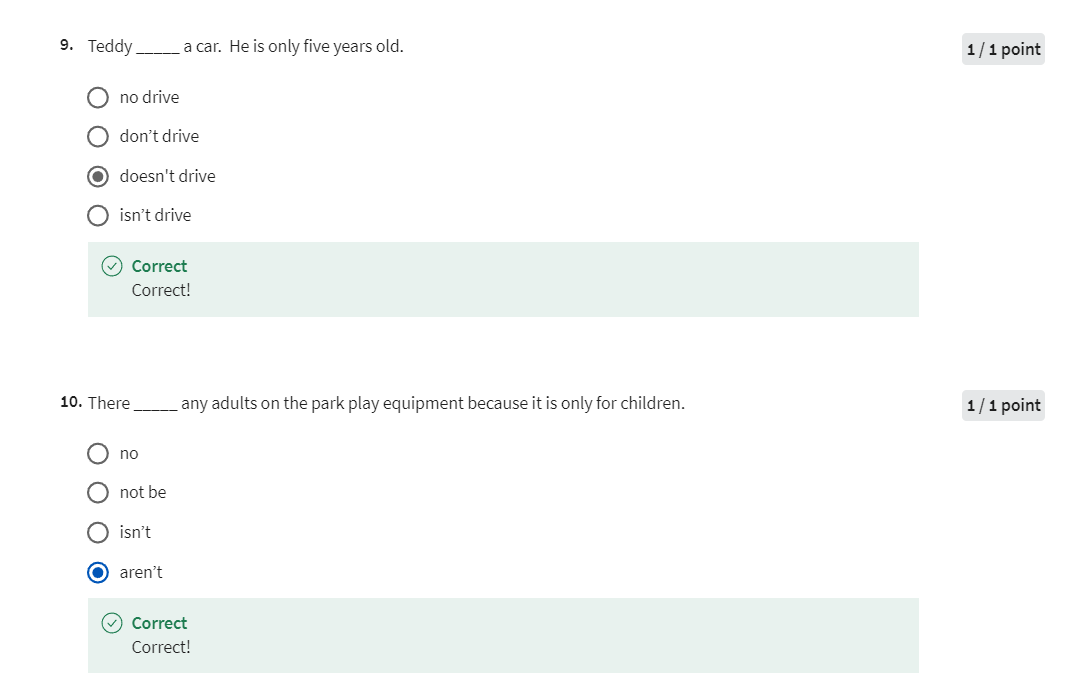
Week 04: Yes/No Questions
This week, we will start with how to ask yes/no questions using the BE verb. Then, you will practice asking questions using “Is there…?” and “Are there…?” Finally, You will learn how to use “do” and “does” to ask yes/no questions in the simple present.
Learning Objectives
- Ask yes/no questions in simple present.
- Use ‘is there’ and ‘are there’ to ask questions.
Yes/No Questions BE
Yes-no questions
with the BE verb. Remember the BE verb. In this lesson, you are
going to learn how to form yes-no questions with
these forms of BE. What is a yes-no question? Here are some yes-no
questions. Are you a student? Is he your teacher? Are they your classmates? The answers to these
questions are yes or no. Are you a student? Yes, I am. Is he your teacher? Yes, he is. Are they
your classmates? No, they aren’t.
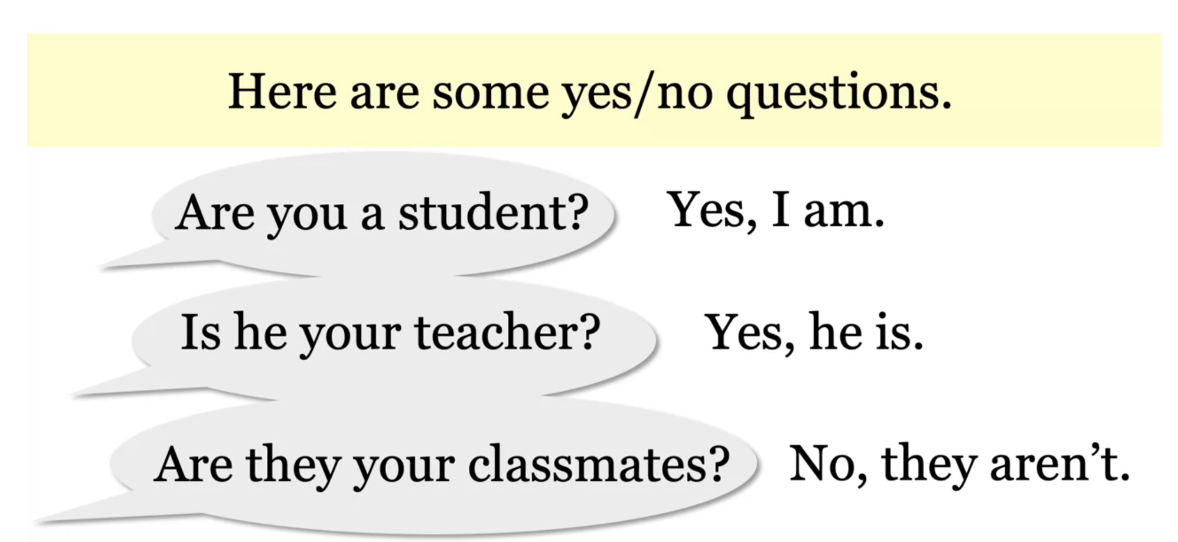
Form a question with BE. You already know how to
make a statement with BE. He is a musician. We start with the
subject. Here, it’s he. Then we have a form
of the BE verb. Here, we use is because is goes with he,
third-person singular. We have, he is a musician. To form a question, we just switch or reverse the order of
the subject and verb. He is changes to is he. Is he a musician? Yes, he is.

Let’s do it again. Form a question with BE. The statement here is, the trees are tall. The subject is trees
and the verb is are. When we want to make a question, we flip or reverse the order
of the subject and the verb. The trees are tall changes
to are the trees tall. Are the trees tall? Yes, they are.
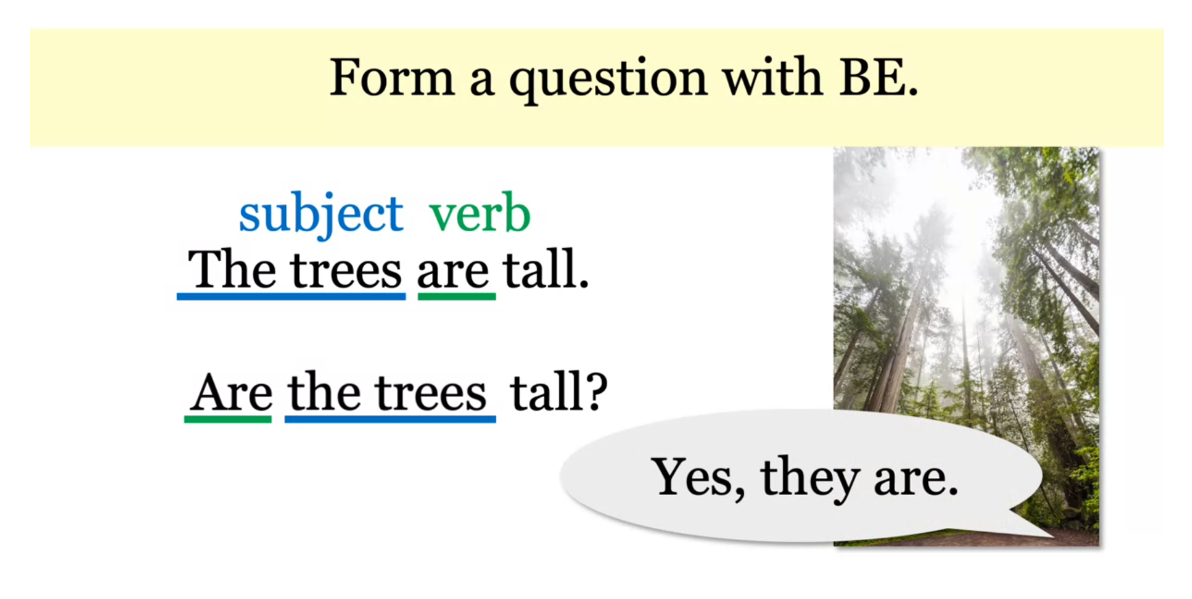
Let’s practice. Look at the answer. Jessica is at the airport. Jessica is the subject
and is is the verb. We reverse the order and we get, is Jessica at home? No, she isn’t. Jessica is at the
airport. Here’s another. What is the question? The answer is, the
water is cold. We want to reverse the order. Is the water warm? No, it isn’t. The water is cold.
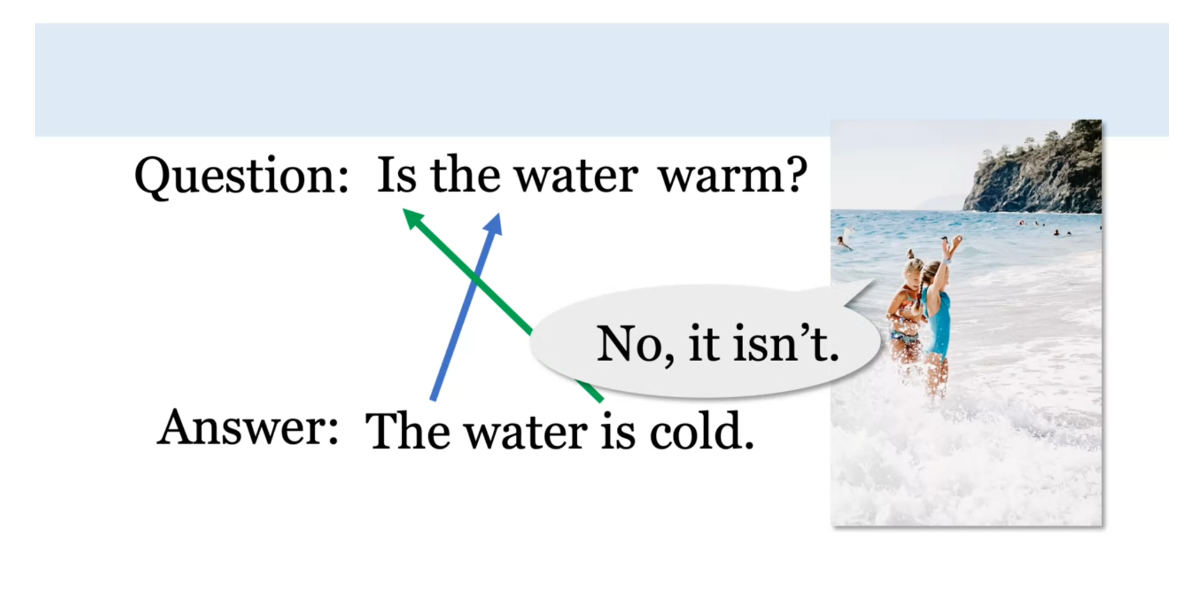
What’s the question here? The answer is,
Andrew is confused. The question is, is
Andrew confused? Yes, he is. Andrew is confused. Last one. Look at the answer. I am a teacher. What’s the question? Are you a teacher? Yes, I am. If you wrote the question, am I a teacher, that can also be correct, it’s possible, but usually, we don’t ask a question
about ourselves. Like, am I a teacher? Usually, it’s are you
a teacher? Yes, I am. We use short answers
for yes-no questions. These answers usually
have three words. Yes, I am. Yes, he is. Some of these answers
use contractions. No, they aren’t. You can say, no, they are not, of course, but we often use
contractions when we speak. We use short answers
for yes-no questions, but of course, you can
just answer yes or no. Sometimes, this is fine, and sometimes, it
sounds too short. Let’s look. Is
your name Rebecca? No. How about this? Is your name Rebecca? No, it isn’t. My name is Rachel. To answer yes, use
the subject and BE. Here’s our be chart again.
To form the short answer, just put yes and a comma in front of the subject
and the BE verb. Yes, I am. Yes, you are. Yes, he is. Yes,
she is. Yes, it is. Yes, we are. Yes, you
are. Yes, they are. These are the short answers
when you want to answer yes.

For no, use the subject
plus BE and then add not. Here’s the chart again. We add no to the front, a comma, and then
not at the end. No, I am not. No, you are not. No, he is not. No, she is not. No, it is not. No, we are not. No, you’re not.
No, they are not. These are the short
answers for the no answer.

But remember, we can
also use contractions. We use contractions
in the negative form. We use the same
contractions you know from the lesson about the
BE verb in the negative. Remember, there are three ways. The long way with the full
verb and the word not. The second way,
make a contraction with the pronoun
and the BE verb. The third way, make a contraction with
the BE verb and not. Let’s practice with
some short answers. Is the rose yellow? No. No, it is not. No, it’s not. No, it isn’t. It is red. All three of these
negative answers mean the exact same thing. It’s just your choice which
one do you want to use. Is an alligator dangerous? Yes, it is.
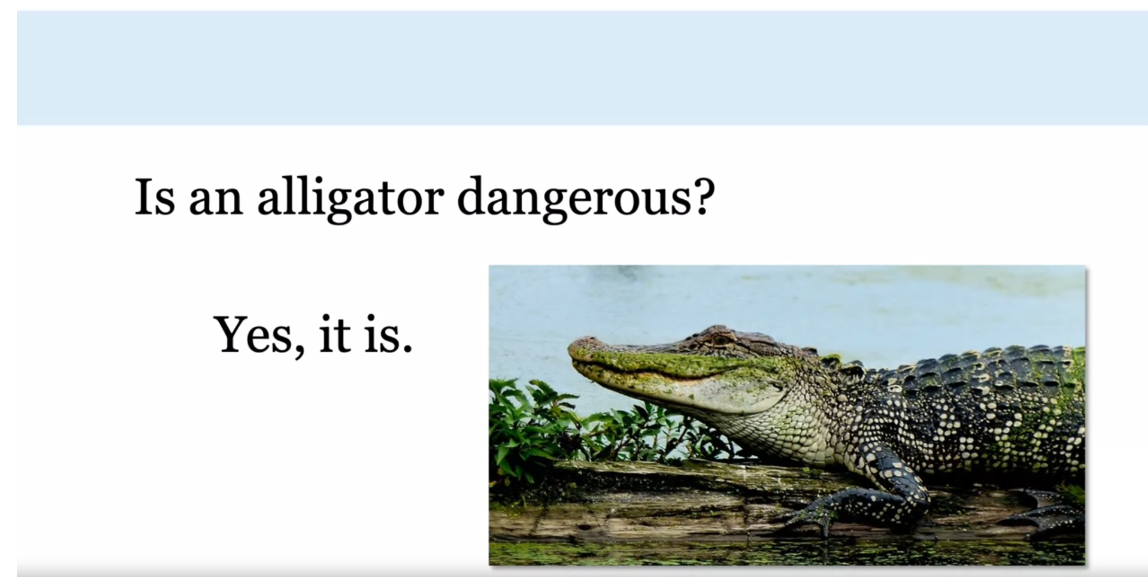
There’s
only one answer here because it is a yes answer. We can’t do all of those
contractions with a yes answer. Are they in class? No. No, they are not. No, they’re not. No, they aren’t. They’re in a coffee shop. Are puppies cute? Yes, they are. Maybe you want to
write yes, they’re, but this is incorrect
because we don’t make a contraction with those yes
answers. It doesn’t work.

Are apples healthy?
Yes, they are. Let’s check to see
what you understand. What is wrong with
this sentence? You tired? This is incorrect. There isn’t a verb here. The correct question
is, are you tired? We need the BE verb.
Are you tired? Yes, I am. What is wrong? Are you from
California? Yes, I’m. Don’t end a yes answer
with a contraction. This is incorrect. Are you from
California is perfect. Are you from California? Yes, I am.
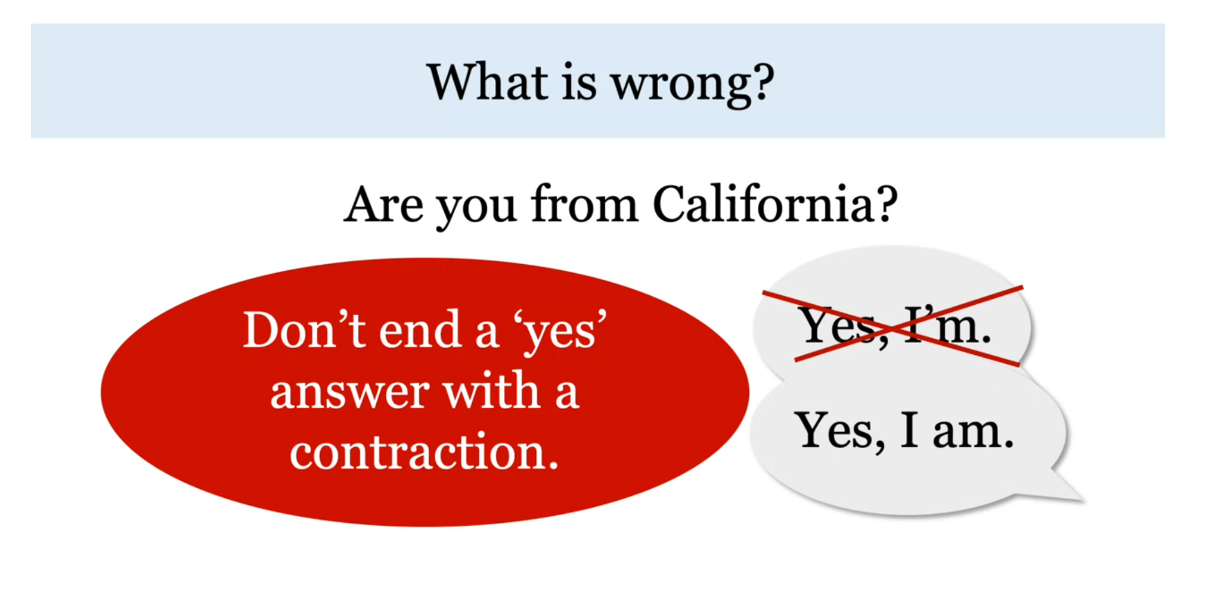
One more. What is wrong? She is at the library? No, she isn’t. She’s
at the bookstore. Right here, this is not
question word order. This is incorrect. We have to switch this
or reverse the order. Is she at the library? Is she at the library? No, she isn’t. She’s at the bookstore. In this lesson, you learned
to form a question with BE. We switched the word order. Is he confused? He is confused. The question is the reverse
order of the statement. Is he confused? Yes, he is. I hope you’re not confused.
Yes/No Questions BE (Practice Exercise)
Practice
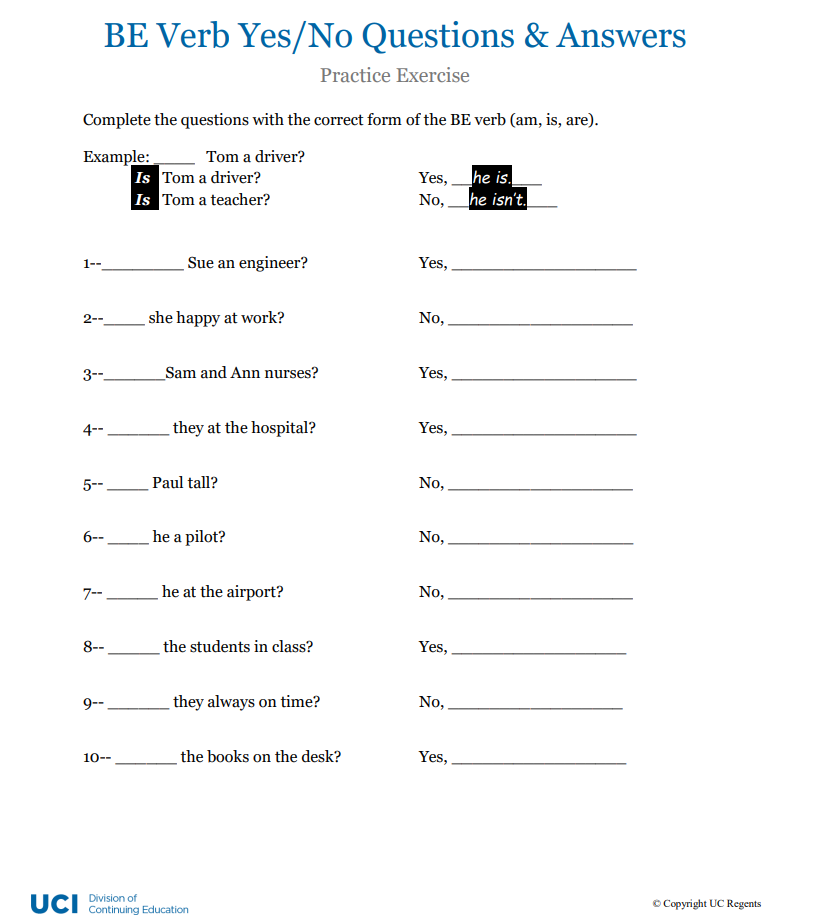
Answer
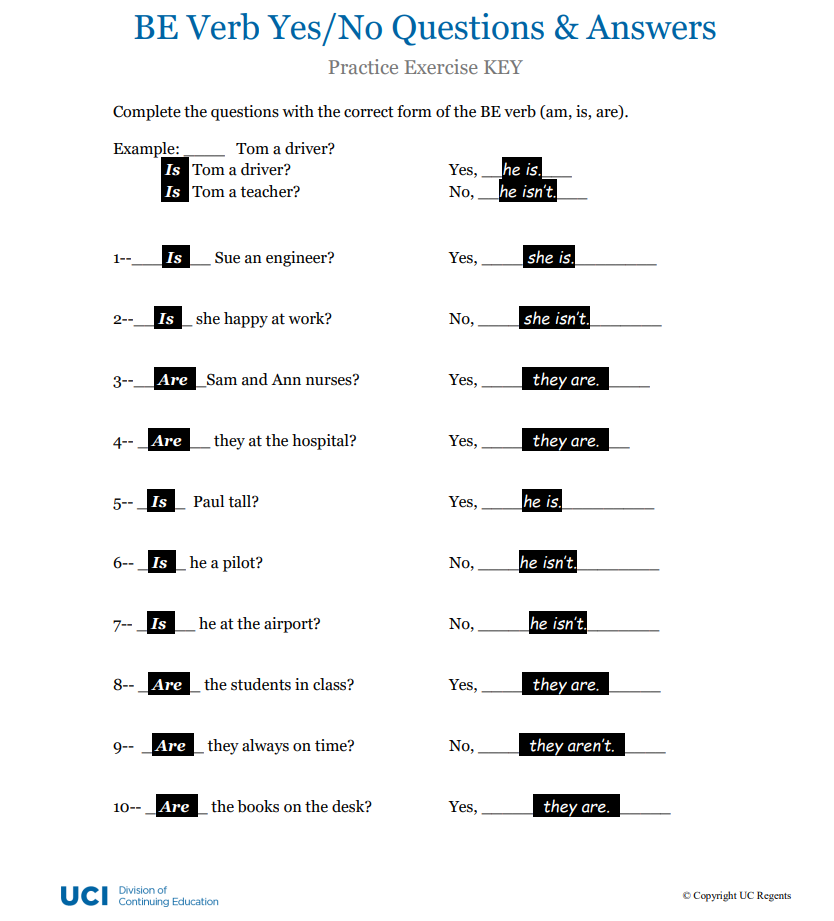
Is There? & Are There?
In this lesson, you will learn how to form questions with, is there and are there? First, I have some
questions about your town. Is it big or small? Is there a university? Is there a shopping center? Are there many places to eat? Are there parks,
and sports fields? Look at these questions. Is there a university? Are there many places to eat?
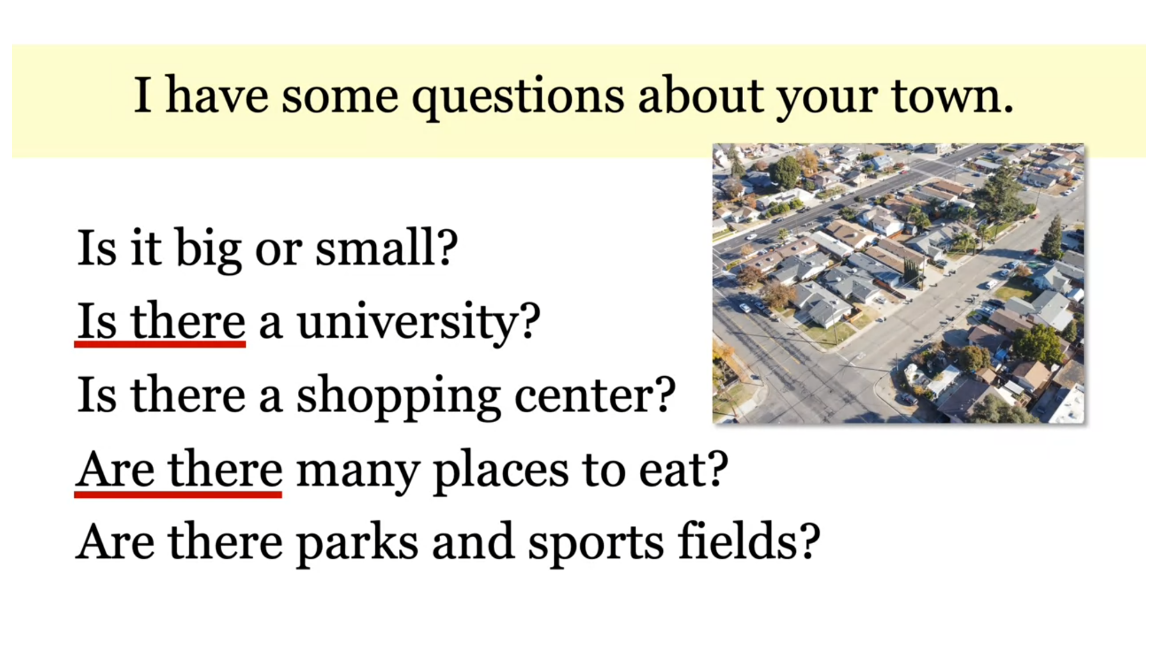
Let’s look at how to form
these kinds of questions. Remember, we use there is
and there are to describe. Here is a picture of a desk. There is a computer on the desk. There are books on the desk. These sentences
describe the desk. Remember, we look at the noun to decide what form of
the be verb we need. Here, computer is singular, so we use is. Here, books is plural, so we use are. Also remember, to form
a question with be, we switch the subject
and the verb. He is a musician,
is the sentence. Is he a musician? Yes, he is. To form a question with
there is or there are, you do the same thing. There is a computer on the desk, we are going to switch or
change the order of there is, and we have, is there a
computer on the desk? Yes, there is. There are books on the desk. Change or reverse the order. Are there books on the desk? Yes, there are.
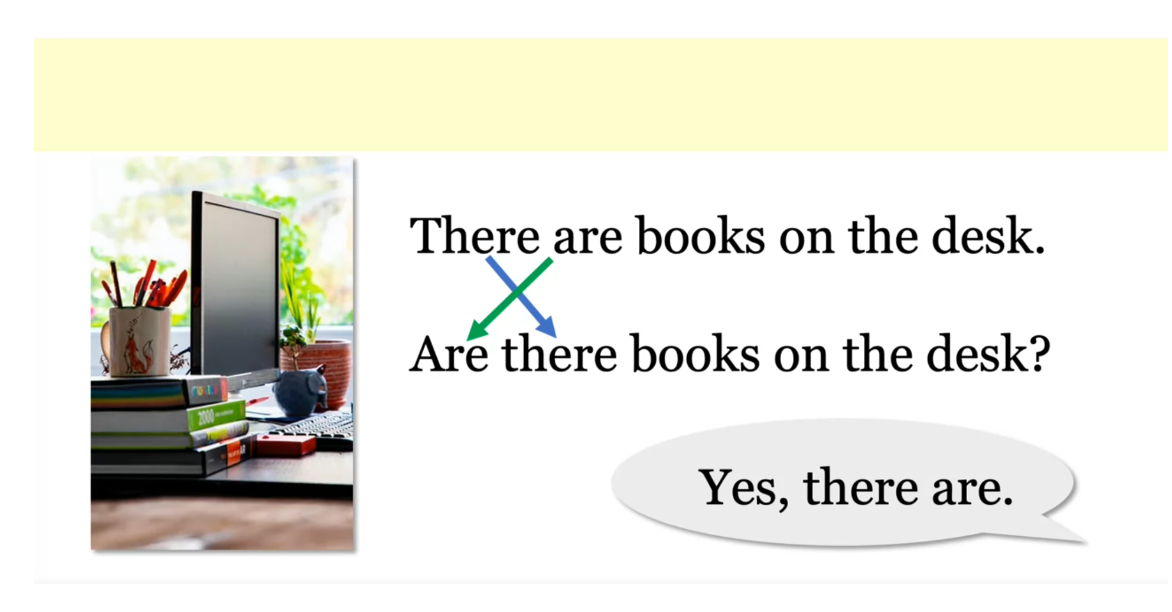
Let’s look at some
more examples. Are there nuts in the muffins? Yes, there are. There are walnuts
in the muffins.
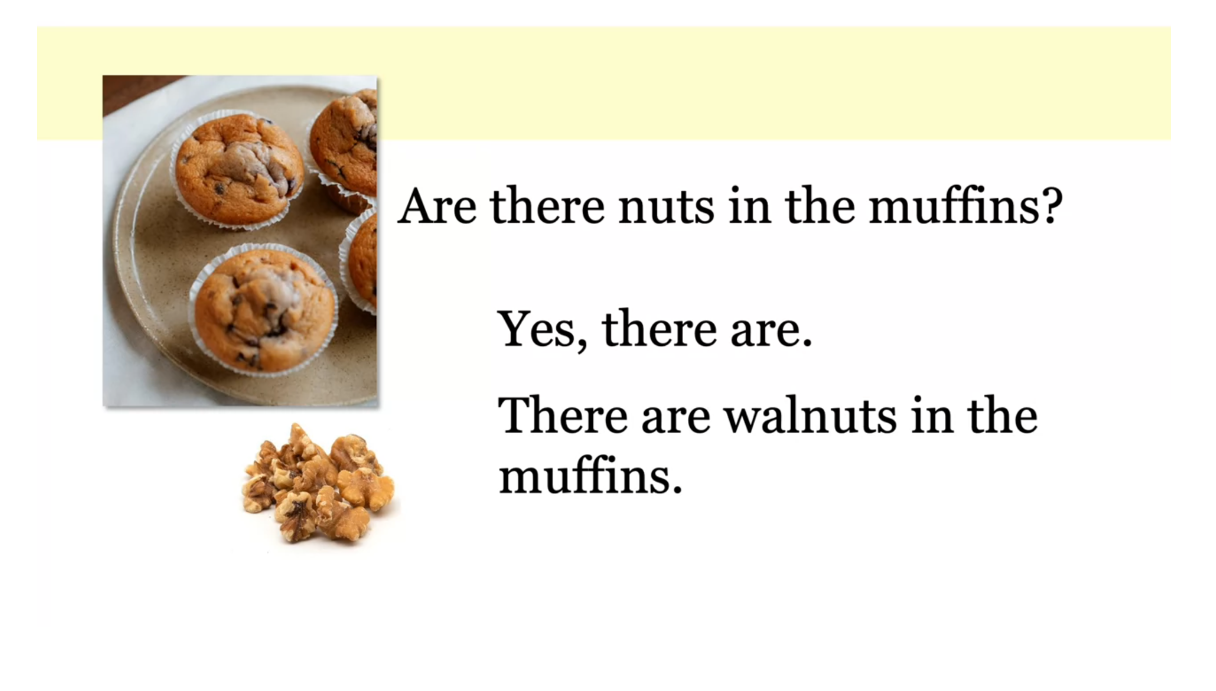
Is there a pool at the hotel? Yes, there is. There are two swimming
pools at the hotel. Are there washing
machines in the building? Yes, there are. There are washers and
dryers in each apartment.
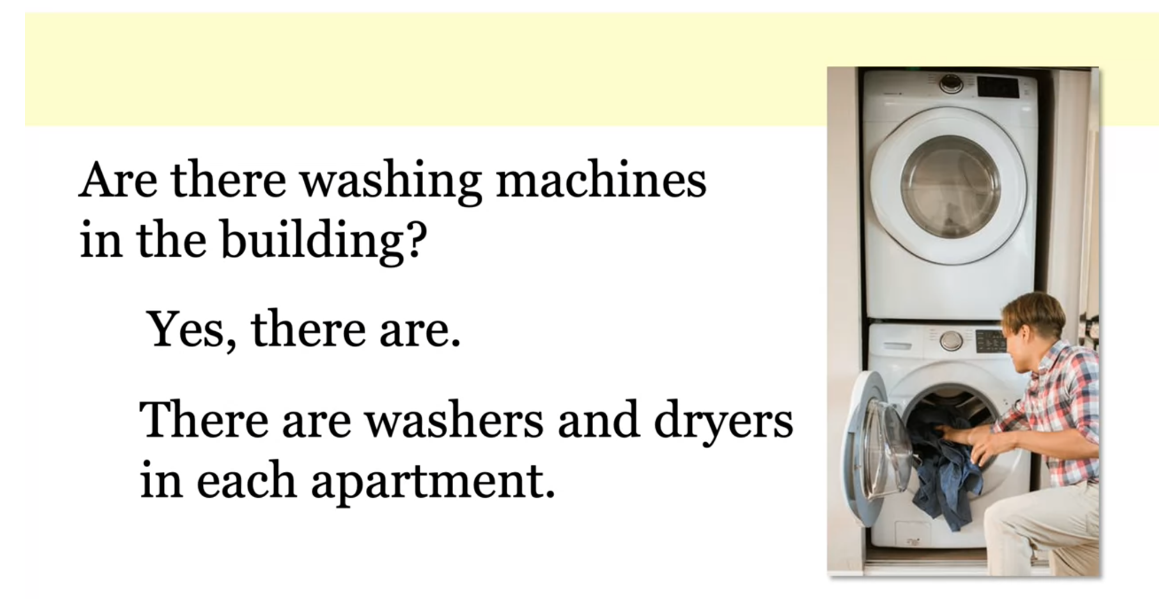
Is there a playground
at the park? No, there isn’t. There isn’t a playground. Now you try, look
at the question. What goes in the blank? Remember, for there
is and there are, we look to this noun
to decide is or are. What’s the question? Is there? Is there a
library on campus? Yes, there is. There is
a big library on campus.
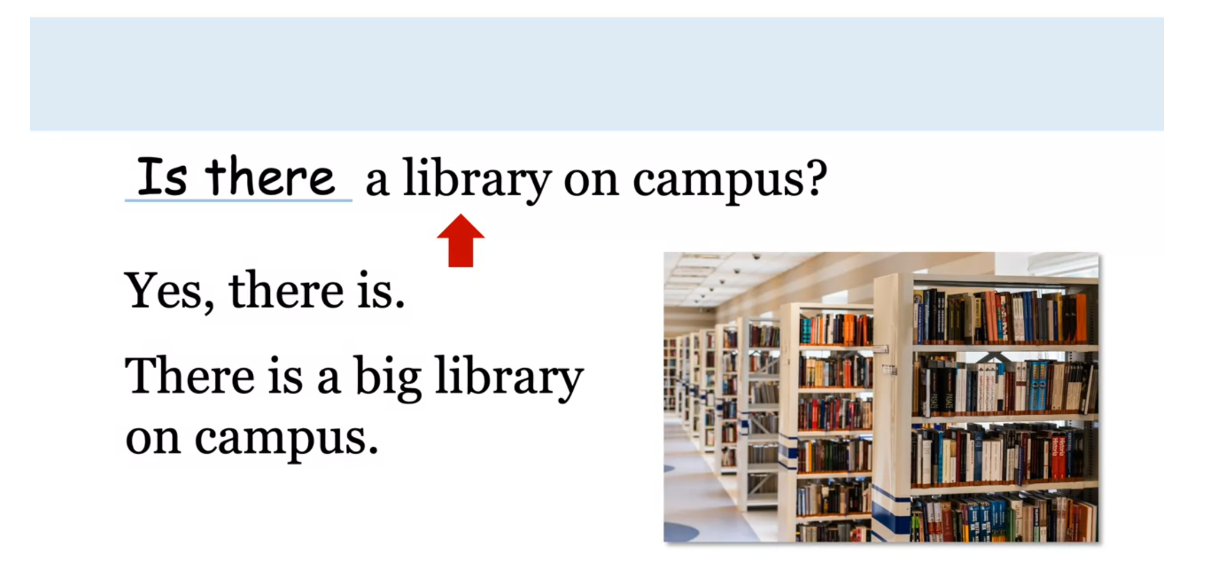
What goes in this
blank? Is there? Is there a television
in the room? No, there isn’t. The room has a desk and WiFi, but there isn’t a television. Last practice, what
goes in these blanks? Are there? Are there many
students in the class? Yes, there are. Are there any questions? No, there aren’t. Use is there, and are
there, to form questions. Is there a plant on the desk? Yes, there is. Are there pens in the cup? Yes, there are.
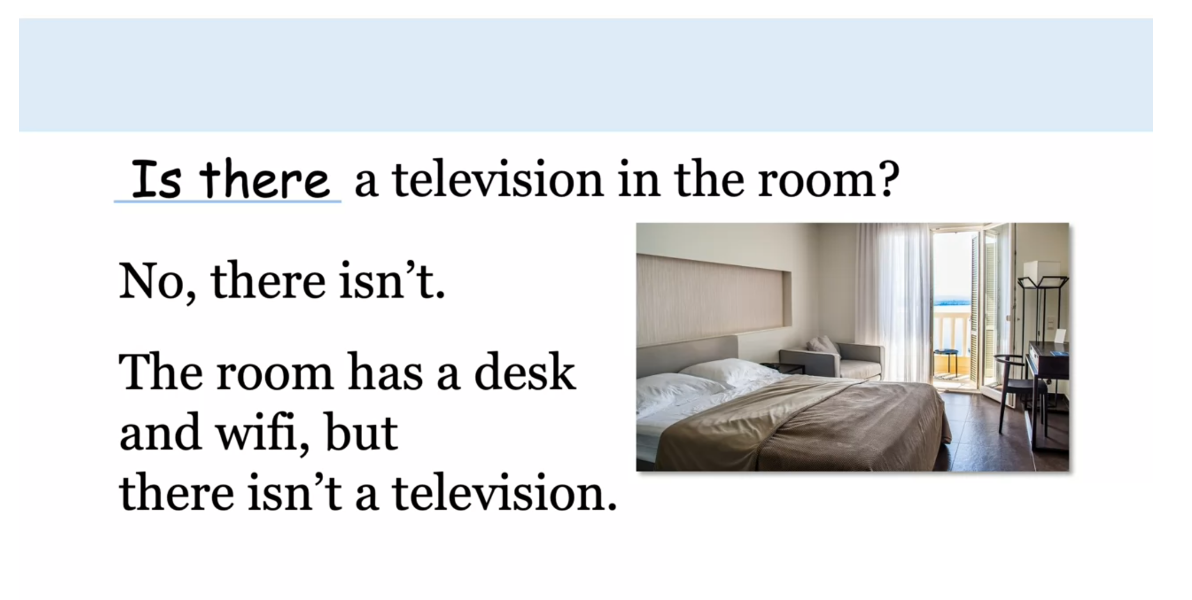
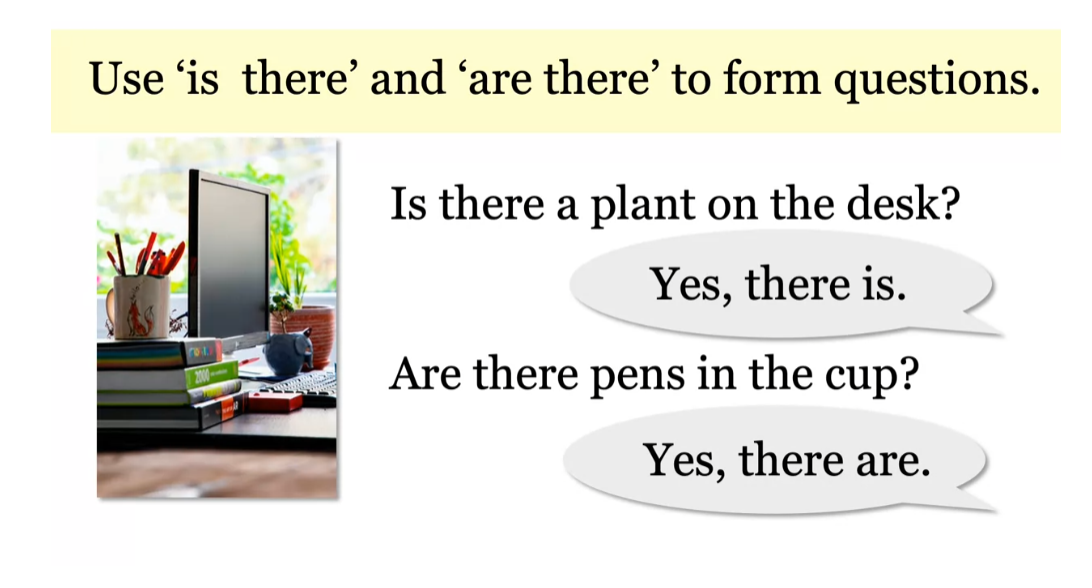
Is There? & Are There? (Practice Exercise)
Practice
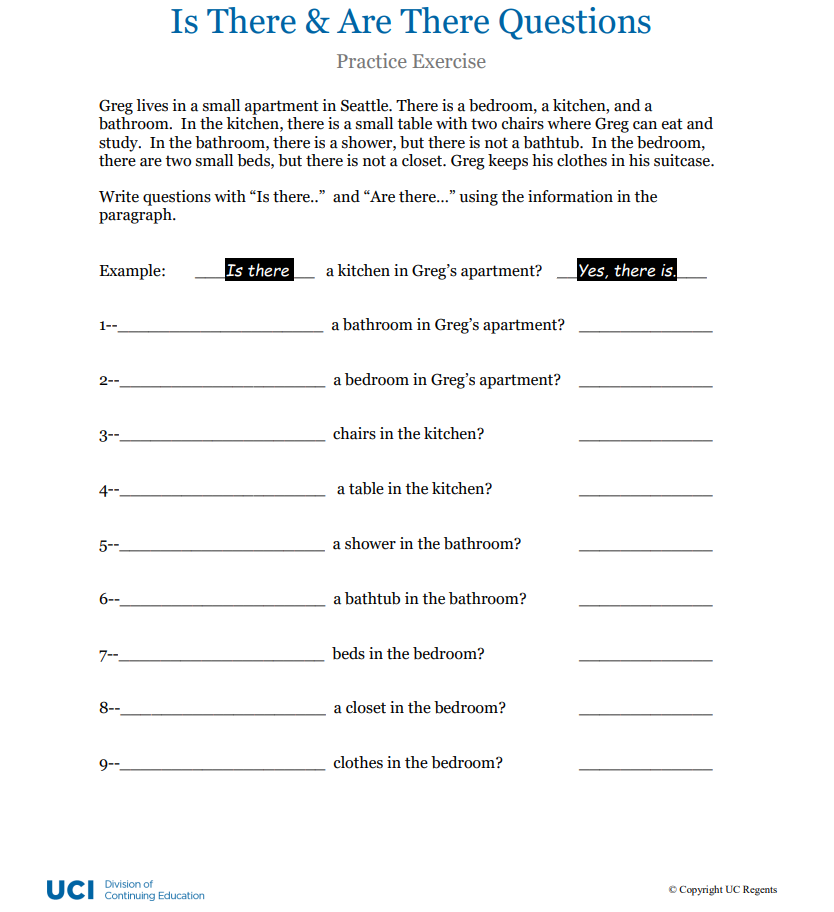
Answer
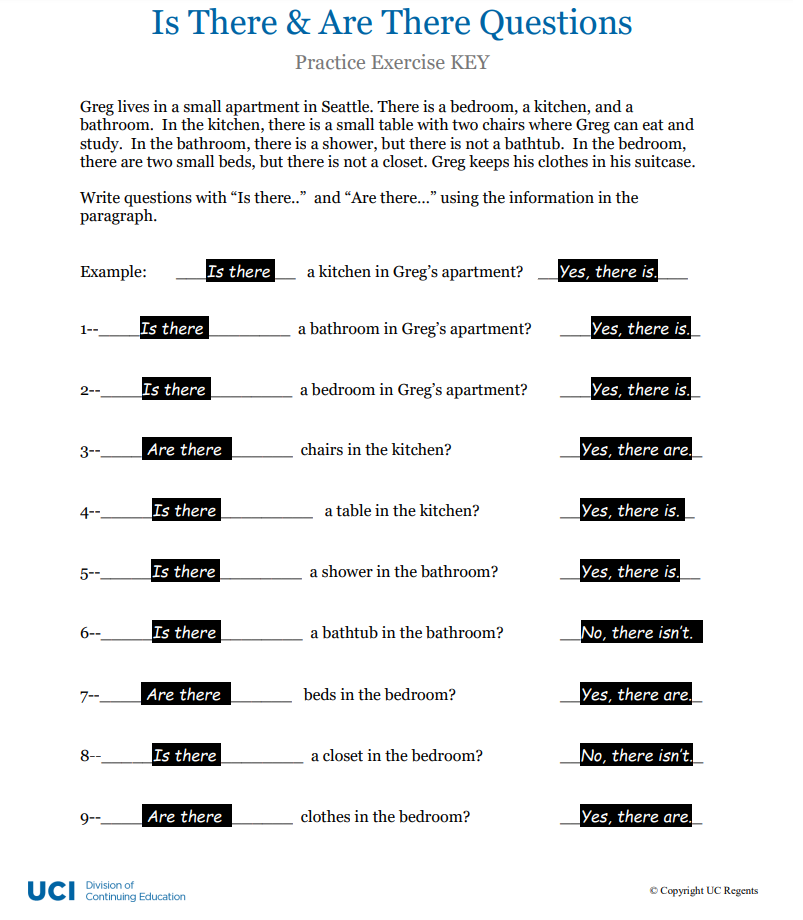
Yes/No Questions Simple Present
Yes/no questions simple present. In this lesson,
you will learn how to form yes/no questions with all verbs except for B. Use do or does to form questions. Here are some examples. Do you have a car? Do you like pizza? Do you speak english? Do you understand? Notice every question starts with do.

Use do and does to form
questions in the simple present. We do this for all verbs except for B. Look at the photo. I can ask the girl, is he your brother? The answer is yes or no, but
if I don’t see the brother, I want to ask her a different question. I want to use the verb
have to form a question. You know how to make this statement. You have a brother. Here is the subject, you,
and here is the verb, have. To form the question we just
add the word do in front. Do you have a brother? We don’t reverse the order like we
do with be yes and no questions. This is incorrect. We need to do. Do you have a brother?
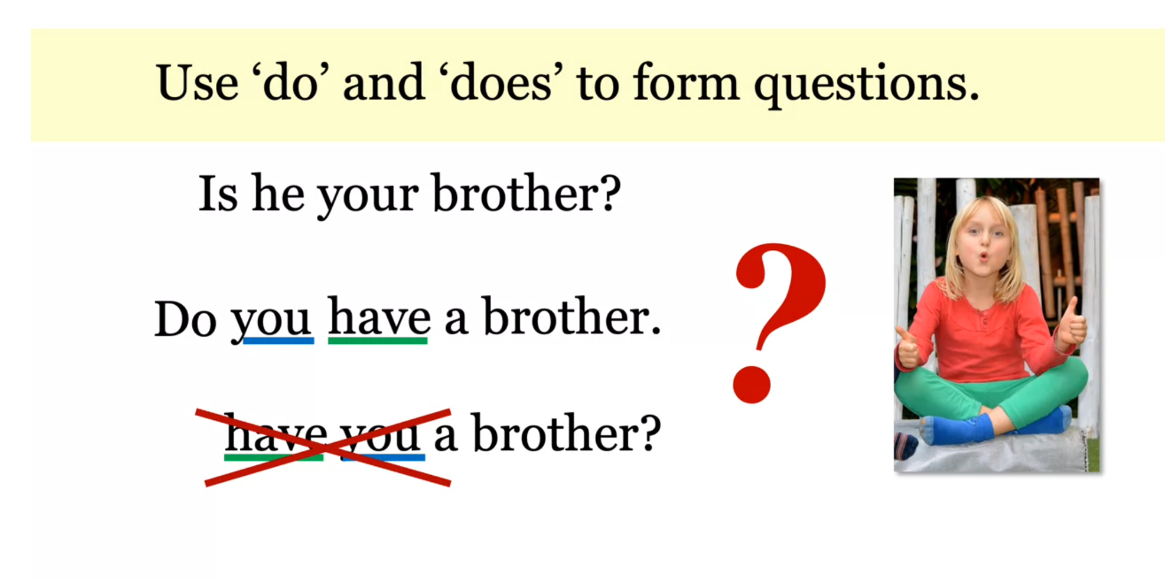
Remember the verb chart for do these are
the same forms we used to form questions. There are two forms do and does and you have to think these
are two form questions. They don’t mean the same as the verb do or
does as a main verb. Let’s look at some examples. Michael works at a high school. Remember we need this S on works because
Michael is third person singular. But look what happens when
we formed the question. Does Michael like his job? The S is on does now,
like does not need an S. It’s in simple form because
we only need one s. Does Michael like his job? Michael likes his job. And here you can see that S is back For
3rd person singular. There’s one s here And one s here.

Here’s some other examples of questions. The smith family has a new house. Does it have a garage? Does it have a garden? Does it have a pool? Does it have a fireplace? Do they like it? You can see does it, for singular,
and do they, for the plural the.
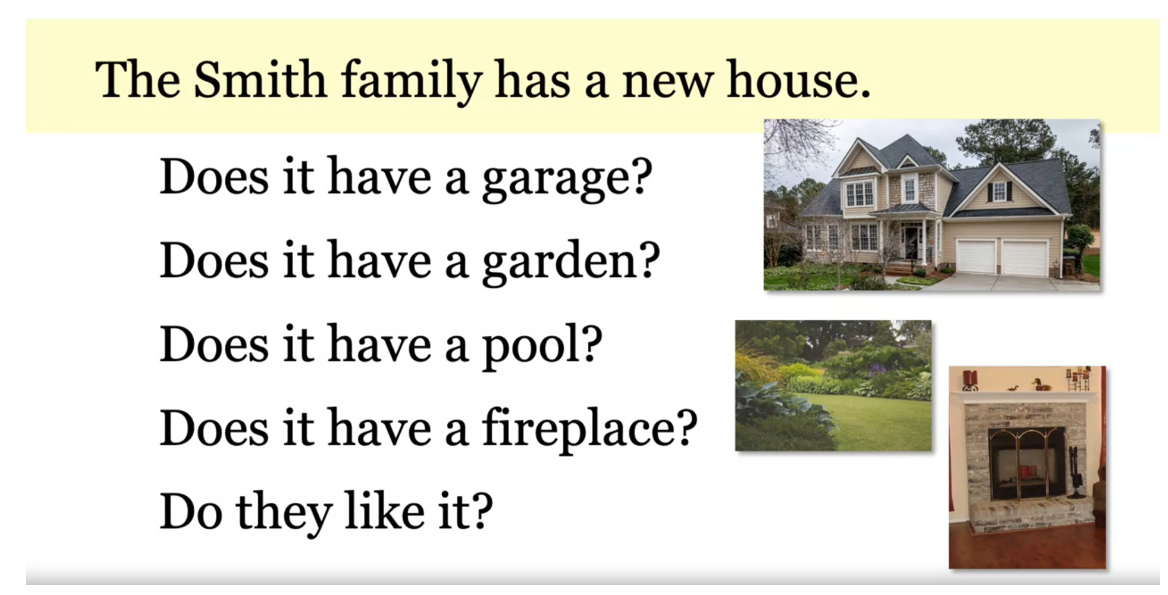
Brad and Grace go to South Lake school. Are they classmates? Do they use a computer at school? Do they work together? Do they like school? Notice the first question,
are they classmates? There’s no do or
does here because this is the be verb. But look at these other questions. They all have another verb use,
work and like. To make these questions,
we need the main verb use, work, like in the simple form and
a do at the beginning.
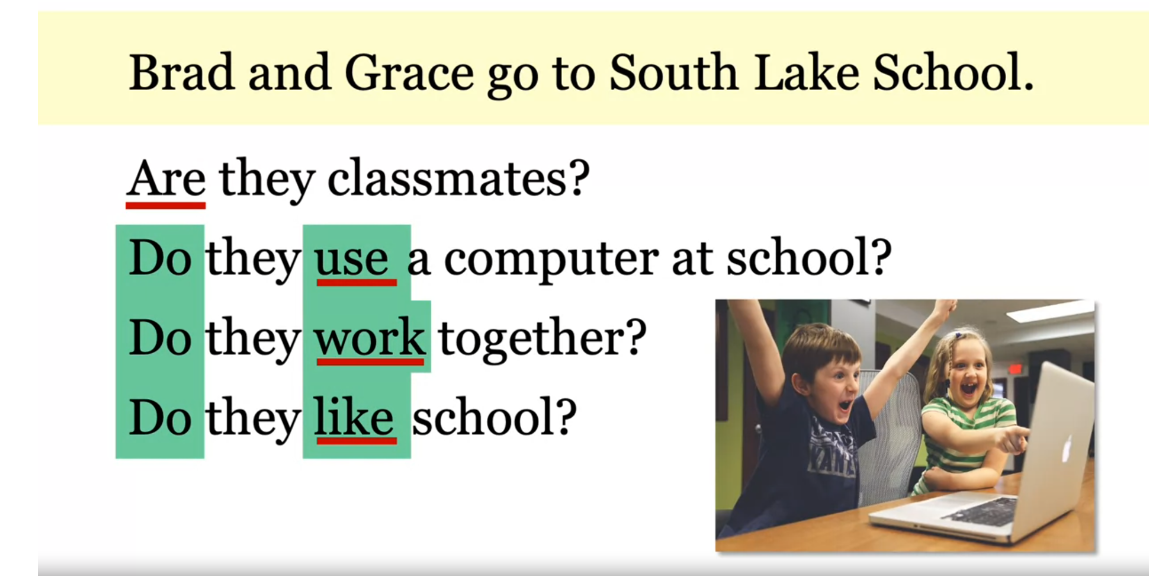
Let’s practice. You will see a sentence on the right. They play soccer. To make the question use do. Do they play soccer? Okay, now look we’ve got do and
the subject they and play. And if you look at the sentences together, do they play soccer is the same as they
play soccer with the do at the beginning. Form the question, here the sentence is. They have a new puppy. Okay, start with do
because do goes with they. Do they have a new puppy? And again you’ve got do subject and
the main verb in simple form. And you can see that they match up. Okay, one more form the question
this time the sentence is. She walks to class. Okay, I see an s and a she. So what is our first word? Does. Does she walk to class? Okay, let’s look when we match up these
sentences, we’ve got does and walk. Does she walk to class? And if we look through you can
see there’s an s on does and the s on walks, we only need one s. So do not put an s on the walk. And does she walk to class?
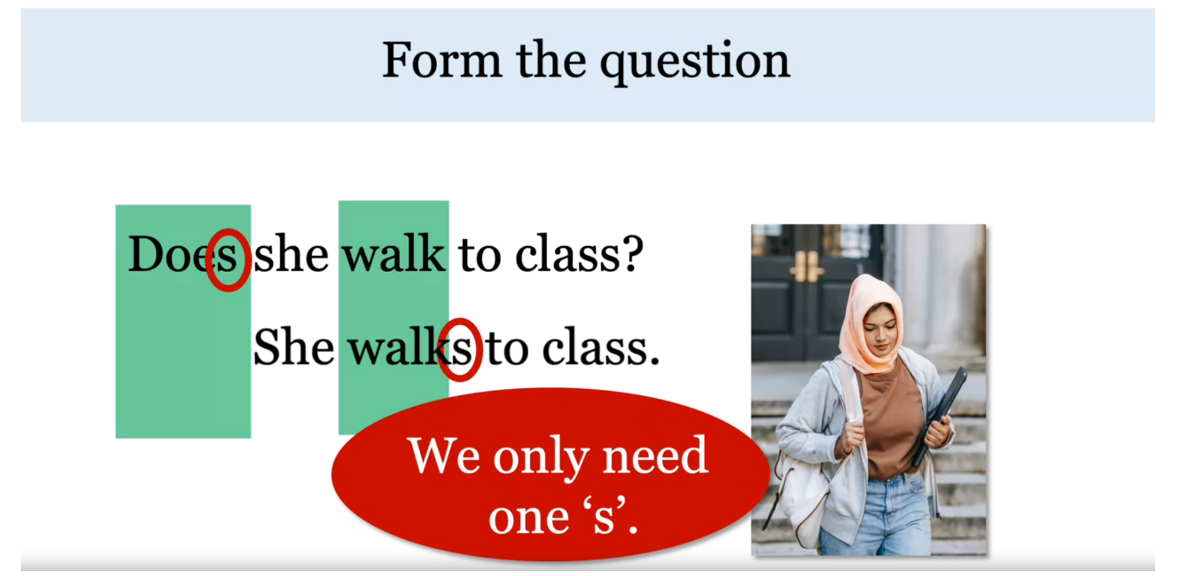
Okay, you know, do is a verb. Here’s a sentence. She does Yoga in the morning. Does here is the main verb. We say do yoga. Let’s make this a question. Does she do yoga in the morning? Okay, now we have does and
do and does is used to ask the question and
do is the main verb for yoga. So this does here is this
do in the question and this does here is just the does
that we use to ask the question. It can be confusing,
it may sound strange, but I can ask you. Do you do yoga? And now we have two dos in one sentence. But again,
the first do is to ask the question and the second do is the main verb.
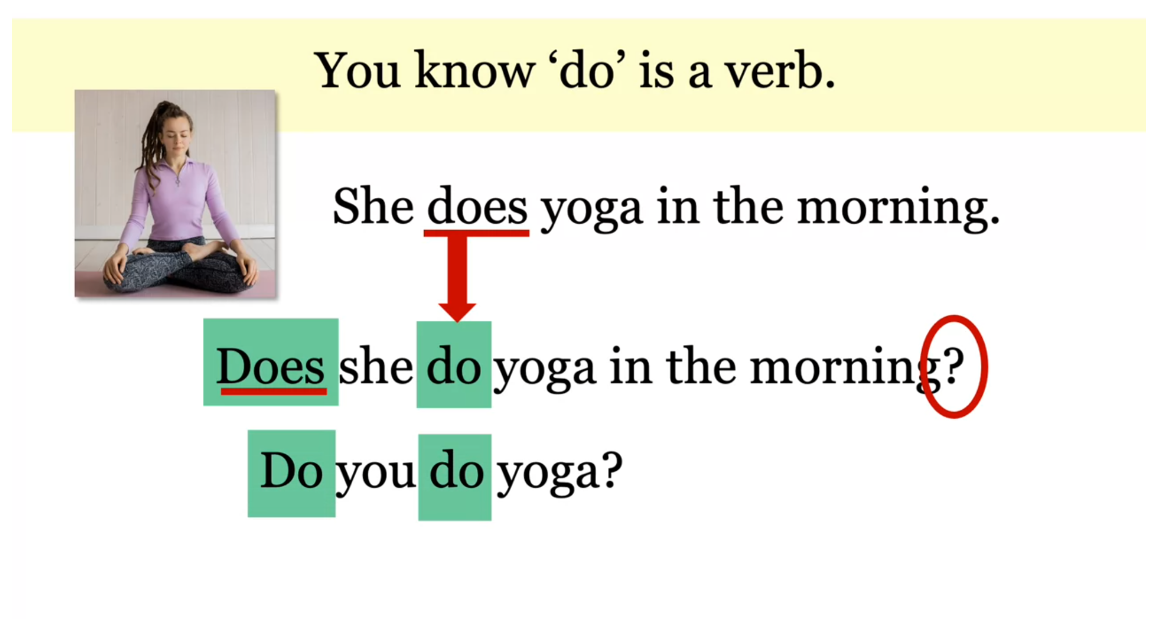
Let’s look at another example. She does homework after school. How do we make this a question? Does she do homework after school? Remember when we form a question we don’t
say does and does we only need one s. You try? What is the correct word
order to make a question? Big ears have, do elephants? Do elephants have big ears? Yes, they do. What is the correct word order for
the question? Does he drive to work? Does he drive to work? No, he doesn’t, he takes the subway.
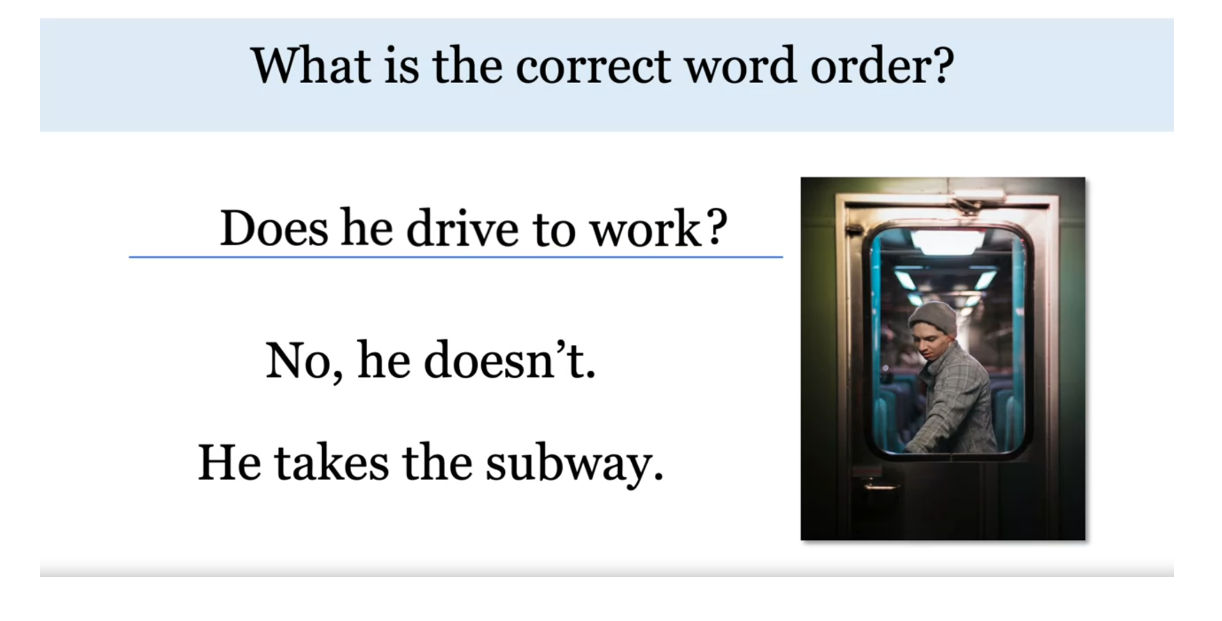
Okay, let’s see what you understand. Look at the sentence. Does Ann work? Think. Is this correct question
form does Ann work? Yes, that’s correct. Do tigers live in Asia? Yes, that is also correct. Does Mac likes rain? No. What’s wrong here? That’s right. We have an extra s we don’t need the s
on likes because we already have does. They play tennis? That sounds good but that is also wrong. They play tennis is not the correct
question form, there’s no do. This is actually just a sentence. They play tennis. The question is. Do they play tennis? Is he have a meeting? Is he have a meeting? Wrong. This is the wrong verb. We don’t want to be verb when
we have have in the question. There’s no does here, correct would be. Does he have a meeting? Do you understand? Yes, that is correct. I hope you understand. Okay.

Use do or does to form a question. Do you like your job? Does he like his job? Remember we need the do or does in front
and the verb stays in the simple form.
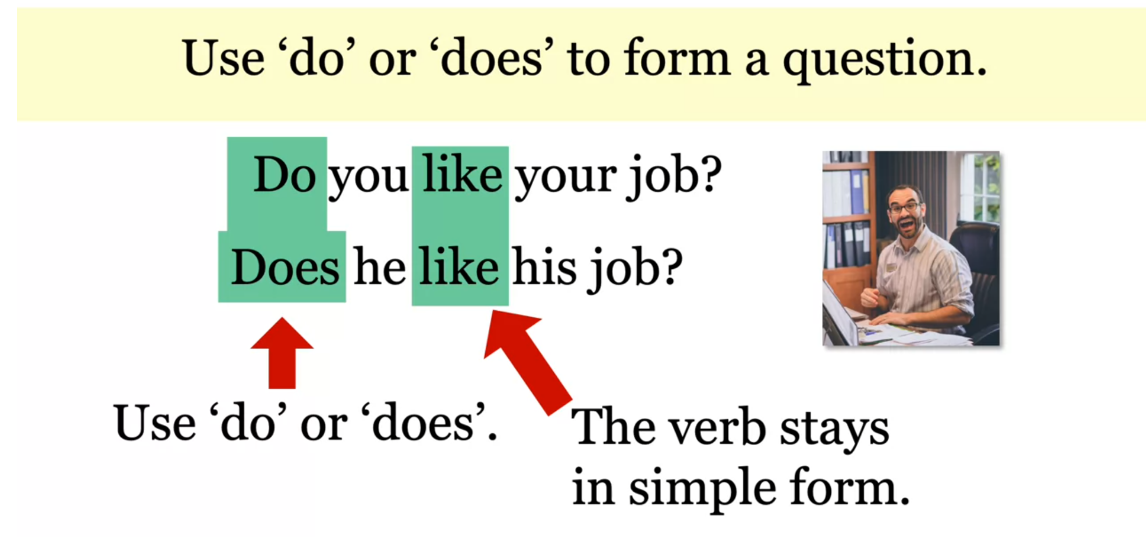
Yes/No Questions Simple Present (Practice Exercise)
Exercise:
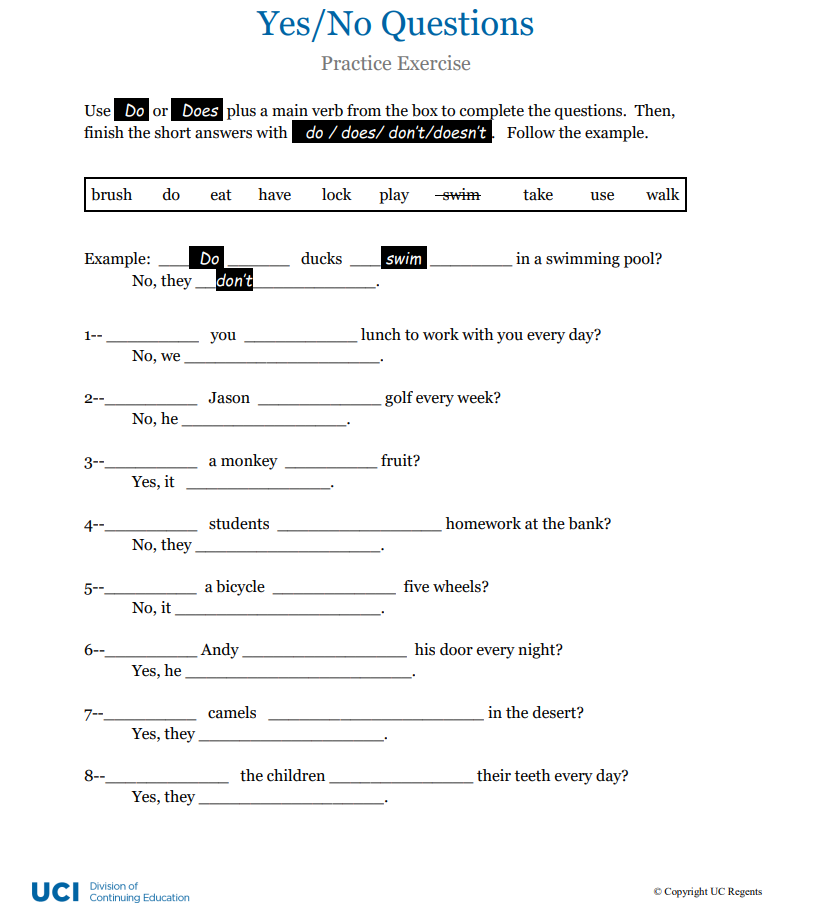
Answer
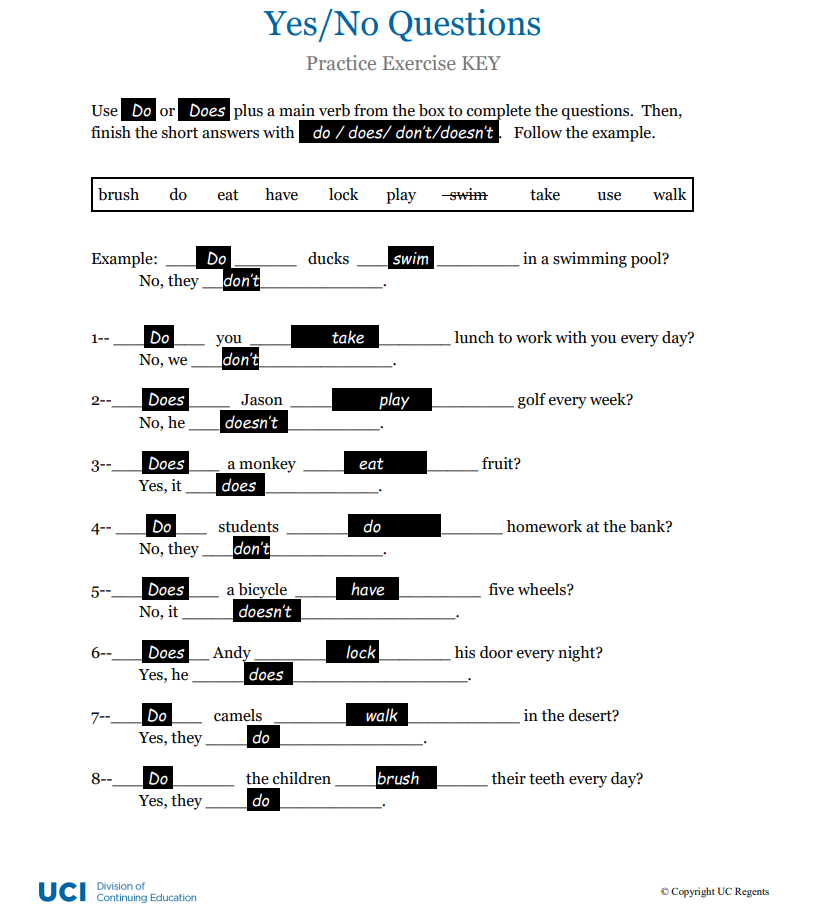
Quiz: Yes/No Questions
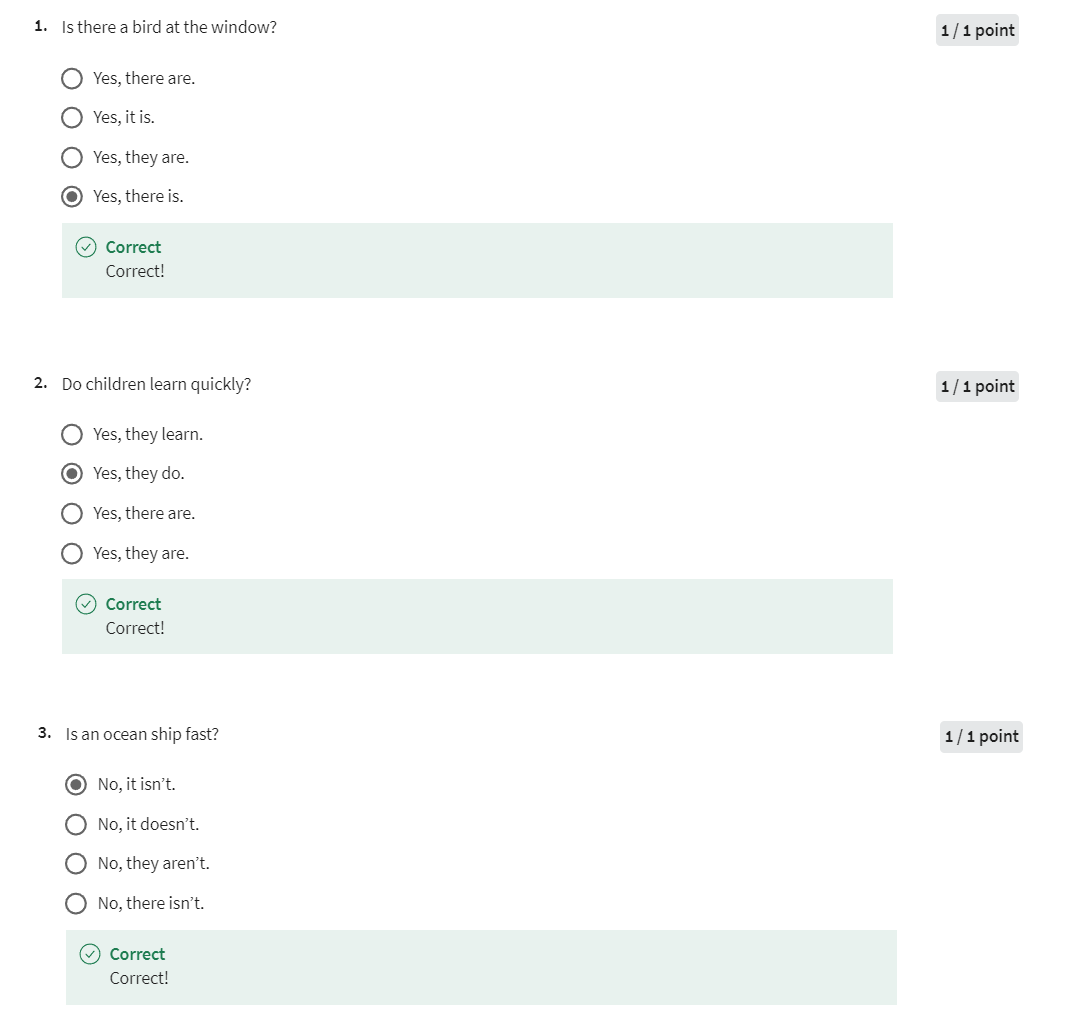
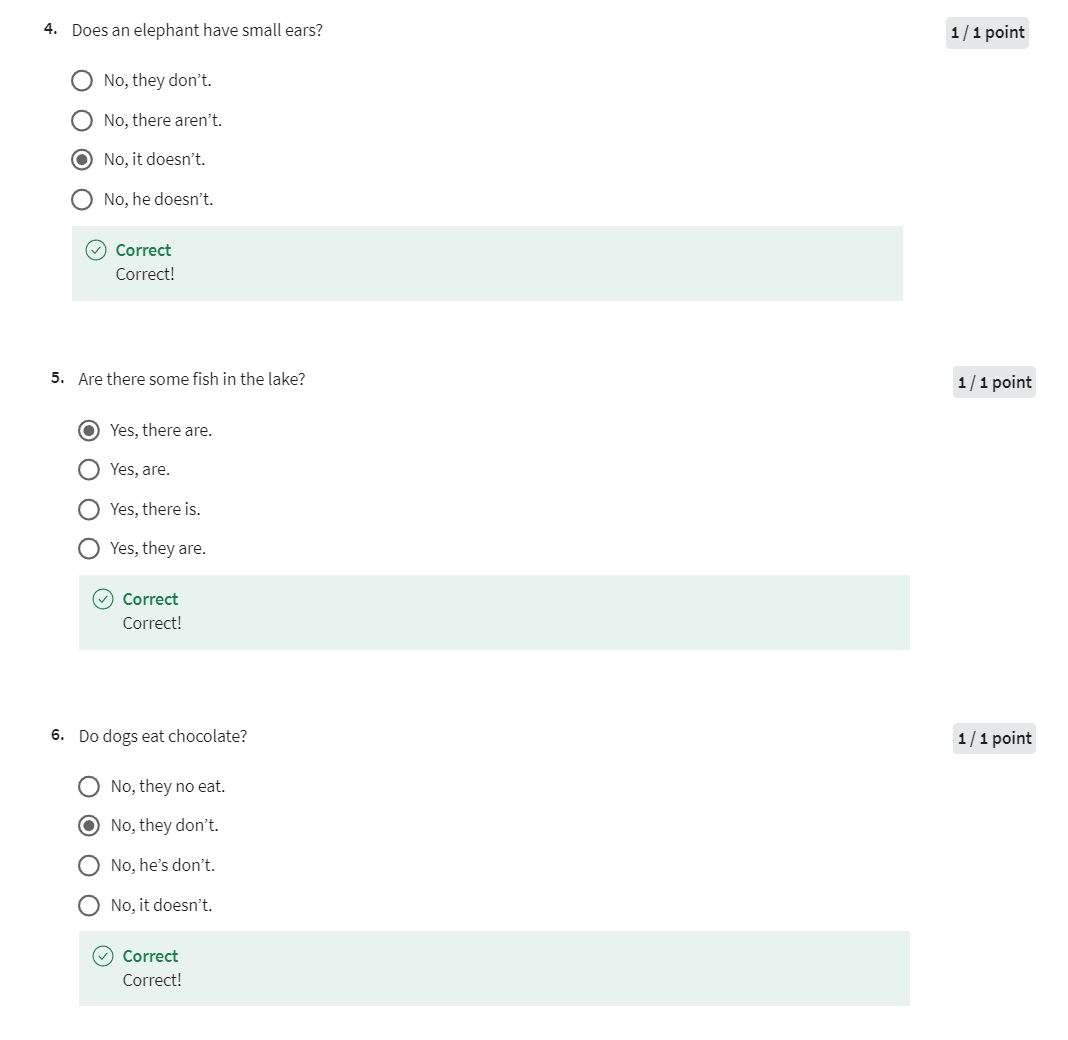
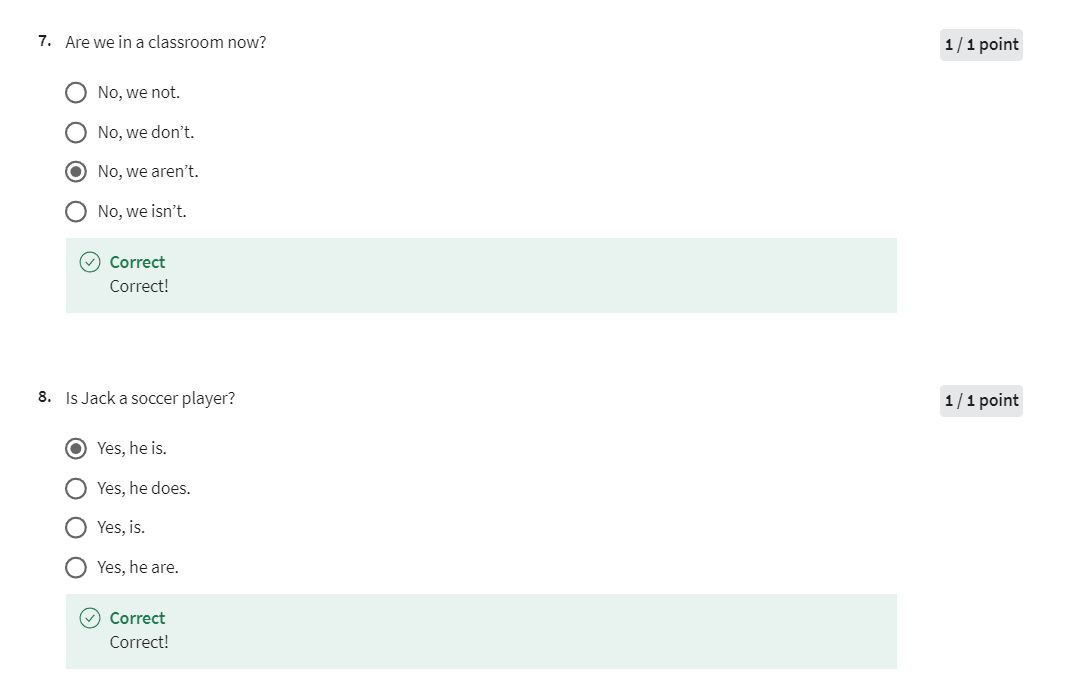
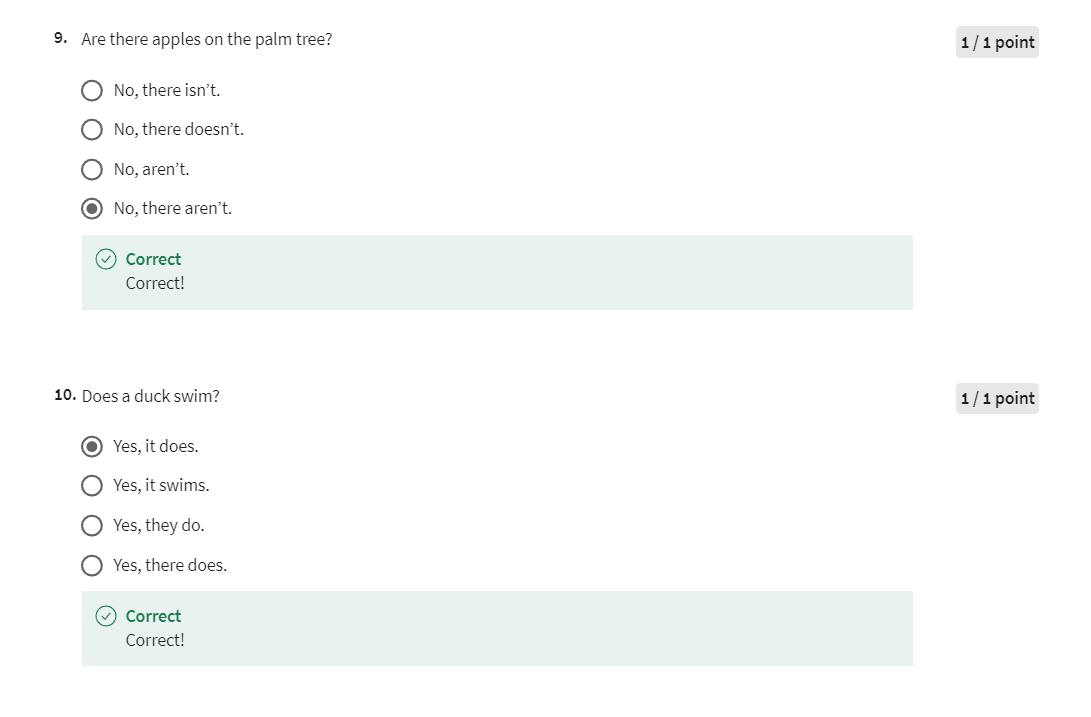
后记
2024年4月7日花费几个小时完成这门基础语法课,跟着加州大学欧文分校的老师学习英语语法,内容是全英的,算是重新刷新加固一下自己的根基。这个Specialization是很基础的,可以让小学生或者初中生跟学。我学习的目的是:学会如何用英文来描述这些语法知识点。



)







)







